Horizontal and Scout Carry is becoming a More Popular Way To Carry a Fixed Blade Knife on Your Belt
Here at Nothing But Knives we are constantly testing new horizontal and scout carry knives as they’re released. We’ve already added a new model to this article in 2024, and will add more as they’re released if we feel they make the cut (pun fully intended).
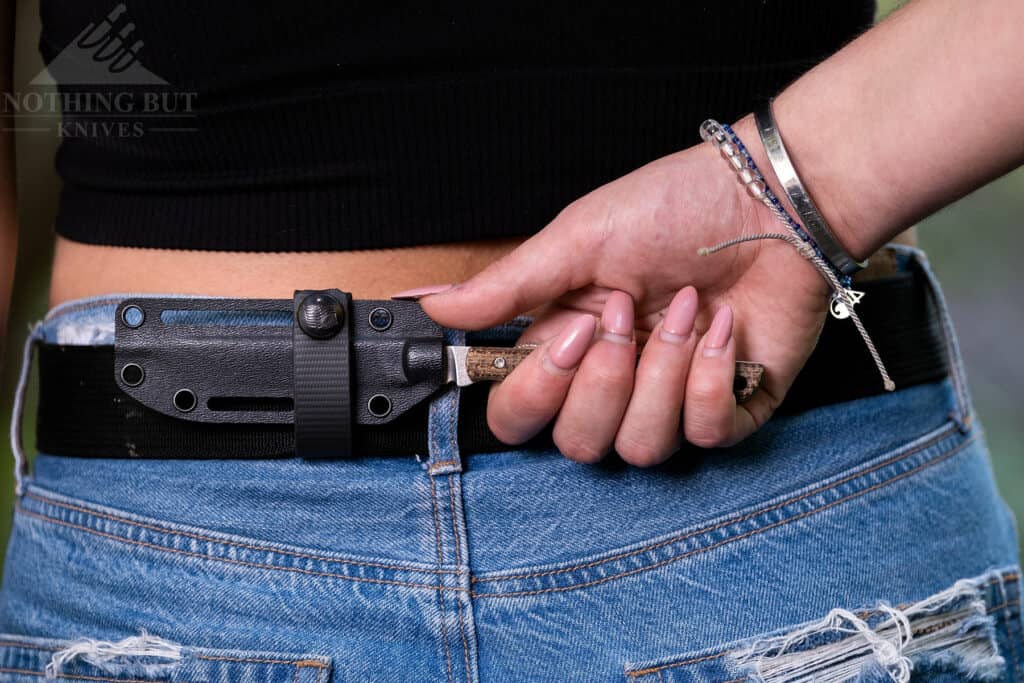
Most people equate the fixed blade horizontal carry style to some kind of tactical life decision when really it’s just a comfy life decision. Fashion statements aside, it’s a lot less awkward to take out a knife strapped across my left hip than it is to do the rocking butt dance to get at the folder in my right pocket.
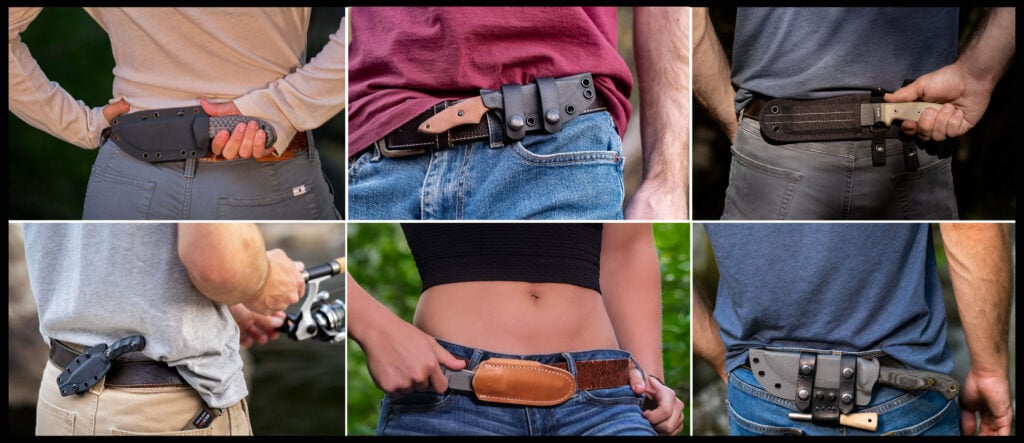
There are more sensible sounding reasons to scout carry a knife, or to put it in the cross-draw position on a belt. For us, it makes hiking a lot more pleasant because drop-carry knives tend to bounce and grate against our weirdly proportioned legs.
But there are also tactical and plain old EDC reasons for a horizontal carry fixed blade, so we’ve tried to keep this article separated by bushcraft/survival and tactical purposes.
You can also find an explanation of the various positions and solutions for carrying knives like MOLLE and Tek Loks at the end of this article.
Here are Our Current Top Horizontal and Scout Carry Knife Picks.
Survival / Bushcraft Fixed-Blades
Hiking and climbing is where carrying a knife horizontally shines for me.
I don’t climb trees, rocks, and cliff sides like I used to, but I know that a knife in the pocket or hanging from your belt onto your leg is annoying as hell, and sometimes dangerous, when you’re doing that. It’s important to have knives with stiff sheath retention and a sturdy build in those situations.
Bradford Guardian 3
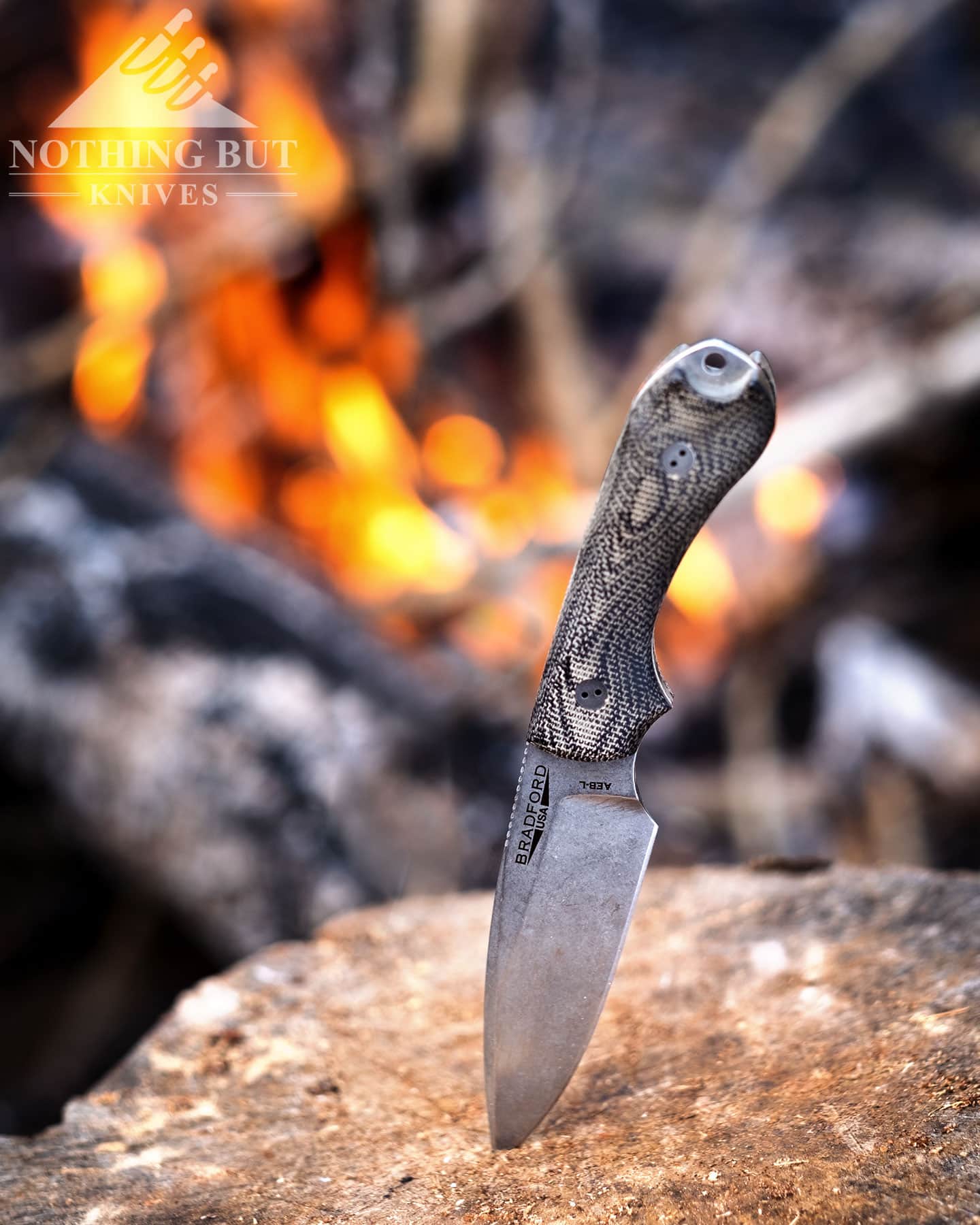
| Overall Length: | 6.75″ |
| Blade Length: | 3.5″ |
| Blade Steel: | M390, N690, AEB-L, or D2 |
| Blade Style: | Drop point |
| Blade Grind: | Flat |
| Handle Material: | Micarta or G-10 |
| Sheath: | Leather |
| Made in: | USA |
This is easily one of the most popular knives, not just for horizontal carry, but for survival and fixed-blade EDC in general. If you breathe you probably know about Bradford Knives by now. I’m mostly including it here out of obligation.
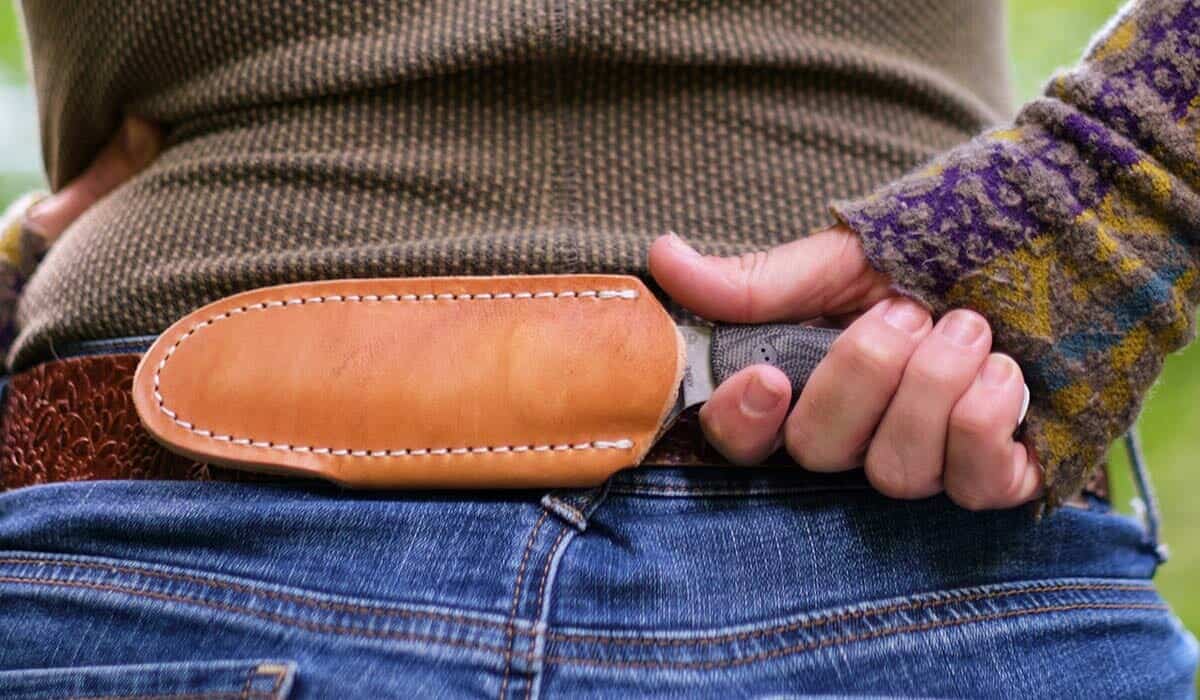
It’s starting to feel like no list of fixed-blade knives will be complete without the Guardian 3, no matter how specific it is. But let’s do the review dance anyway: The Guardian 3 is a pretty simple survival knife (the best ones usually are), but there’s an odd number of straight lines to it.
A spear point and a flat grind make for some straightforward sharpening, and certainly make it a nice hunting knife. It really shines with its leather sheath, though. The leather looks nice, of course, but best of all is it holds, and the belt loop is good and snug.
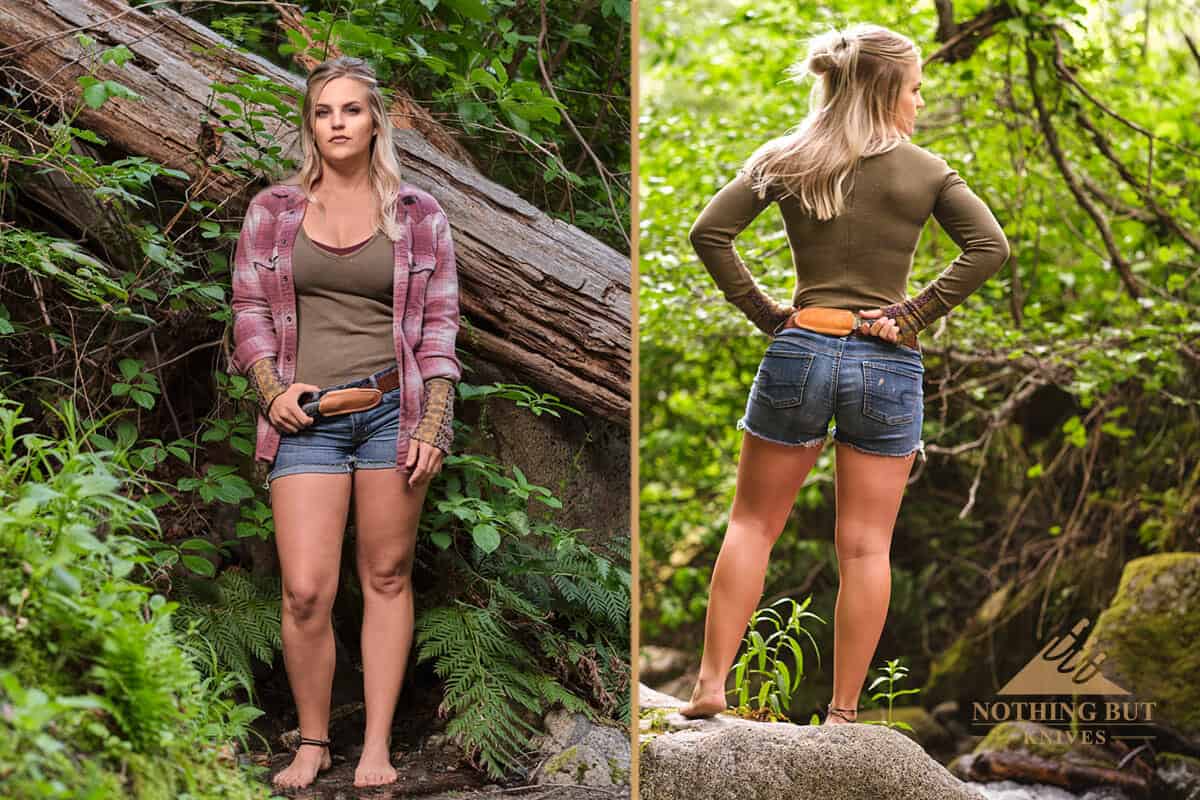
About the Sheath
The Guardian 3 sheath pictured above is really easy to change between cross-draw carry or scout carry. The knife can just be flipped around in its sheath and you are good to go. You can’t wear the sheath in the vertical carry position since the belt loop is a stitched-in leather strap, but Bradford makes some great Kydex sheaths for this knife that are little more versatile.
Click here to read our in-depth hands on review of the Bradford Guardian.
Vosteed Mink
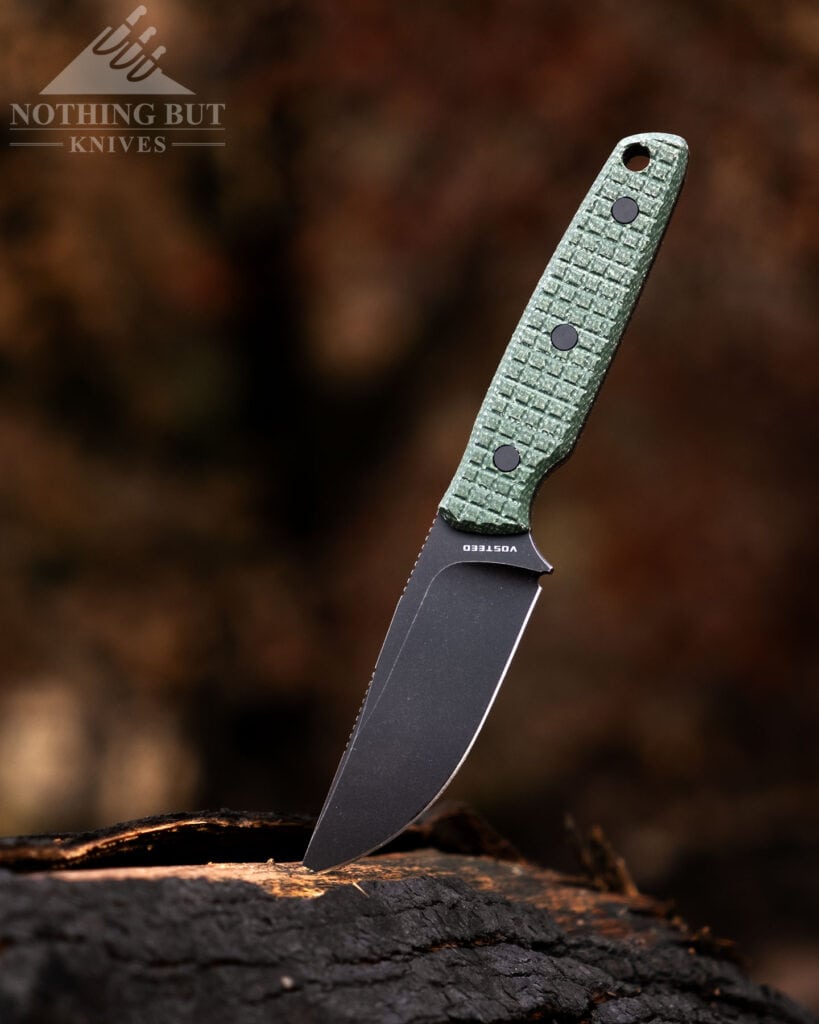
| Overall Length: | 7.13″ |
| Blade Length: | 3.33″ |
| Blade Steel: | Nitro-V |
| Blade Style: | Clip Point |
| Blade Grind: | Flat |
| Handle Material: | Micarta |
| Sheath: | Kydex |
| Made in: | China |
The Mink is a knife I have been excited about for quite a while. I first handled a prototype version of it at Blade Show in 2022. It impressed me at the time, and the final version is even better.
It’s a lightweight and comfy little thing that makes a handy backpacking, fishing or camping knife. It is also a great small game hunting knife.
The durable clip point blade has handled everything I threw at it in the week or so that I have been carrying it, but its the handle that steals the show. It is so comfortable; it feels like an extension of my hand when I am using it. The textured handles stay grippy in the elements, so if you need a knife for wet weather, the Mink is a good option.
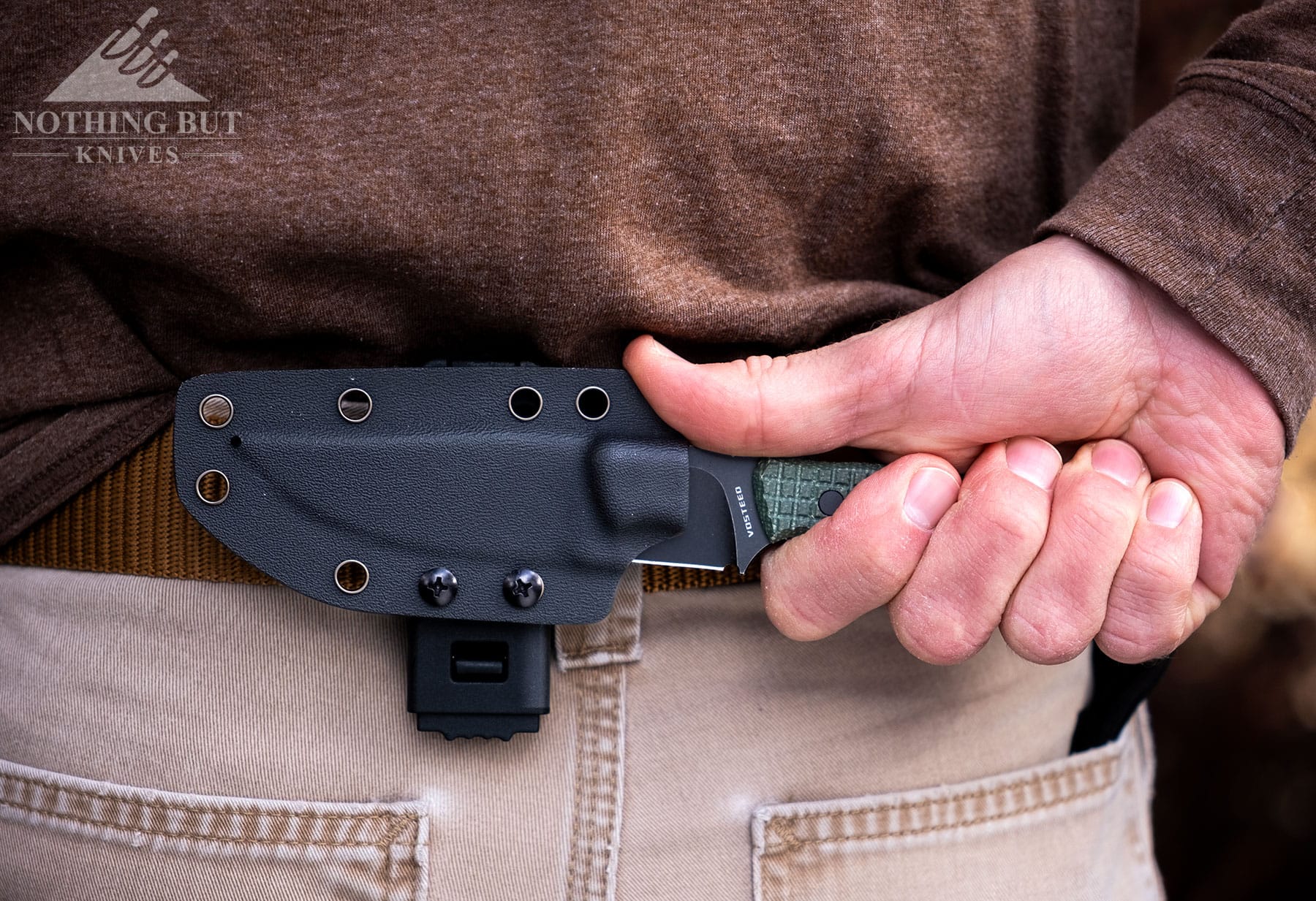
About the Sheath
It ships with versatile sheath that can be configured for right or left vertical or horizontal carry. This sheath is similar to several of the other kydex sheaths in this article, but this one can be adjusted with a Phillips screwdriver rather than some weird hex driver that nobody ever has on a camping trip.
The sheath holds the knife snugly with no rattle, and it’s easy to draw and re-insert the knife one handed with a little practice.
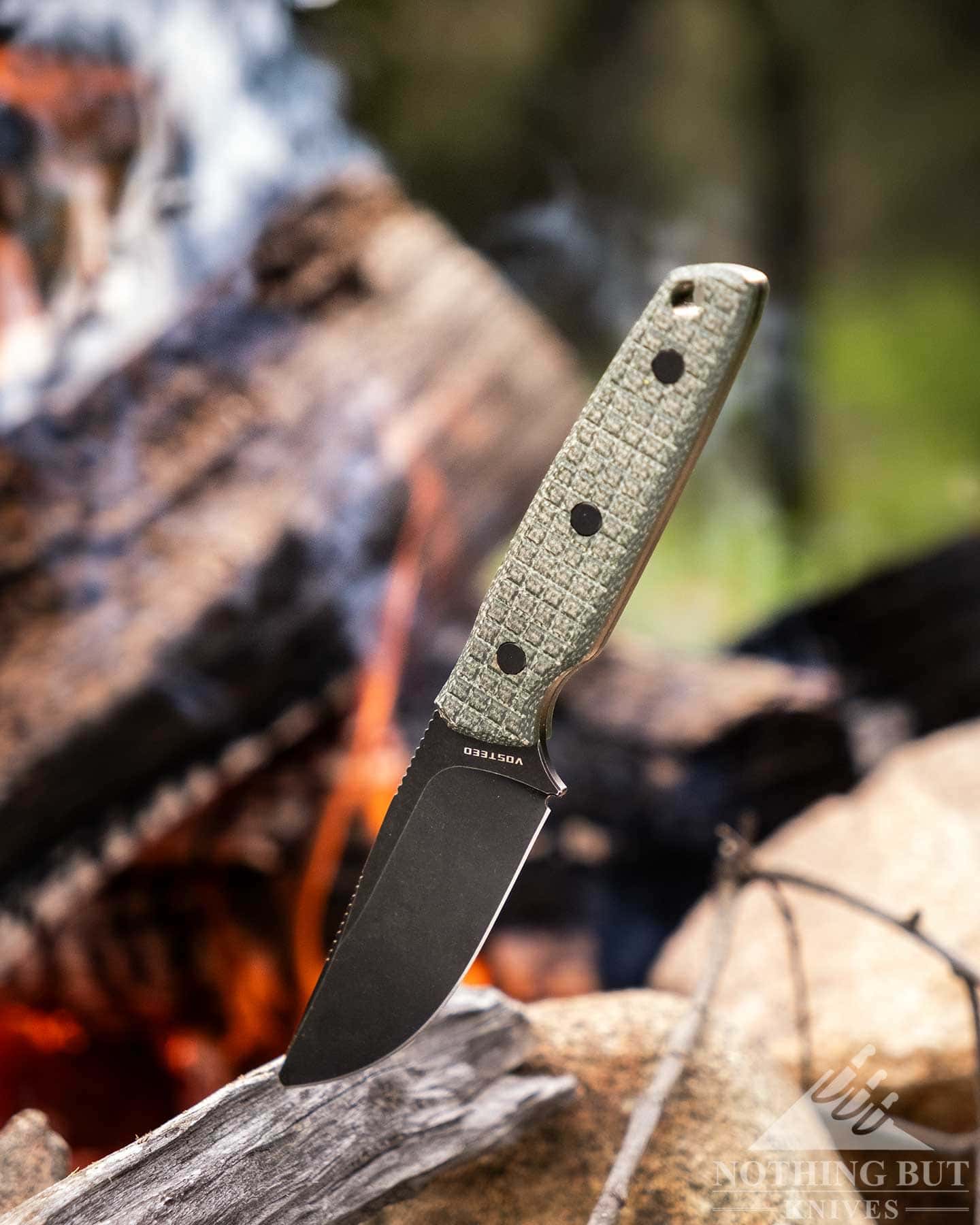
My only complaint about it is how high the sheath rides on the hip when carried vertically. This is a common problem with small, fixed blade EDC knives. Hopefully Vosteed will offer a drop-down attachment at some point in the future.
Bonds Creek Badger
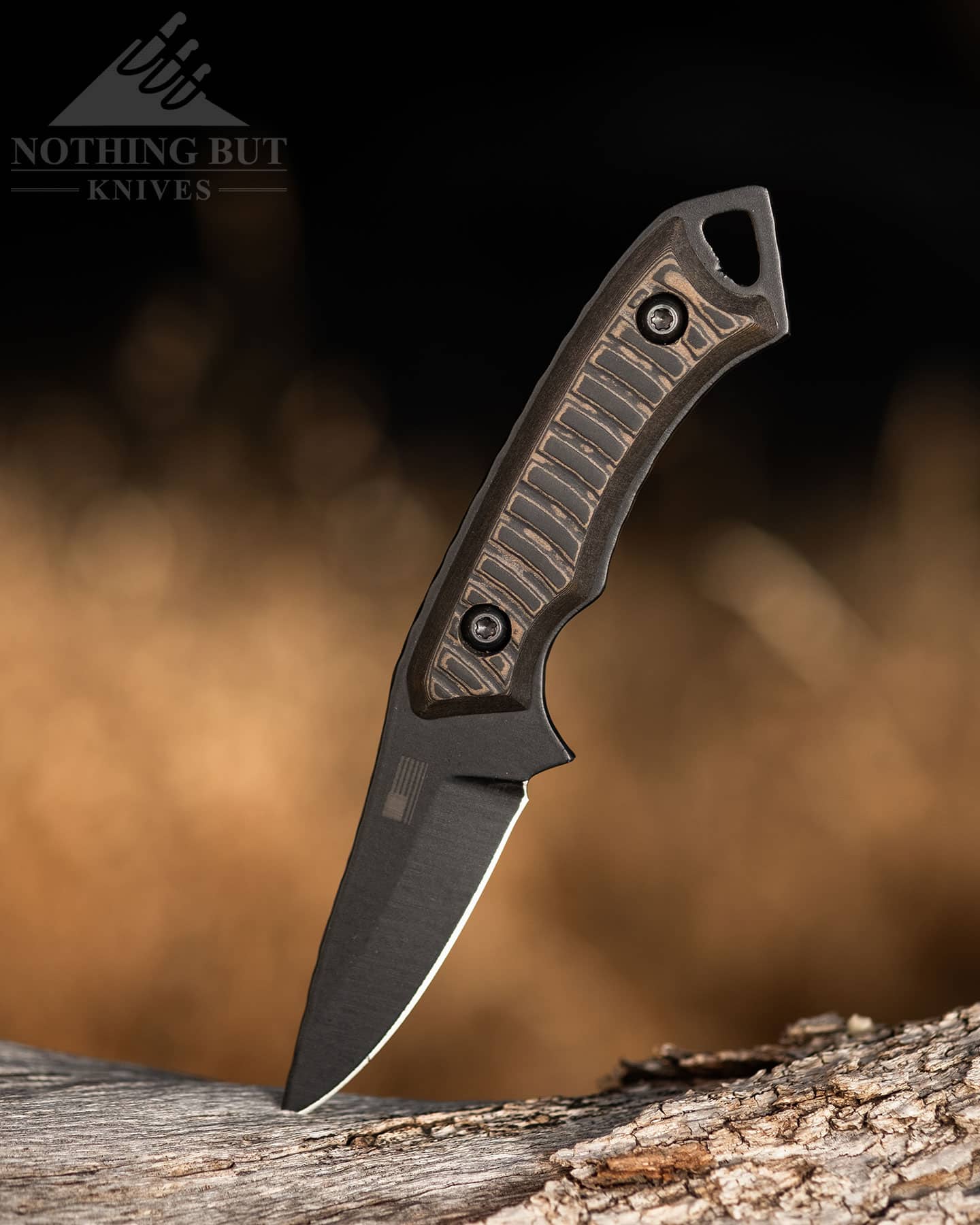
| Overall Length: | 6.25” |
| Blade Length: | 2.5” |
| Blade Steel: | AEB-L |
| Blade Style: | Drop point (in a very clip-pointy way) |
| Blade Grind: | Flat |
| Handle Material: | G10 |
| Sheath: | Kydex w/ reversible clip |
| Made in: | USA |
This little guy has a lot of bite, appropriately enough. It’s pretty nifty for carving wood. The edge is easy to work into wood gently, and the overall shape is great for getting a lot of leverage into a cut.
The angle of the overall shape also makes it comfortable to rest the index finger along the spine for detailed skinning work. You can get a lot of control over the tip of this blade. It feels like it was designed as a hunting knife for small game, but it’s a great knife for whittling by the fire.
About the Sheath
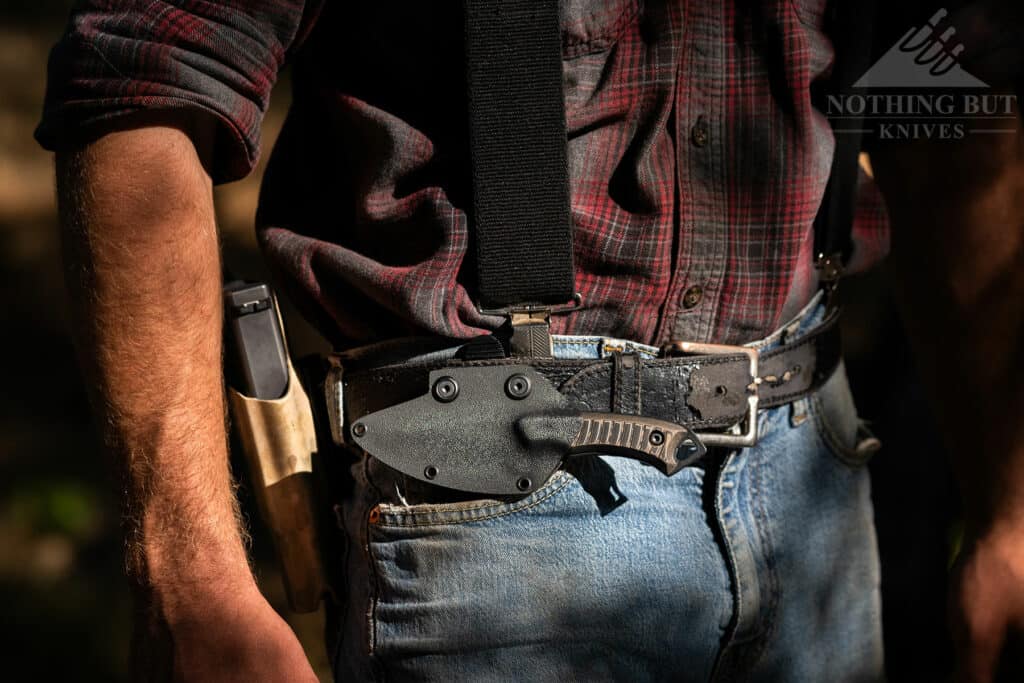
I love this sheath system. It sits on a clip that can mount to either side of the sheath, and it pivots, so this is a fully ambidextrous sheath for horizontal or vertical carry. Plus it’s so small and lightweight that it sits comfortably pretty much everywhere.
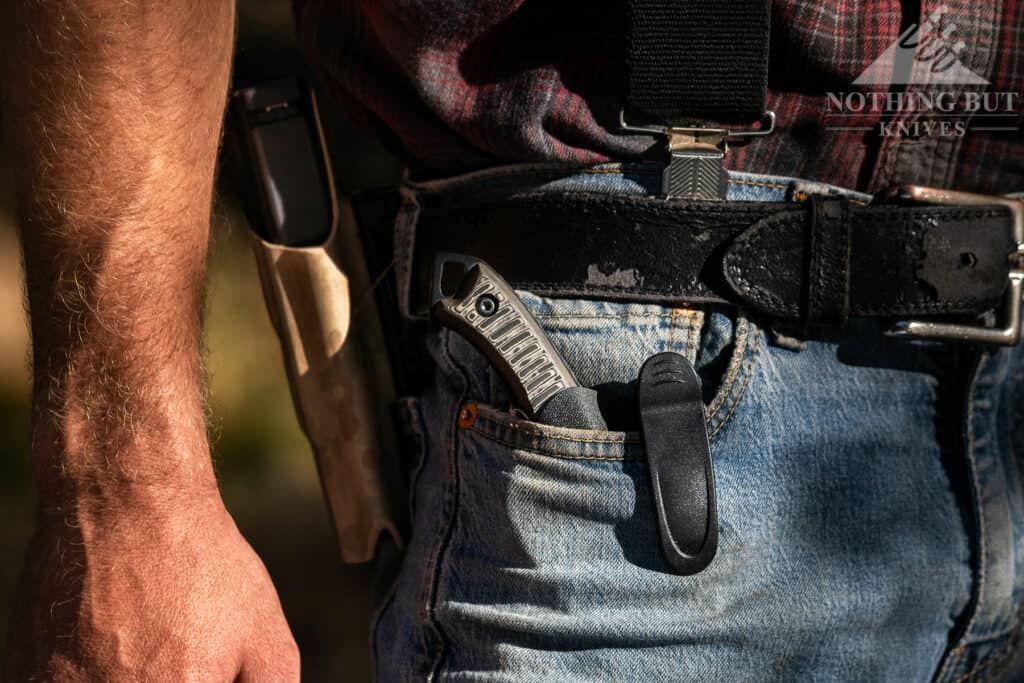
The retention on ours doesn’t feel all that tight, so I was worried about it slipping out in a scout carry situation, but I’ve shaken this thing and bounced around with it quite a bit and the knife still didn’t come out.
I wouldn’t wear it upside down, but it’s plenty good enough for most other positions. I’ve taken to packing in the appendix position inside the waistband, and that’s been working pretty well so far.
Off-Grid Sidekick – 2025 Addition
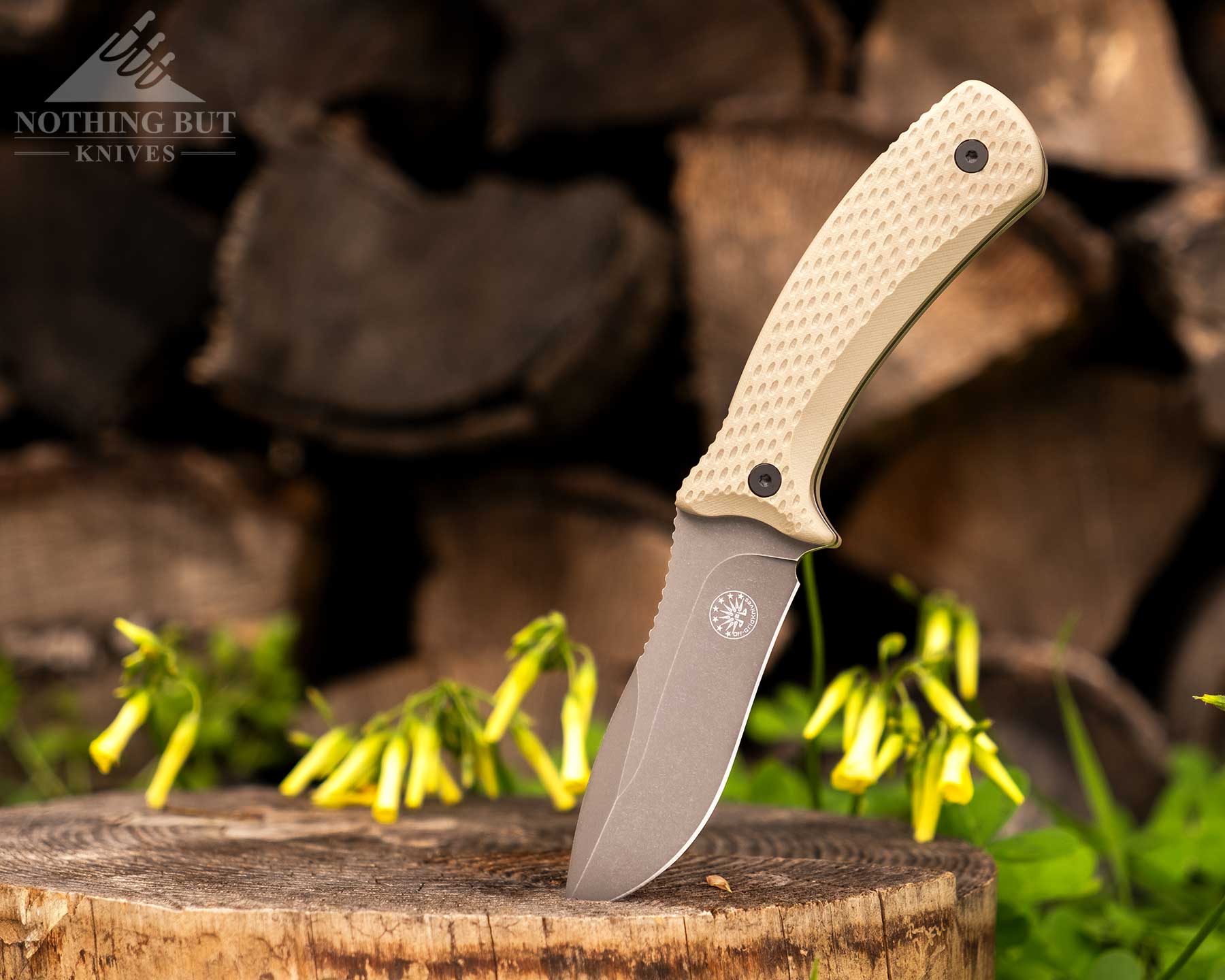
| Overall Length: | 7.75” |
| Blade Length: | 3.5” |
| Blade Steel: | 14C28N |
| Blade Style: | Drop point |
| Blade Grind: | Flat |
| Handle Material: | G10 |
| Sheath: | Taco Kydex |
| Made in: | Cary Orifice |
The SideKick is a little nessmuk blade on a boxy Off Grid handle. If you’ve ever held an Off Grid fixed blade then you know how rock solid this will feel in the hand. For those who don’t have any experience with Off Grid, we know it looks kinda boxy, but you’re only sacrificing a little bit of comfort for a lot of control over the blade.
As for the blade, it boasts all the hunting and camping task-east as a nessmuk blade ought to have. It’s a little pokey and gives you a lot more belly in the edge that the looks might suggest at first.
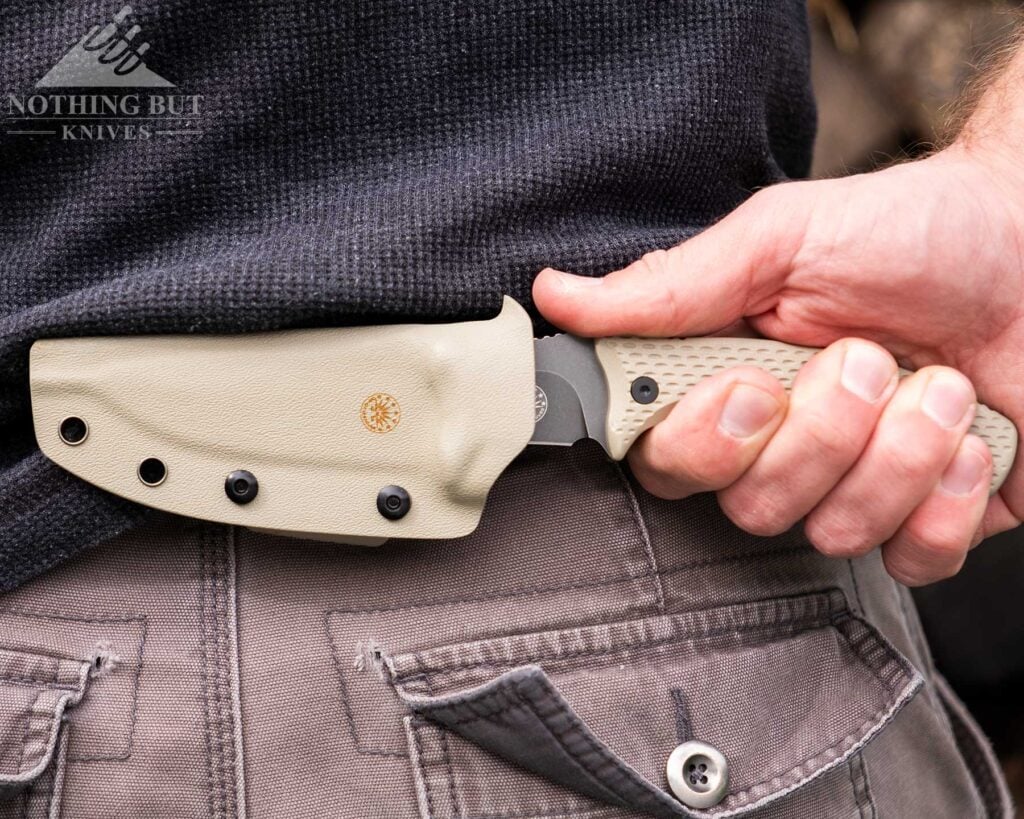
About the Sheath
Here we’ve got a taco-style Kydex sheath with a rotating clip. You’ll feel it click a little into place every time you move it, so it’s not quite free-rotating, but it’s still easy to move and adjust.
More importantly (for some people, possibly left-handed people) the clip is on a mounting plate so you can unscrew the whole rig and fasten it to either side, making it a highly modular system.
Condor SBK
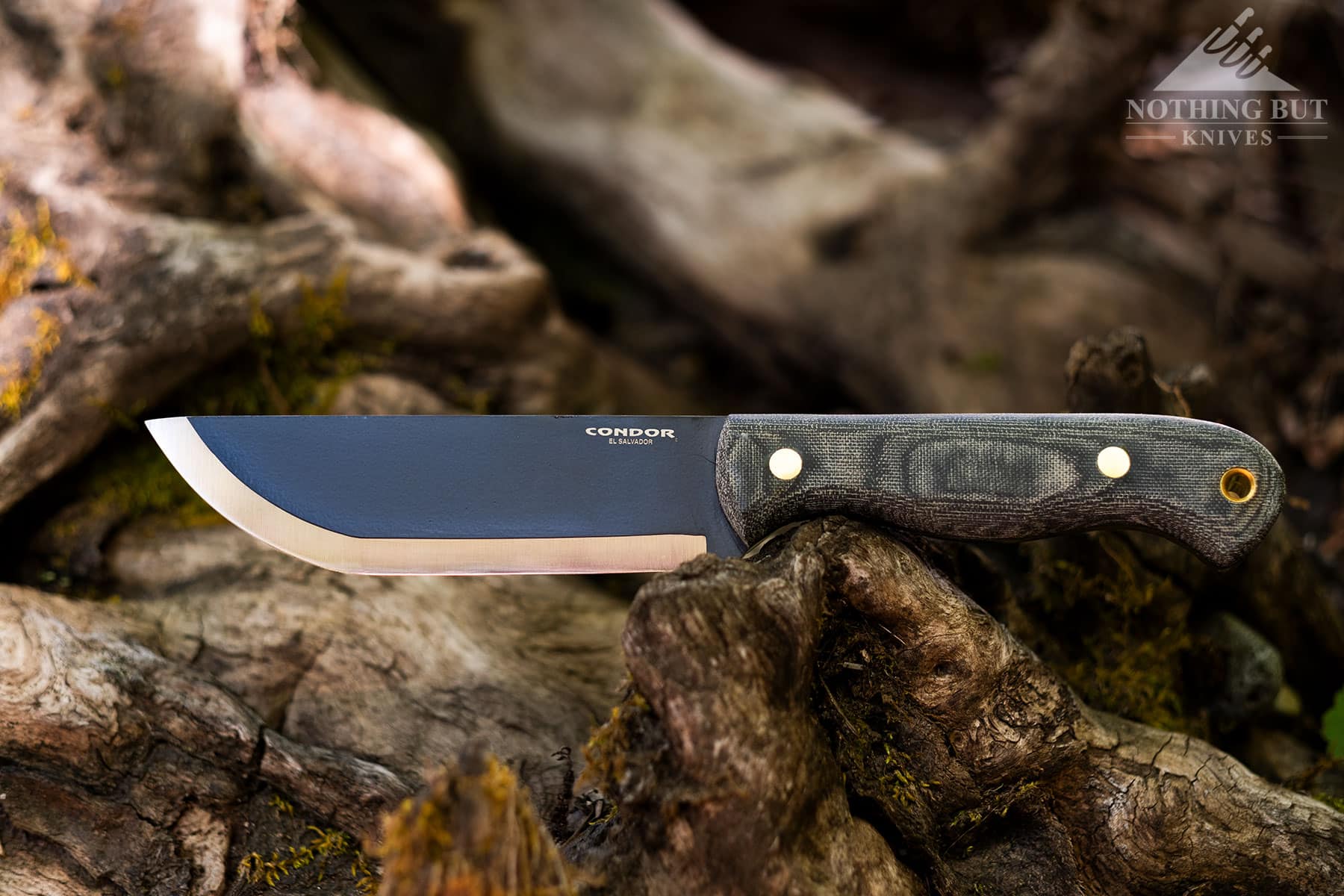
| Overall Length: | 10.5″ |
| Blade Length: | 5.25″ |
| Blade Steel: | 1075 |
| Blade Style: | Standard |
| Blade Grind: | Scandi |
| Handle Material: | Micarta |
| Sheath: | Kydex |
| Made in: | El Salvador |
| Designer: | Julio Diez |
There are a lot of details about the Condor SBK that make it a fantastic bushcraft and survival knife.
It has soft, tough steel you can fix up in the field, a scandi grind that does wonders with chopping and feather sticking, and a big, comfy Micarta handle.
This is the kind of thing Condor excels at. It’s pretty hard to go wrong with big fixed-blades from them.
About the Sheath
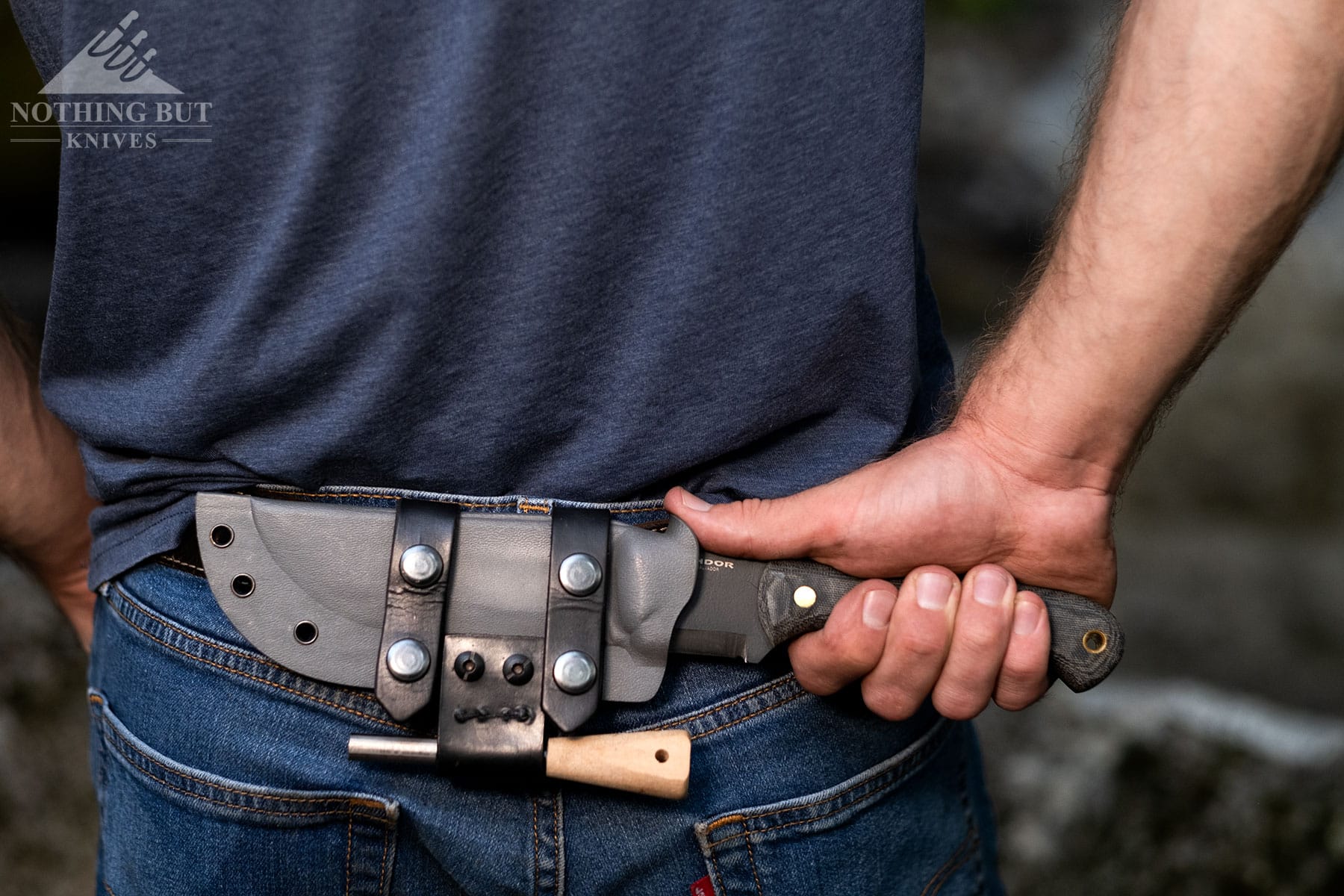
The sheath is kind of involved to wear horizontally, but it will sit secure once you get it on.
The two big leather straps have to snap on behind the belt if you want to wear it for right-handed scout carry. It’s a trick to pull off but definitely worth the trouble. Those straps hold this big thing tight to belt incredibly well, and since the buttons sit under the belt, there’s a very low risk of them coming undone accidentally.
Straps aside, the retention and deployment of the sheath feel nearly perfect. The knife clicks hard into place, there’s little to no rattling (a tough order for such a heavy knife), and the thumb ramp is molded and placed really well for getting a smooth draw.
If you want to learn more about this knife check out our Condor SBK review.
Esee 4 with MOLLE add-on
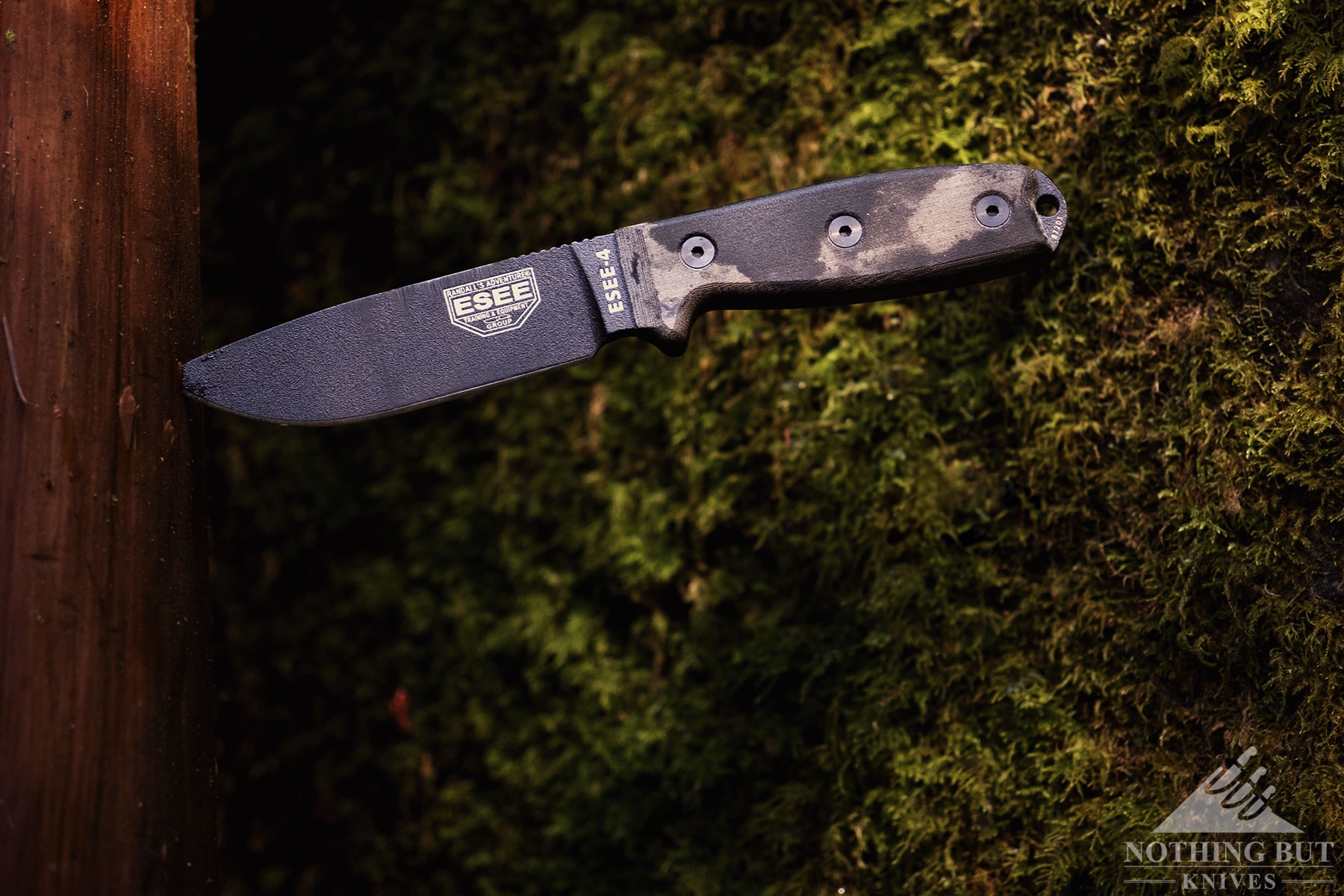
| Overall Length: | 9.0″ |
| Blade Length: | 4.5″ |
| Blade Steel: | 1095 |
| Blade Style: | Drop point |
| Blade Grind: | Flat |
| Handle Material: | Micarta or G-10 |
| Sheath: | Molded polymer w/ nylon MOLLE add-on |
| Made in: | USA |
This is an absolute beast of a blade. You could roll a tank over it and still use it to chop through a branch (probably; I haven’t had a chance to try that particular test).
The 1095 steel on this (and all ESEE knives) is a rugged, do-your-own-edge kind of a situation. It didn’t come especially sharp for us out of the box, but the blade is easy to work with, both in the field and on the sharpening stone.
About the Sheath
ESEE finally started selling their knives with MOLLE-compatible sheaths, so I get to add one of their Micarta-handled knives to the list. Be warned this isn’t the standard option. Most ESEE listings you see out there will just come with the standard vertical-carry Kydex sheath.
After some digging, I discovered if you start looking for ESEE knives with the letters “MB” thrown into the product name you can find their knives being sold with their Cordura MOLLE backs, which is supposed to be an addition to the Kydex sheath.
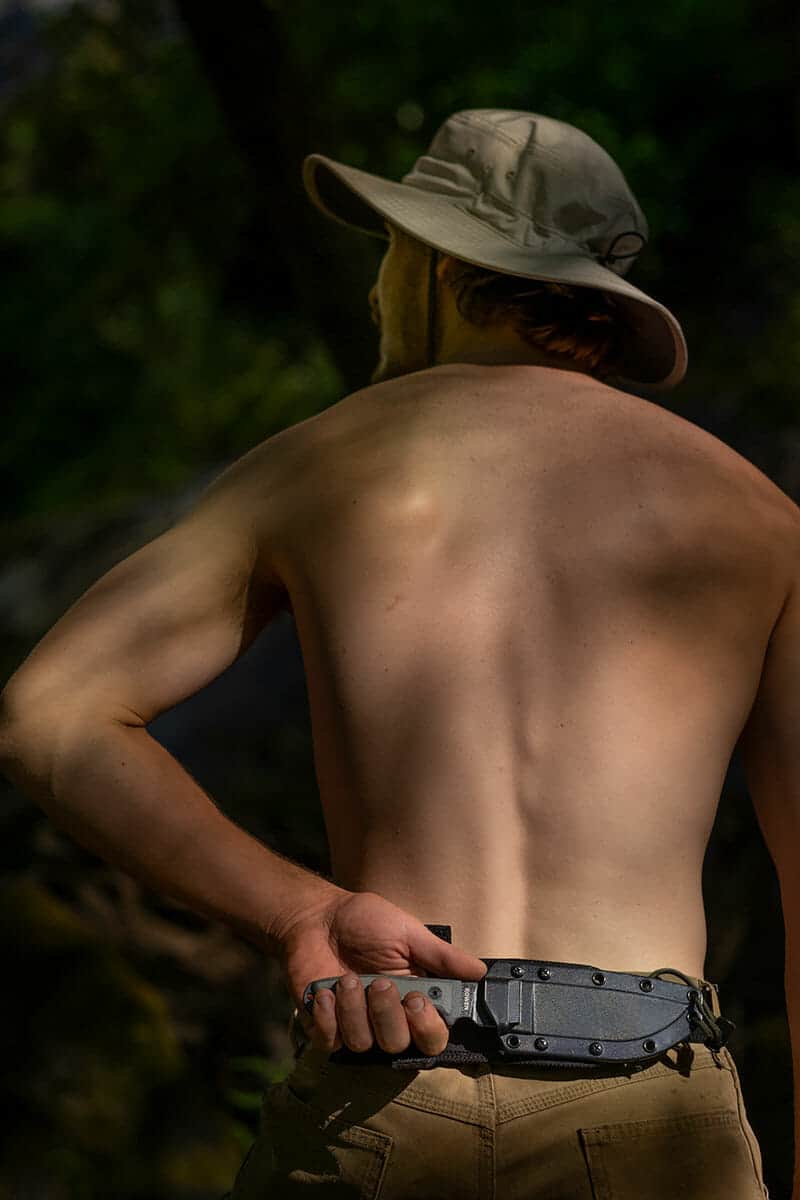
Supposedly they designed this thing to stay secure while jumping out of planes, so you can carry an ESEE any way you like with it. You’ll have to fiddle with it some first, although, probably a lot less than you’ll need to with the ESEE Izula, which we talk about farther down.
Check out our review of the Esee 4 if you want to learn more about this knife.
Kizer Beaver – 2025 Addition
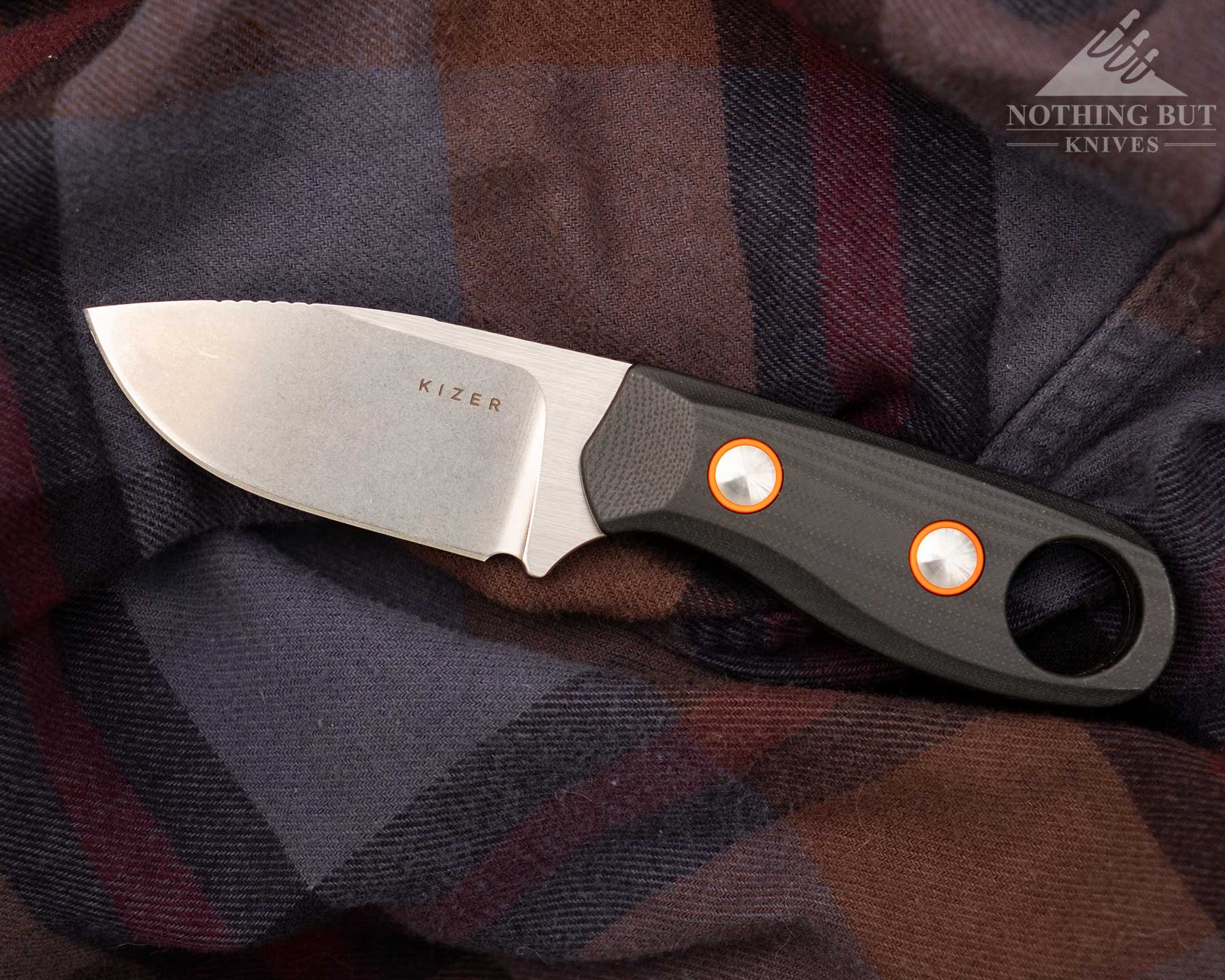
| Overall Length: | 6.0” |
| Blade Length: | 2.75” |
| Blade Steel: | D2 or Nitro-V |
| Blade Style: | Drop point |
| Blade Grind: | Flat |
| Handle Material: | G10 or Micarta |
| Sheath: | Taco Kydex |
| Made in: | China |
| Designer: | In house? |
It’s a fat little knife, this Kizer Beaver. It has those pillow dimensions that make it easy to grab and use all over. The handle is wide enough to fill the hand and has a constant curve going all around so it nests comfortably into the palm. They’ve even put a sloped bolster-ish business at the top of the handle for easy pinch grips.
Really the only downside is that the blade is a little thick. The edge is nice (and Nitro-V is nice steel), but it’s not going to top out on slicing performance.
About the Sheath
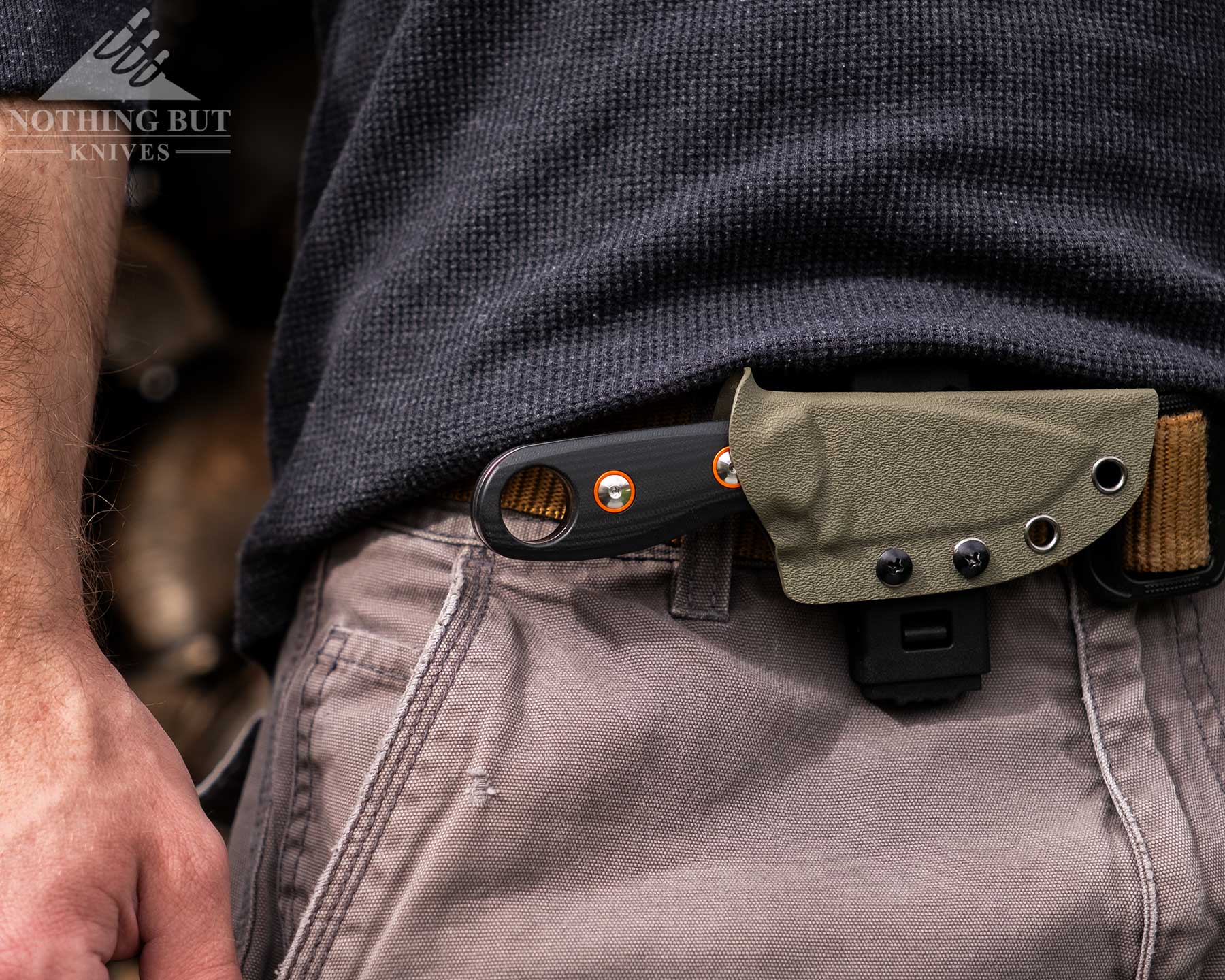
It comes in a taco-style Kydex sheath which can cause some complications in horizontal carry because there aren’t as many holes to fasten the clip into, but this is short enough that placement doesn’t matter too much. It sits tight and tidy pretty much anywhere.
The Beaver is one of my all-time favorite Kizer fixed blade knives. Hopefully it sells well, so Kizer keeps making it.
Buck Selkirk
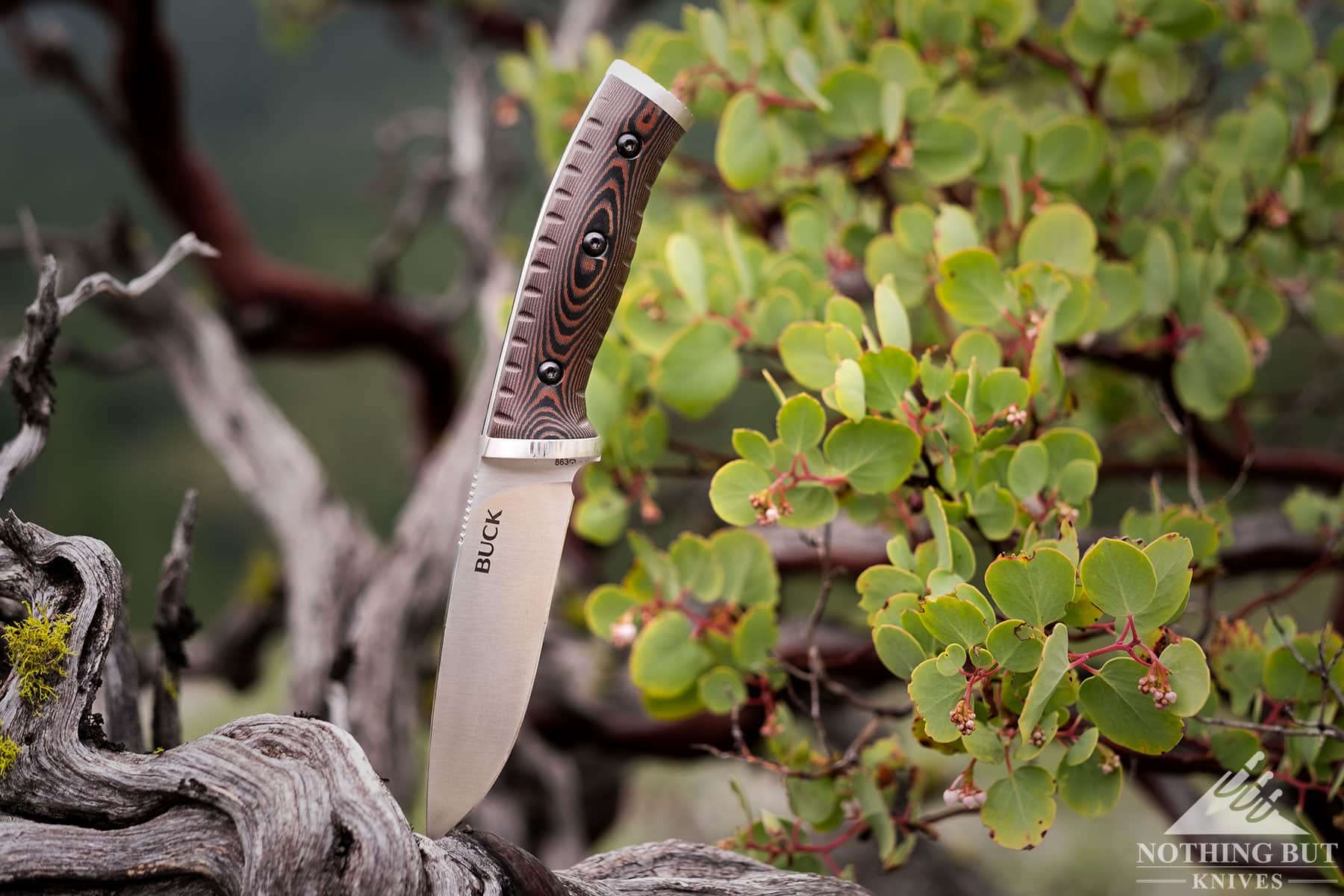
| Overall Length: | 9.5″ |
| Blade Length: | 4.625″ |
| Blade Steel: | 420HC |
| Blade Style: | Drop point |
| Blade Grind: | Flat |
| Handle Material: | Micarta |
| Sheath: | Plastic |
| Made in: | China |
The Buck Selkirk has been growing in popularity ever since it was first introduced in 2014 for good reason.
It’s a really practical bushcraft knife that feels like it was designed by someone who actually uses bushcraft style knives on a regular basis. The rounded handle makes for a great neutral shape that still has enough contours to give your grip some leverage, and the drop point blade in Buck’s 420HC works well for a hundred different outdoor tasks.
This knife was initially met with some reservations, because it’s made at Buck’s factory in China, and it uses a softer steel than most bushcraft knives, but it is such a great design that it has been winning over doubters on a regular basis. Which isn’t to say we wouldn’t love seeing this knife re-released through their US factory, even if it meant having to pay a premium.
About the Sheath
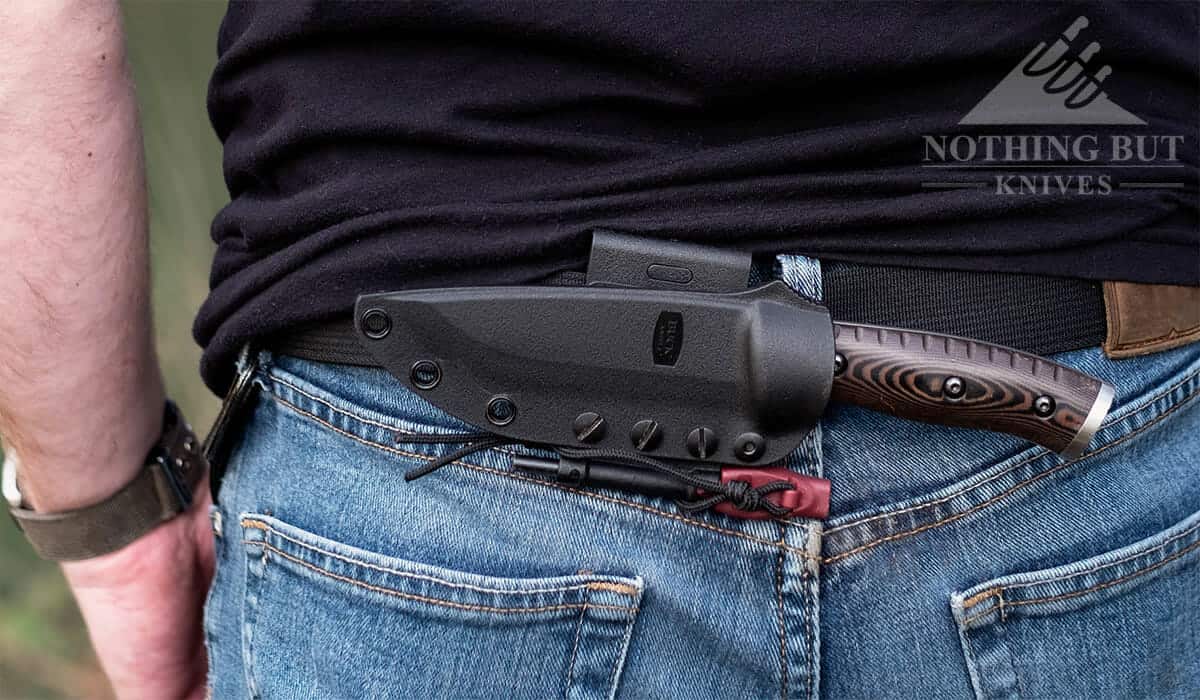
There is a little bit of a learning curve to figuring out how to reconfigure the sheath. There are a lot of bits and screws to move and tighten. It kinda has two parts that you have to negotiate with, so it’s best if you convert it to horizontal carry at home on a large, well-lit surface before you pack it out into the wilderness.
But the overall versatility and ease of use make the initial slow-ish set up well worth it. The retention is good, it rides tight to the belt, and the ergonomics of drawing and sheath make the whole experience super smooth.
Click here to see read our in depth Buck Selkirk Review.
Gerber Principle
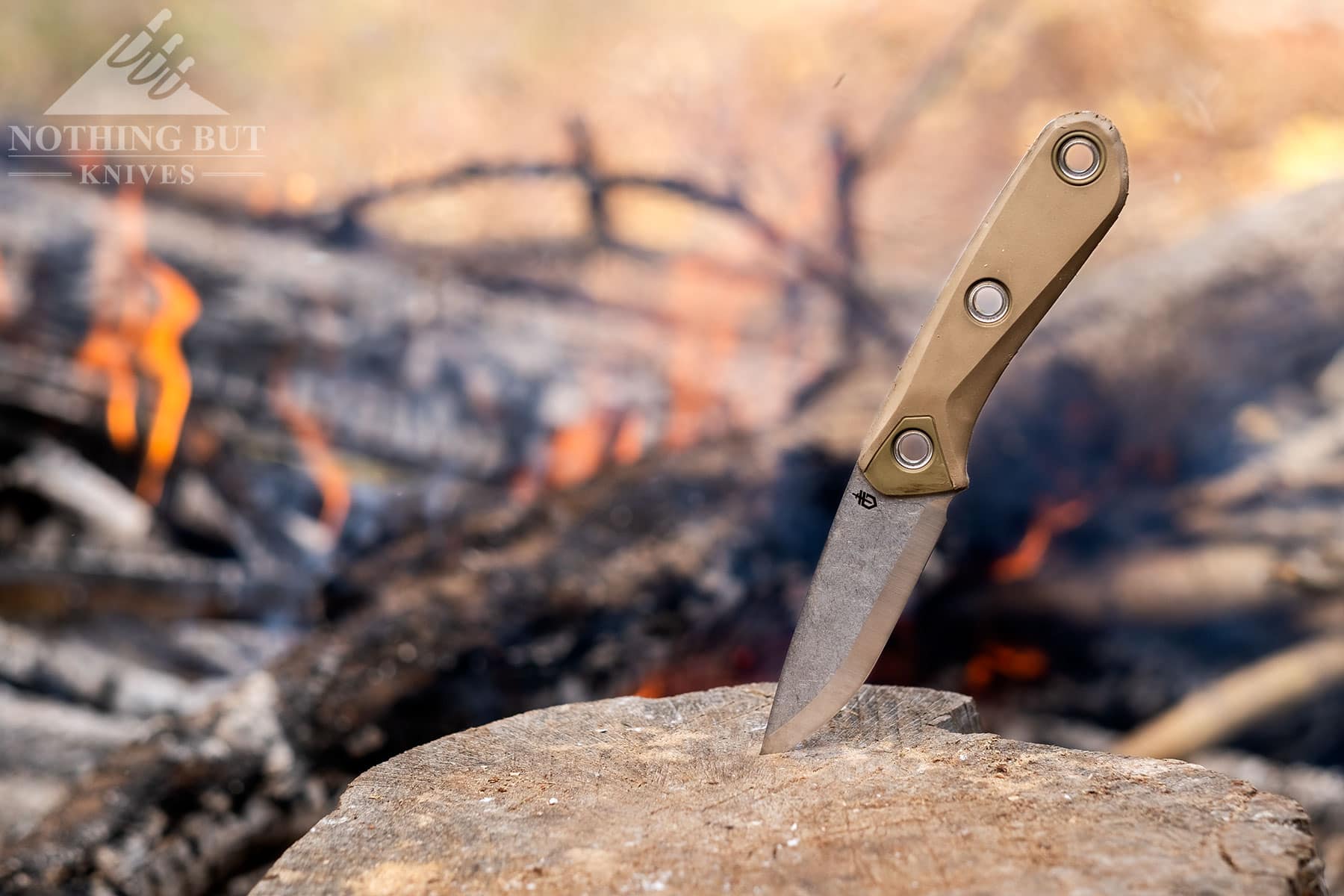
| Overall Length: | 7.5″ |
| Blade Length: | 3.1″ |
| Blade Steel: | 420HC |
| Blade Style: | Drop point |
| Blade Grind: | Flat |
| Handle Material: | Rubber w/ polymer inserts |
| Sheath: | Polymer |
| Made in: | USA |
It’s always nice when knife companies listen to their customers, and that’s what it looks like Gerber was doing with the Principle.
Lots of us have been wanting a bushcraft style knife with a sheath system as versatile as the Gerber Ghostrike, and the Principle definitely delivered.
From a bushcraft standpoint the Principle checks a lot of boxes. It has a zero edge scandi grind, a 90 degree spine for starting fires with a ferro rod, and a comfortable handle for hard use. Gerber released this around 2019 and it became popular very quickly. Enough that they followed it up with a larger version called the Terracraft, which has a blade that’s about an inch longer in S30V steel.
About the Sheath
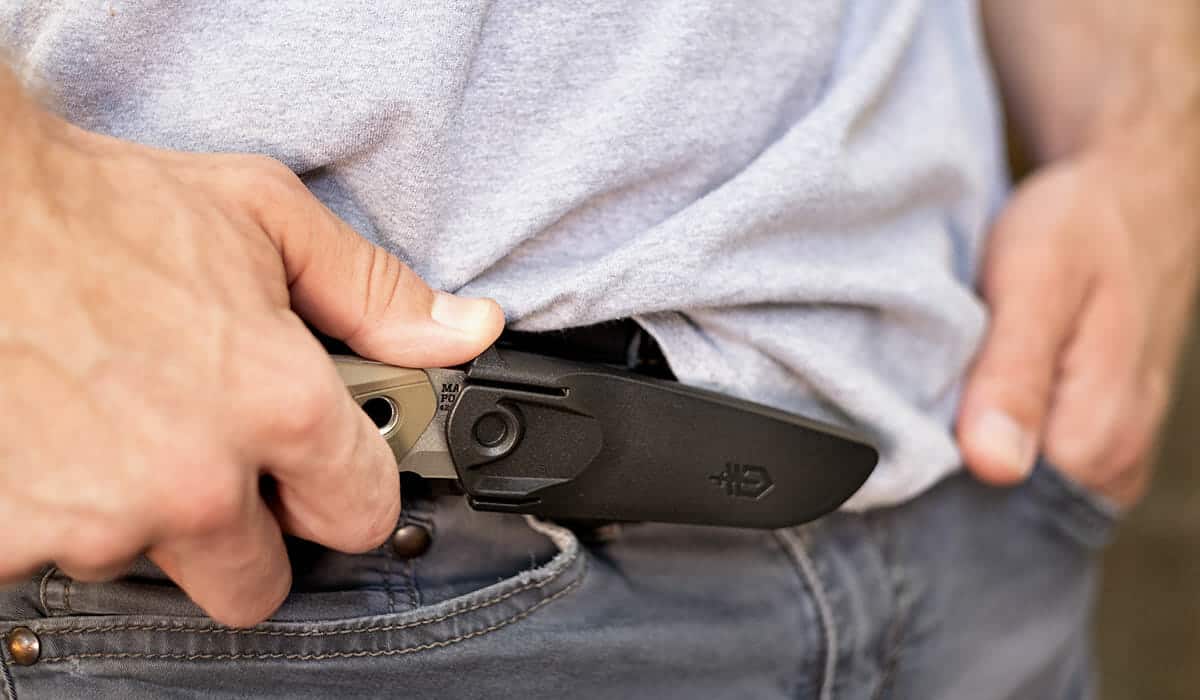
I deeply appreciate the mounting system on this knife, because you don’t have to deal with any screws to adjust it.
Basically there are slots in the back of the sheath, a separate mounting plate, and a long plastic tab that runs through both. When you want to change the position, you just pull the tab and shift the plate. It’s MOLLE-compatible and incredibly quick and simple.
If you want to know more about this knife check out our in depth review of the Gerber Principle.
Civivi Timberbark
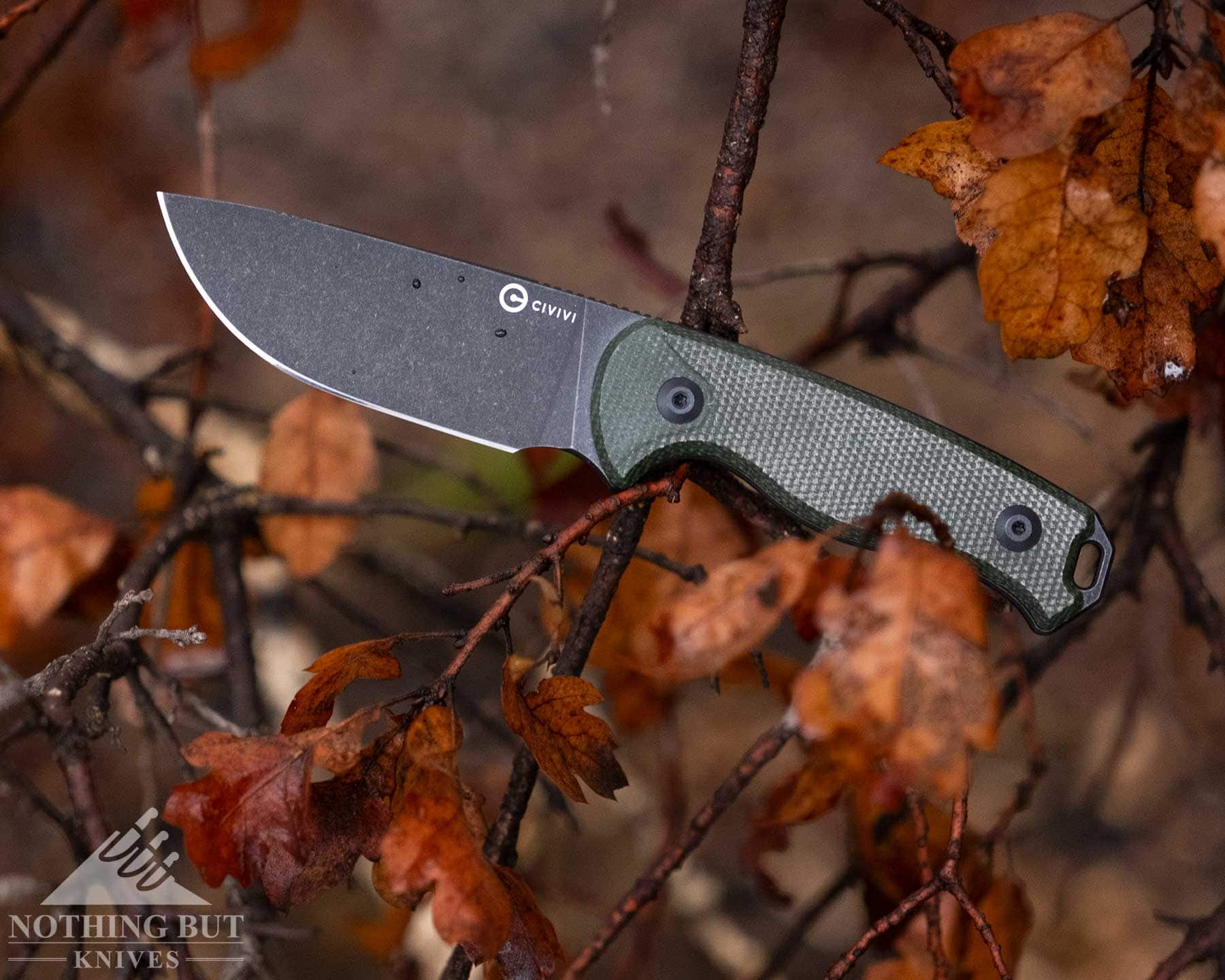
| Overall Length: | 6.89” |
| Blade Length: | 3.2” |
| Blade Steel: | 14C28N |
| Blade Style: | Drop point |
| Blade Grind: | Full Flat |
| Handle Material: | G10 |
| Sheath: | Pancake Kydex |
| Made in: | China |
| Designer: | In house |
The Civivi Timberbark is a thin little slicer. A full flat grind makes it cut like a dream, and the Sandvik steel is just about the easiest thing on the market to maintain and sharpen. Edge retention might be on the lower end, but the thin geometry helps with that.
One really impressive thing about the design is the handle. It’s thin along with the rest of the knife, so it really doesn’t take up much real estate on your belt or in your pack, but the Micarta is dry enough to give it a great grip.
About the Sheath
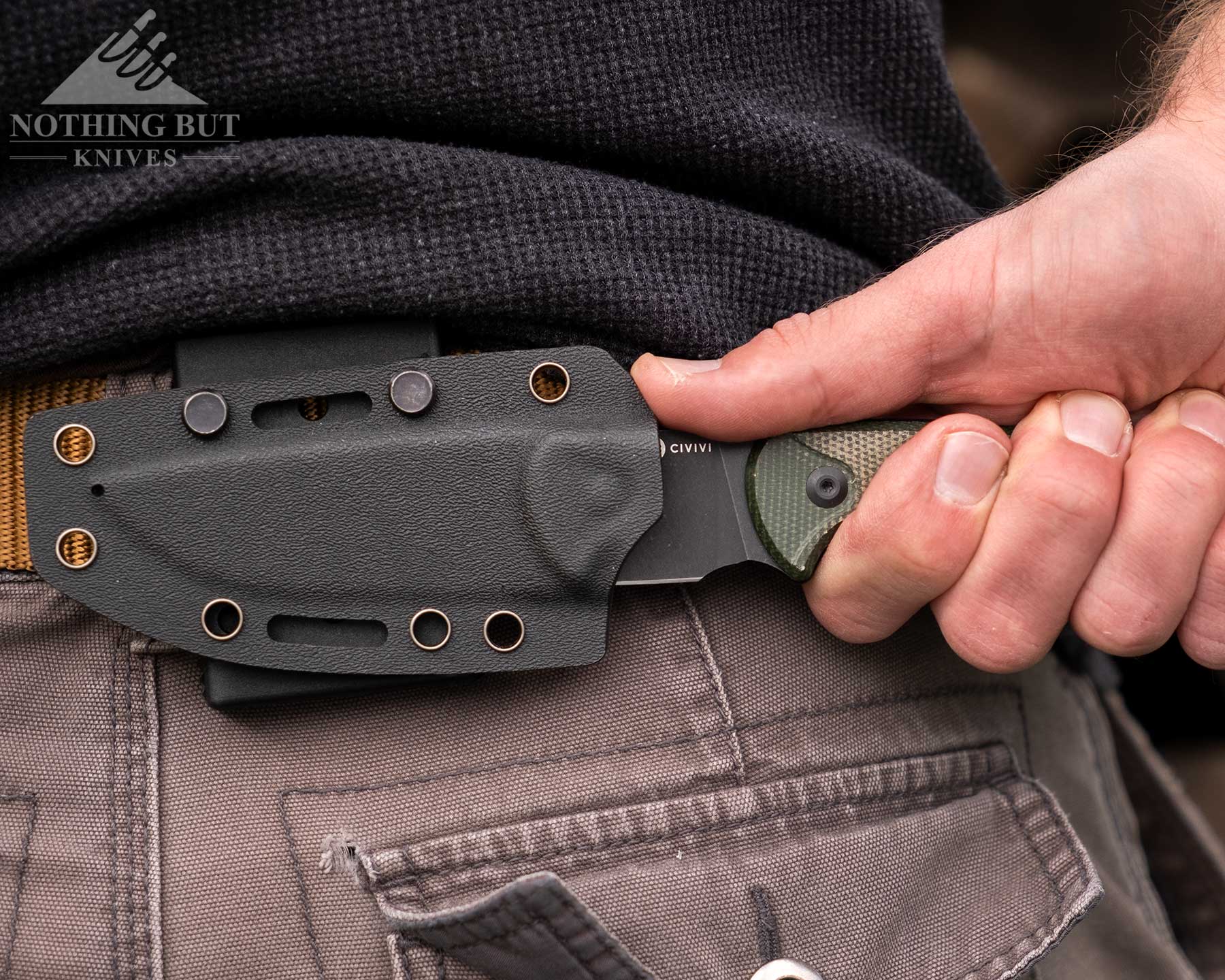
You’ve got a simple pancake style Kydex rig with Civivi’s own Terzuola-designed belt clasp system. It fastens with two phillips-head screws, and the clasp is wide enough for pretty much any reasonably sized belt. On the whole, it’s not much fuss at all to get into scout or appendix carry.
Ontario Rat 3
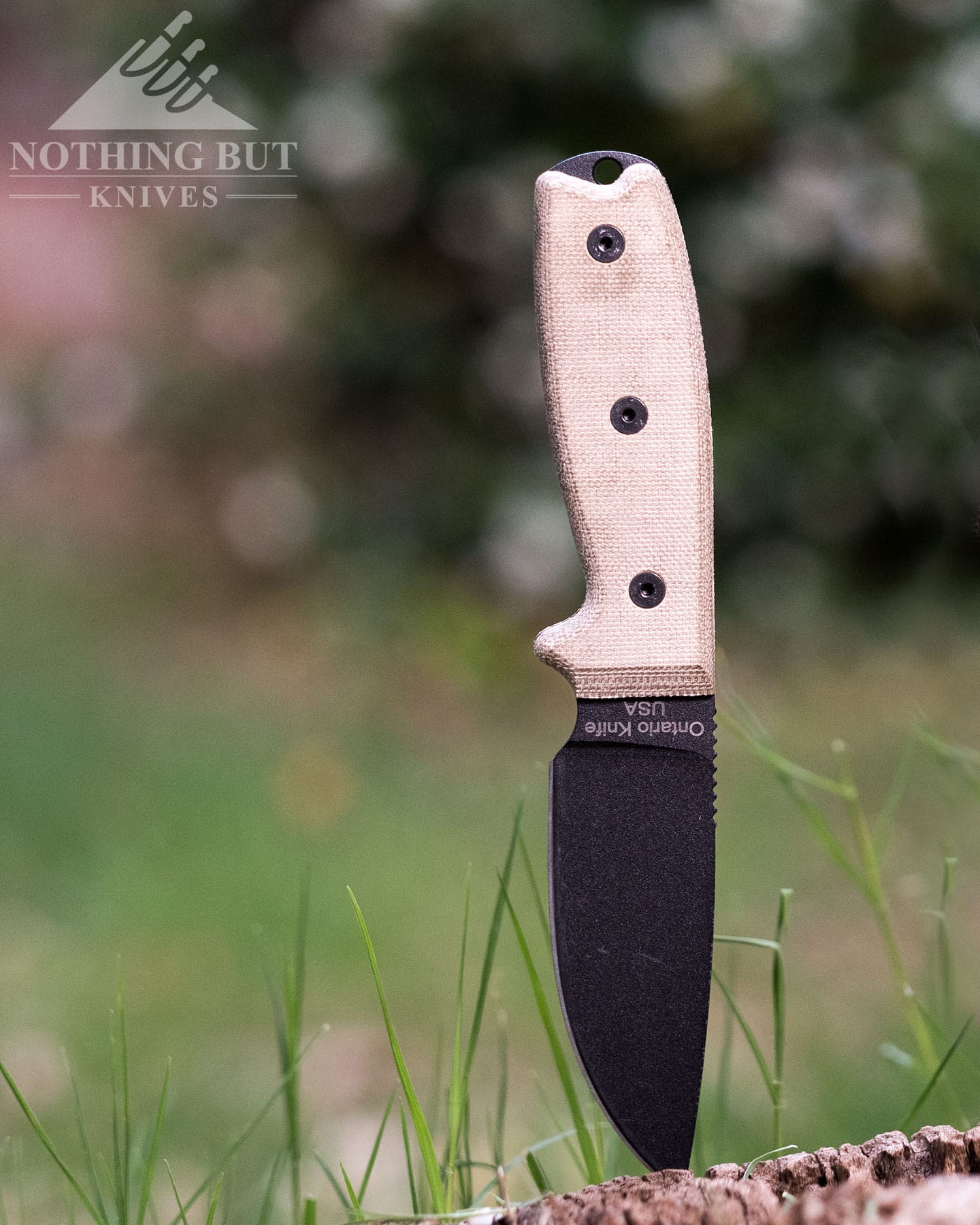
| Overall Length: | 7.75″ |
| Blade Length: | 3.75″ |
| Blade Steel: | 1095 |
| Blade Style: | Drop point |
| Blade Grind: | Flat |
| Handle Material: | Micarta |
| Sheath: | Kydex or nylon |
| Made in: | USA |
This is kind of the cheaper, rougher, older brother to the ESEE 3 (which isn’t on this list, but is worth mentioning here, at least).
OKC doesn’t have quite the same level of fit and finish as ESEE with most of their knives, but the RAT 3 is a phenomenal beater knife for the price (and because of the price). I might even go so far as to sat that the flat Micarta scales on this are more comfortable than ESEE’s flat Micarta scales, but that’s as far as I’m willing to take this comparison.
About the Sheath
There are two sheath options for the Rat 3. The cheaper option is the basic nylon sheath pictured below. The other option is a kydex sheath with the Tek Lok. Both options allow you to carry the Rat 3 horizontally or vertically.
If you use the Tek Lok mechanism for the Rat 3’s kydex sheath you have near-infinite carry options. As good as the knife itself is, I think that’s probably one of my favorite features about the Rat 3.
They’ve designed the kydex sheath so that the clips can be set in four different ways with screws, and the retention is so strong you could wear the knife upside down without it falling out.
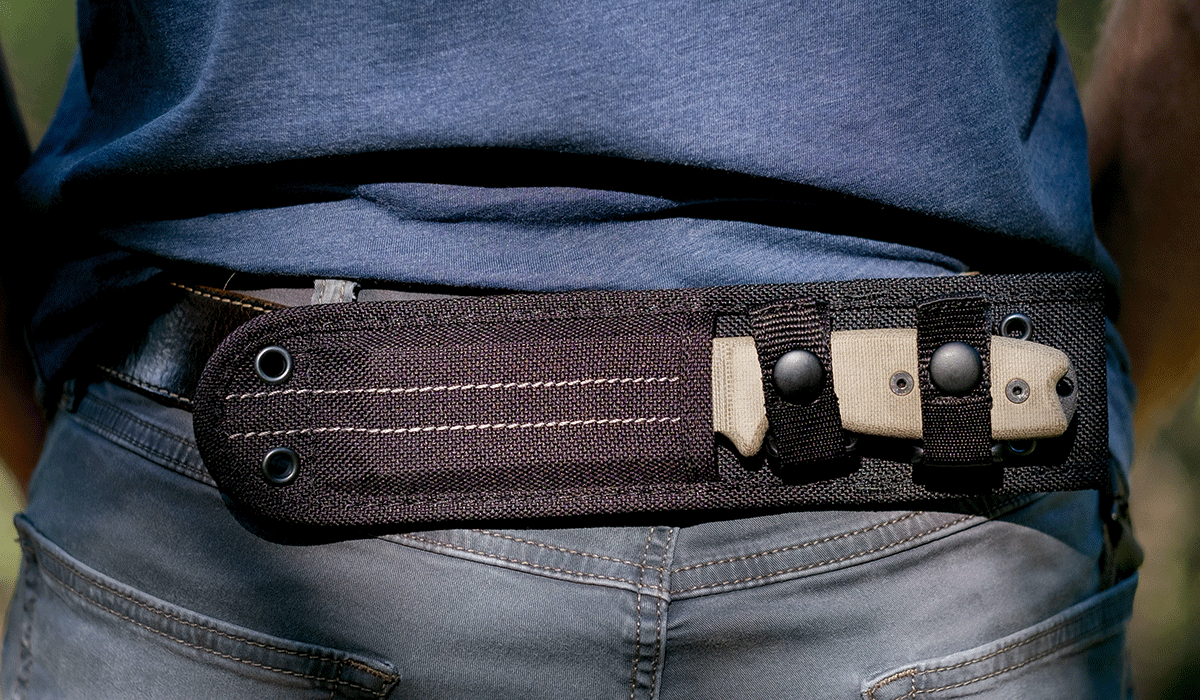
The included nylon sheath is really versatile, and makes it easy to carry the Rat 3 in a variety of ways including on a backpack. However the snaps are somewhat difficult to manage when worn in the scout carry position pictured above, so front carry may be the best option for most people when wearing the RAT horizontally.
Click here to read our in-depth review of the Ontario Knife Company Rat 3.
Esee Izula
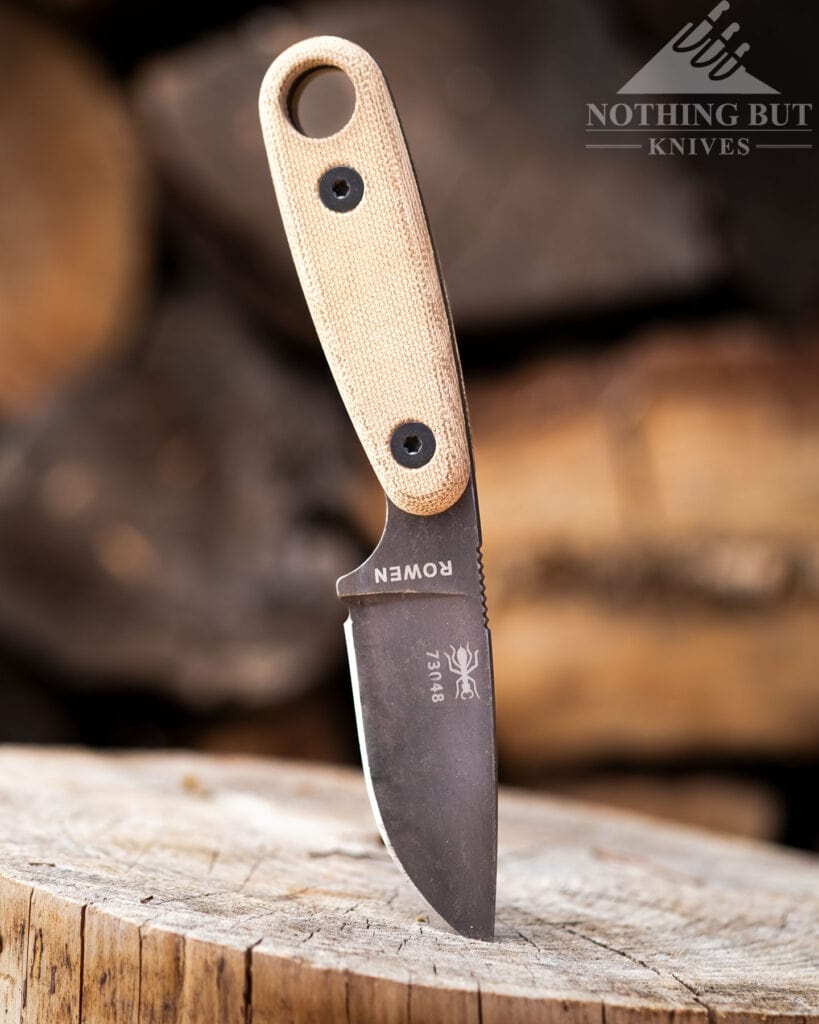
| Overall Length: | 6.75″ |
| Blade Length: | 2.875″ |
| Blade Steel: | 1095 |
| Blade Style: | Drop point |
| Blade Grind: | Flat |
| Handle Material: | Steel |
| Sheath: | Molded polymer |
| Made in: | USA |
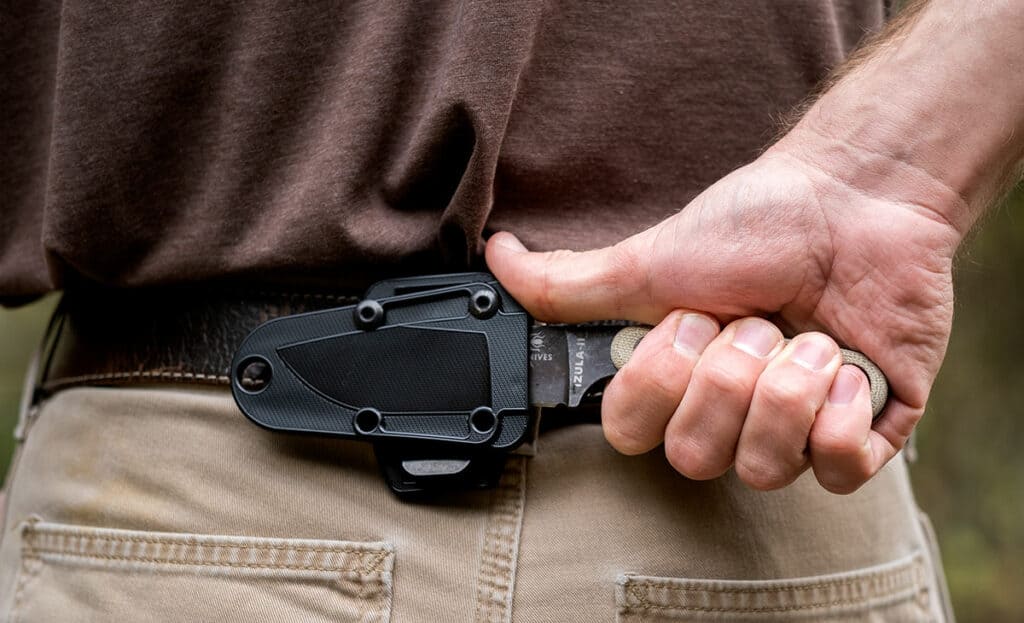
At 6.75 inches from tip to pommel, the Esee Izula II is the perfect size for scout carry.
It’s small enough to not get in the way, and light enough to be easily forgotten until you need it. The size and weight of the Izula II can been further minimized by removing the Micarta handle scales, but the handle is so comfy with the scales on that the little bit of extra weight and bulk is worth it (to us anyway).
About the Sheath
The Izula II sheath is ambidextrous, and it can be worn vertically, horizontally, or as a neck knife. But the clip itself also has an interesting double sided feature where one side is wide and fat to accommodate larger belts or straps, and the other side is tight so it holds snug to whatever it’s on.
It takes some fiddling to figure out, but it’s turned out to be one of the better belt solutions we’ve seen on a horizontal carry.
It’s one of those conveniently versatile but surprisingly hardy knives. Or maybe not so surprising, since ESEE has pretty firmly established themselves as a household name in the survival knife world. Generally speaking, I would recommend this knife even if you aren’t looking for a horizontal carry, because if you use knives regularly you’re bound to end up using this one a lot.
Civivi Elementum Fixed Blade
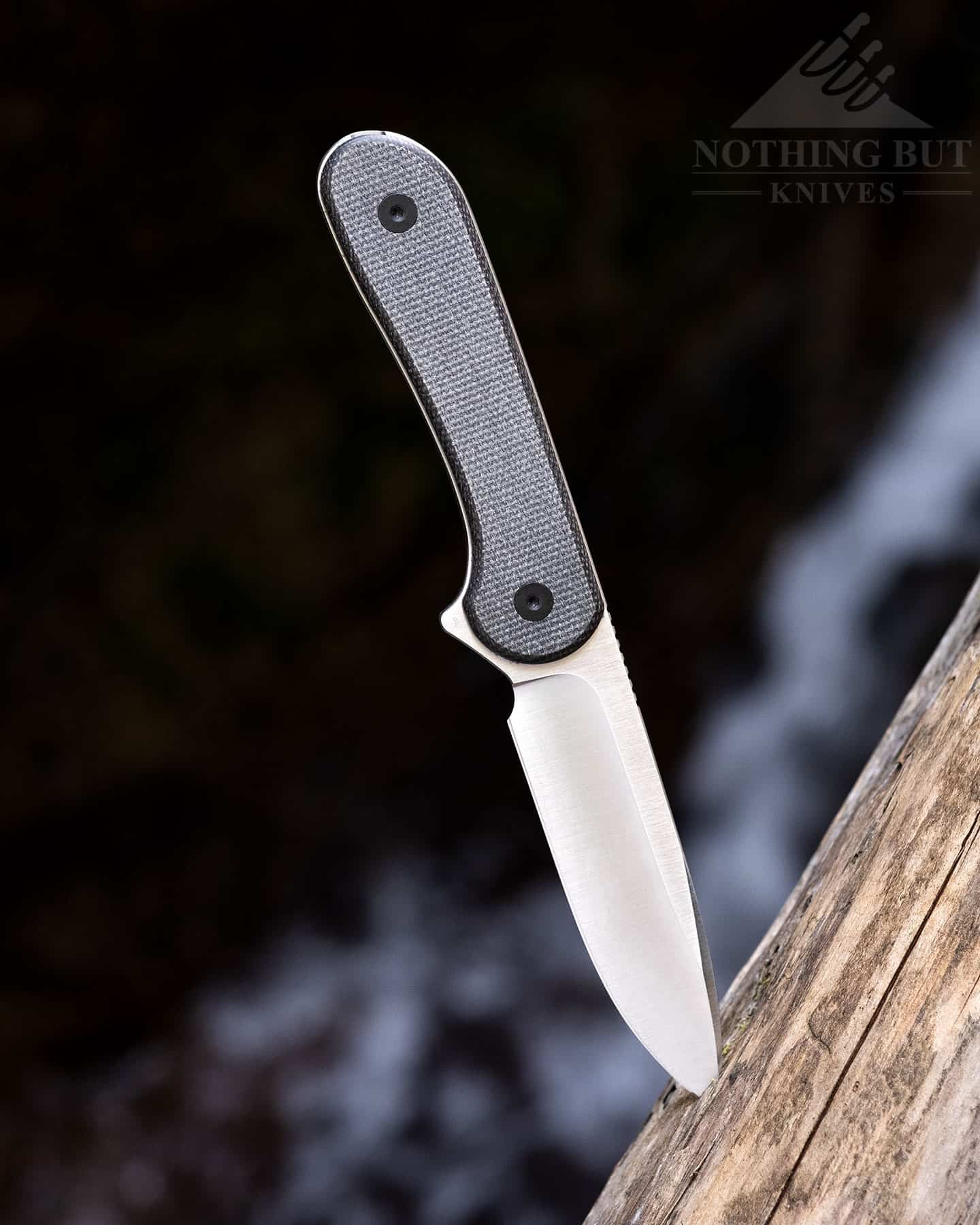
| Overall Length: | 8.48” |
| Blade Length: | 3.98” |
| Blade Steel: | D2 |
| Blade Style: | Drop point |
| Blade Grind: | Hollow |
| Handle Material: | Micarta |
| Sheath: | Kydex with T-Clip |
| Made in: | China |
This doesn’t have quite the same tactile experience as the standard Elementum folder. It’s quite a bit better actually.
Comfort is usually a big upside of fixed blades, but this feels especially good in hand. The slight curve on a neutral handle shape with soft Micarta scales makes the Elementum fixed blade practically melt into the hand.
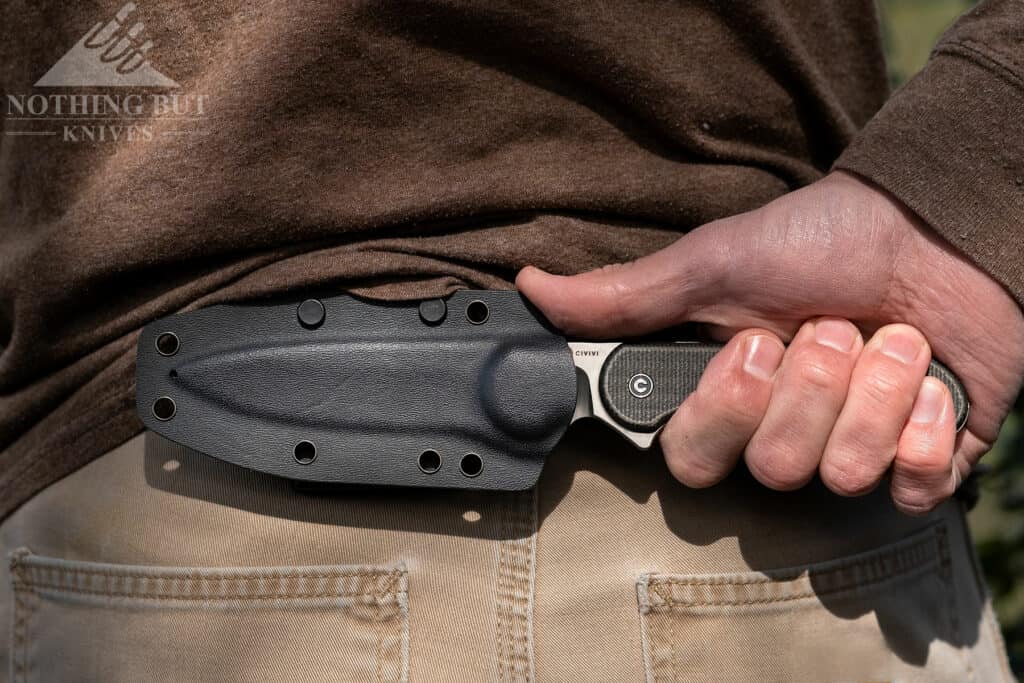
About the Sheath
More importantly, Civivi has gotten pretty darn good with their sheaths. It’s nothing too fancy, but they have the retention dialed in pretty well to have a good grip with easy deployment.
The handle shape also has a slight lip at the top that makes a nice catching point for the sheath molding. It’ll take a lot of wear and tear to get this thing to loosen up.
The weight balances out just a little above the point the clip rests at, so you probably won’t feel it tugging at your belt much. But this design is still a little more handle than blade, so it leaves a bit sticking out from the sheath. Depending on where you place the thing you might get some handle poking out from your side.
For a little more detail, check out our full review of the Elementum Fixed Blade.
Kizer Harpoon
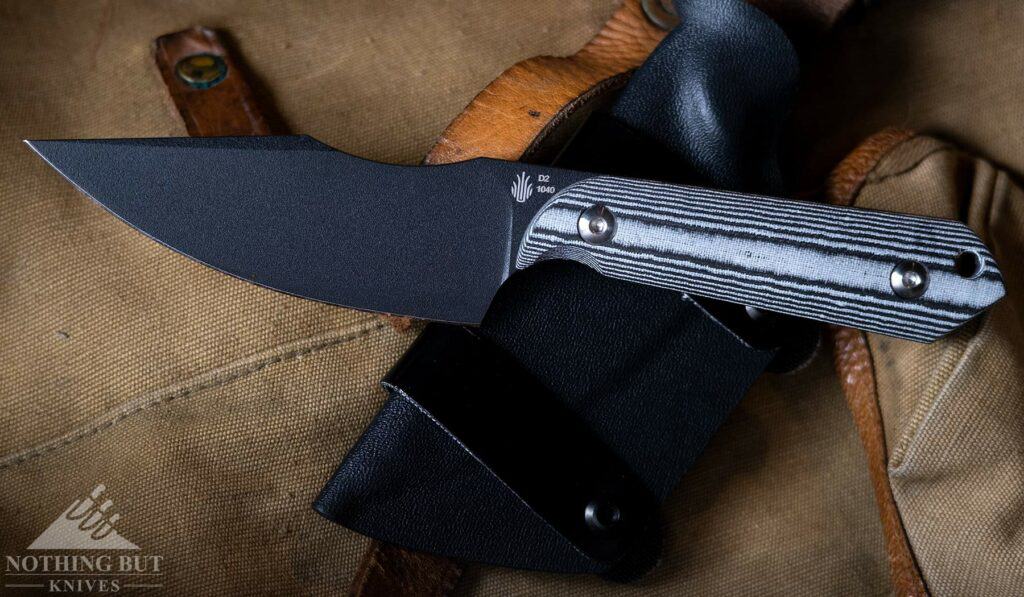
| Overall Length: | 7.75″ |
| Blade Length: | 3.875″ |
| Blade Steel: | D2 |
| Blade Style: | Harpoon |
| Blade Grind: | Flat |
| Handle Material: | Micarta |
| Sheath: | Kydex |
| Made in: | China |
| Designer: | Maverick Customs |
This is an impressive sub $100 fixed blade knife. It’s light, well balanced and just a great all around design. However, I do wish Kizer had upgraded the leather straps and added a tension screw to the kydex sheath. Even without those upgrades I consider the Kizer Harpoon to be one of the best knives of 2021.
The linen micarta handle of the Kizer Harpoon is extremely grippy in all kinds of weather. It’s also really comfortable even when performing hard use tasks like feather sticking or branch cleaning. Hopefully Kizer will offer more color options in the future, but I personally like the looks of the current handle scales.
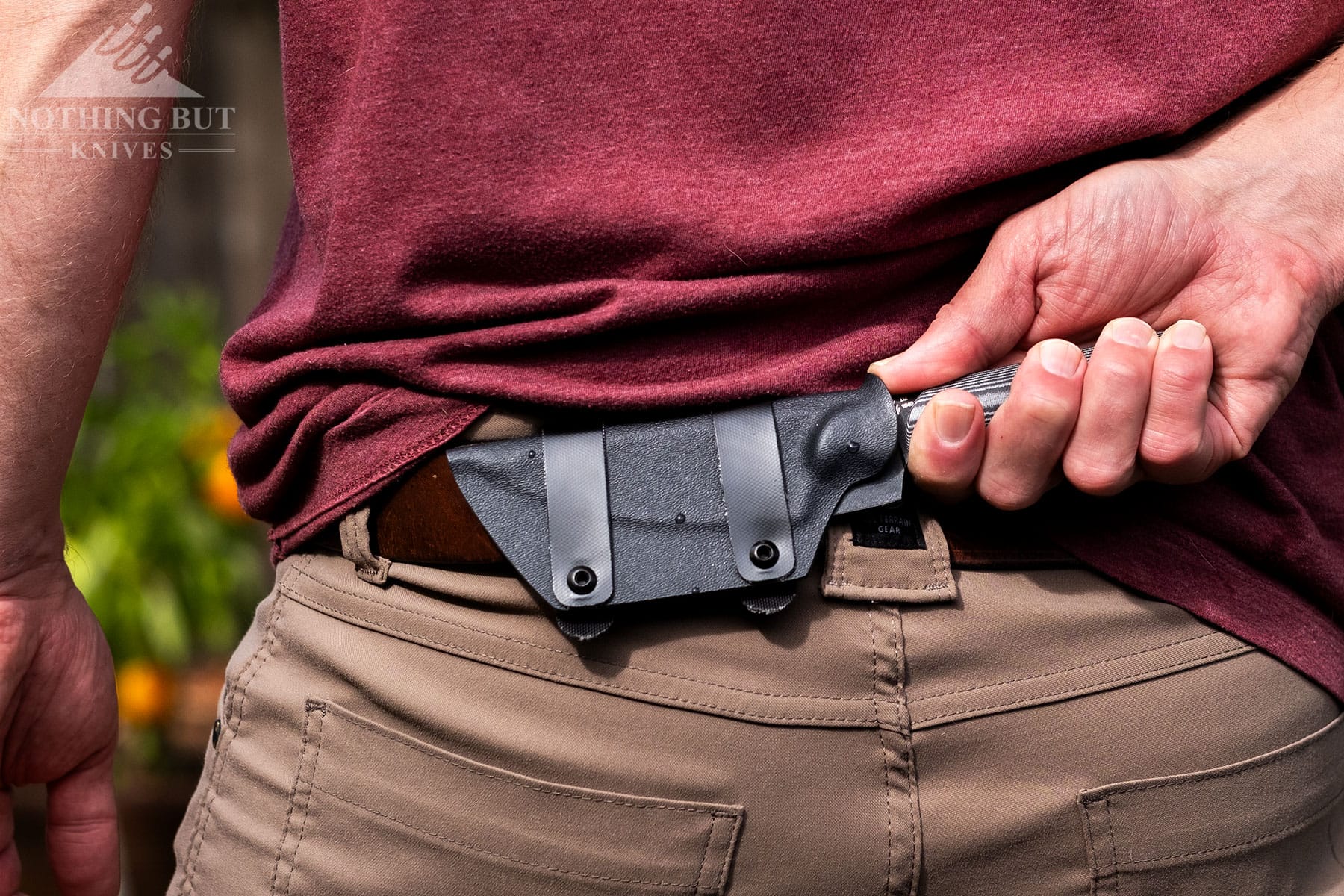
The D2 steel blade holds a good edge, and the black powder coating helps with corrosion resistance. I would still recommend using a food grade blade oil, because all coatings wear off eventually when a knife is used a lot, and D2 can be touchy with exposure.
About the Sheath
The sheath that ships with the Kizer Harpoon is horizontal carry only. Fortunately the it can be easily changed from right or left scout carry to right or left front horizontal carry without making any adjustments or taking off the belt. Kudos to Kizer and and the designer (Maverick Customs) for making a carry system that can be easily transitioned in the field.
Hopefully if this knife is popular enough, Kizer will offer an upgraded version of the sheath with tension screws, because the current kydex sheath does tend to lose its retention after a few months of use. This can be fixed fairly easy by reheating the kydex, but it would be nice to not have to do that on a regular basis.
You can find more great horizontal carry knives from Kizer by checking out our Kizer Fixed Blade Guide.
Southern Grind Jackal Pup
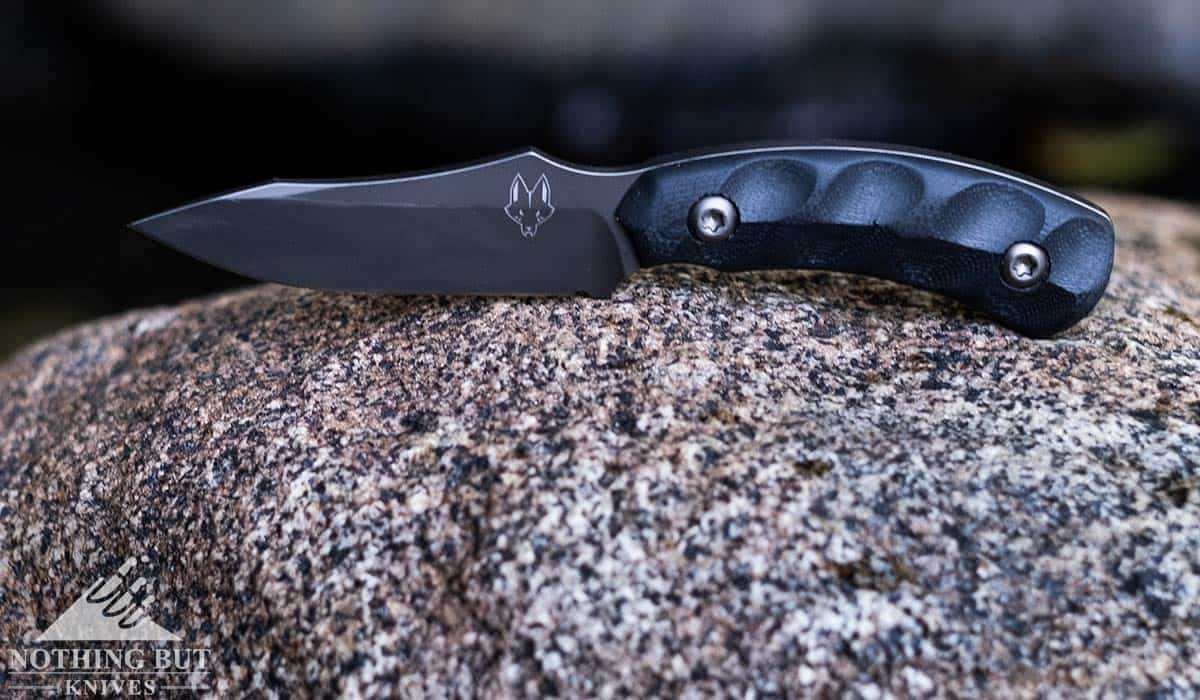
| Overall Length: | 5.75″ |
| Blade Length: | 2.75″ |
| Blade Steel: | 8670M |
| Blade Style: | Drop point |
| Blade Grind: | Flat |
| Handle Material: | G-10 |
| Sheath: | Kydex |
| Made in: | USA |
This knife has been on the market for a few years, but we somehow missed until 2021. The Southern Grind Jackal Pup is a well designed, practical knife with a sheath that is capable of both left and right horizontal carry on a belt. It can also be used as a neck knife with the addition of a bit of paracord.
The contoured G-10 handles are easy to grip even when the knife is wet. This is fortunate, because this knife is a great trout fishing buddy. It’s the perfect size for cleaning trout and the versatile sheath allows it to be carried in whichever way is most comfortable for the type of fishing being done.
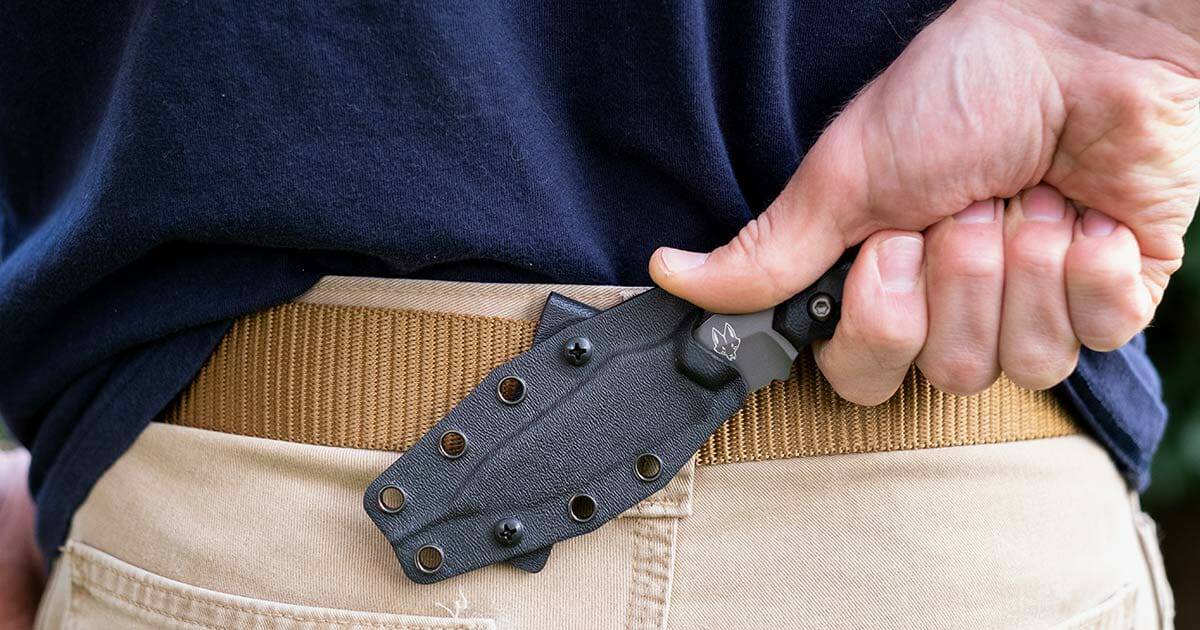
The blade of the Jackal Pup is made of 8670M steel which is a high carbon steel that holds its edge extremely well. It’s important to remember to dry the knife when it gets wet and occasionally wipe it down with a food grade knife oil to ensure it doesn’t develop rust spots. That is always downside of high carbon steels.
About the Sheath
This is one of the few options on this list that comes stock at a canted angle, so it’s not full horizontal.
That belt clip is easy to switch around, though. It just takes a couple phillips-head screws, and you can throw it on for left or right-handed carry anywhere on your belt and it’ll sit nice and tidy.
Overall I have found the size and design of this knife to be extremely practical in a variety of situations which explains its popularity. If I were going to be nitpicky, I would recommend Southern Grind sell a pocket clip sheath similar to the Boker Barlow Burnley BFF, so that this knife could be carried as a pocket fixed blade. It’s a good size for that style of carrying, but it works just fine as is.
LionSteel M2M
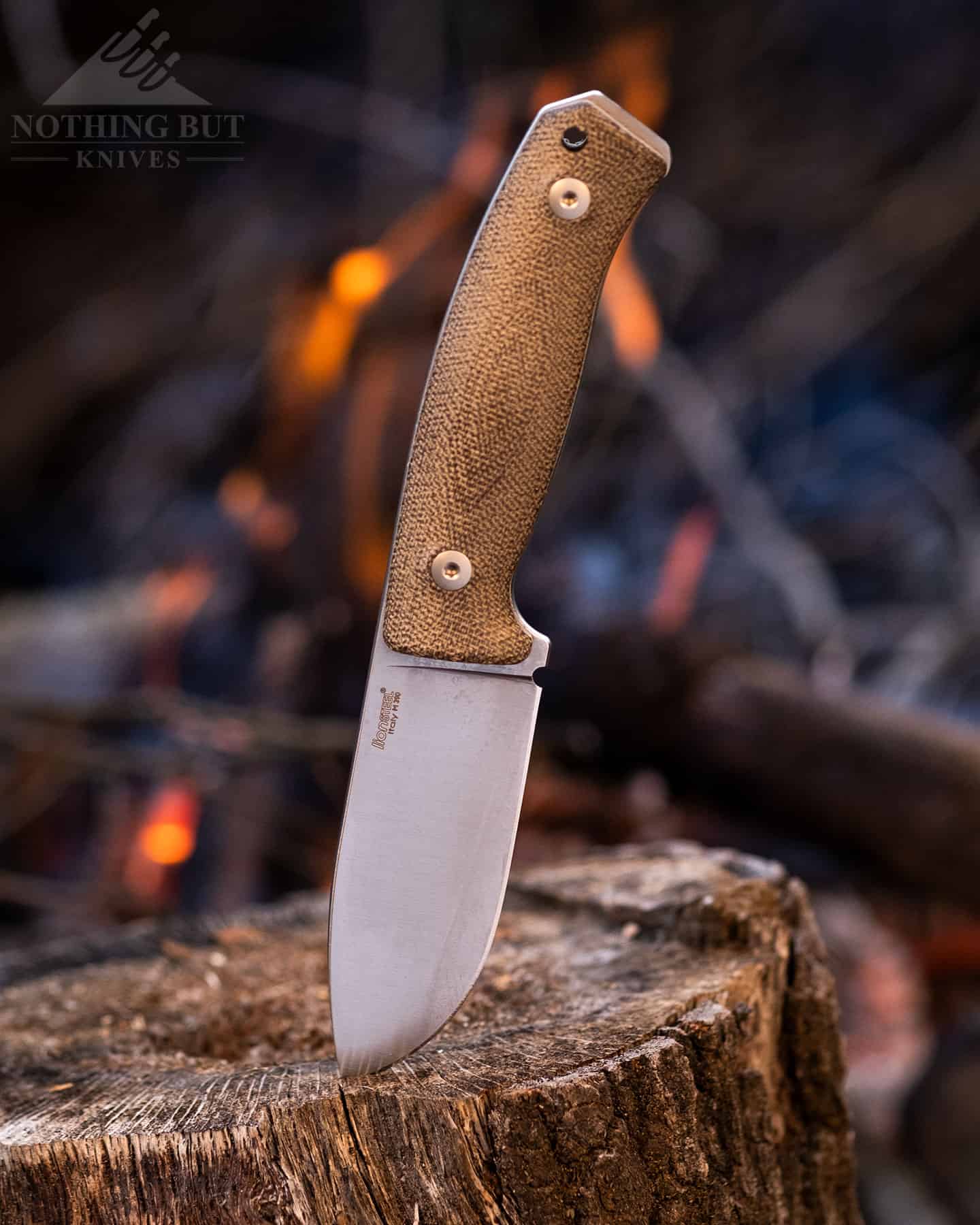
| Overall Length: | 7.99 |
| Blade Length: | 3.54” |
| Blade Steel: | Bohler M390 |
| Blade Style: | Drop point |
| Blade Grind: | Flat |
| Handle Material: | Micarta |
| Sheath: | MOLLE compatible leather |
| Made in: | Italy |
We loved the LionSteel M2. That was one of the few knives we bought almost entirely because we just liked the way it looked. The fact that it actually makes a good camping and skinning knife is a big plus.
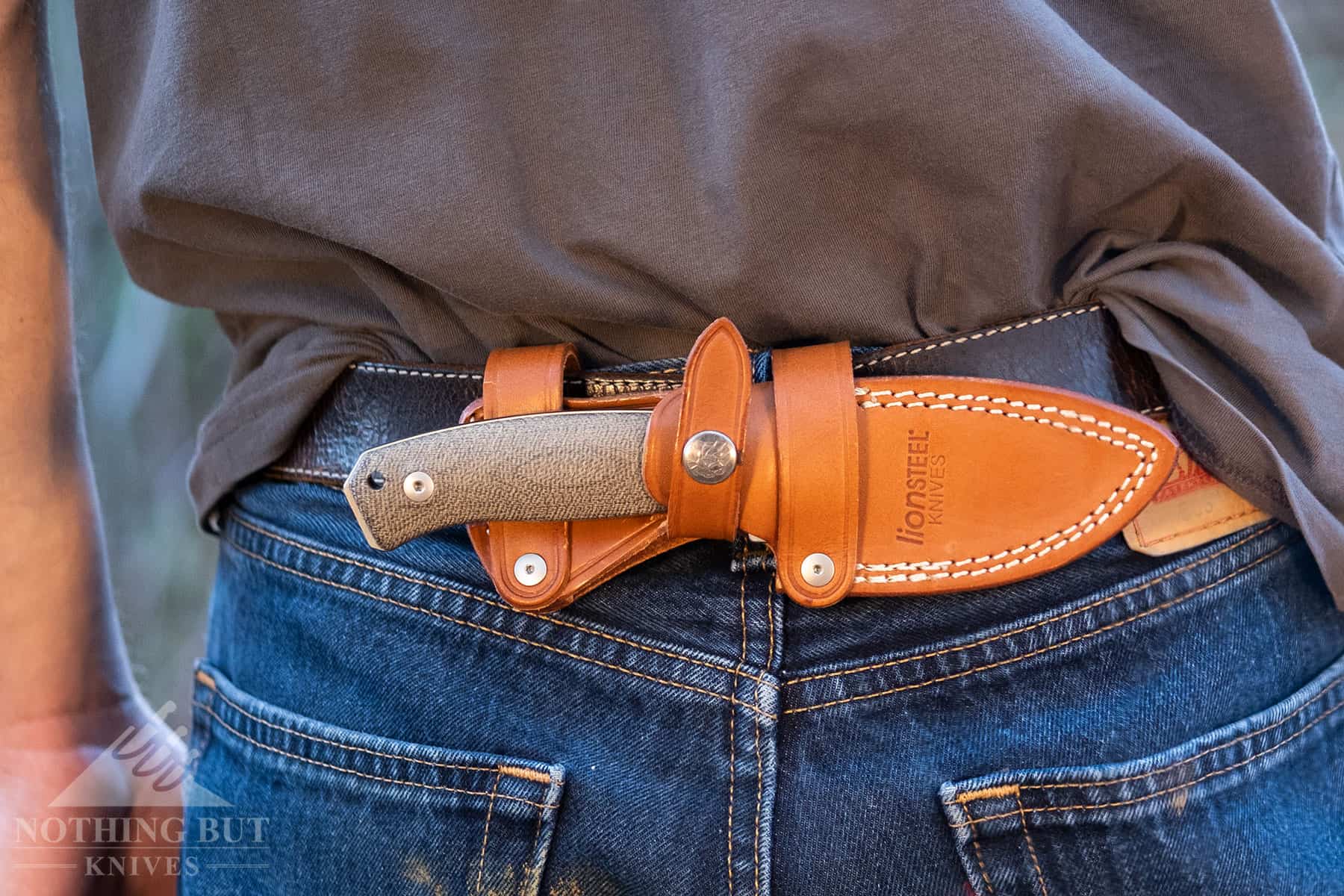
About the Sheath
Then LionSteel updated the M2 with big, comfy Micarta scales and a sturdier leather sheath that’s compatible with MOLLE systems.
Basically all that means is they bolted two thick straps in the horizontal position. That top strap is surprisingly versatile for all its simplicity, though. It rotates easily, so you can use it in a vertical-carry position that was actually pretty comfortable for me.
One issue is that the straps are set up so you can only scout carry it in the left-handed position. But for all its size, it sits very comfortably in front of the left hip. That’s become my preference.
Check out our in-depth review of the LionSteel M2M to learn more about this impressive mid-size fixed blade and its versatile sheath.
Off-Grid Hoglet
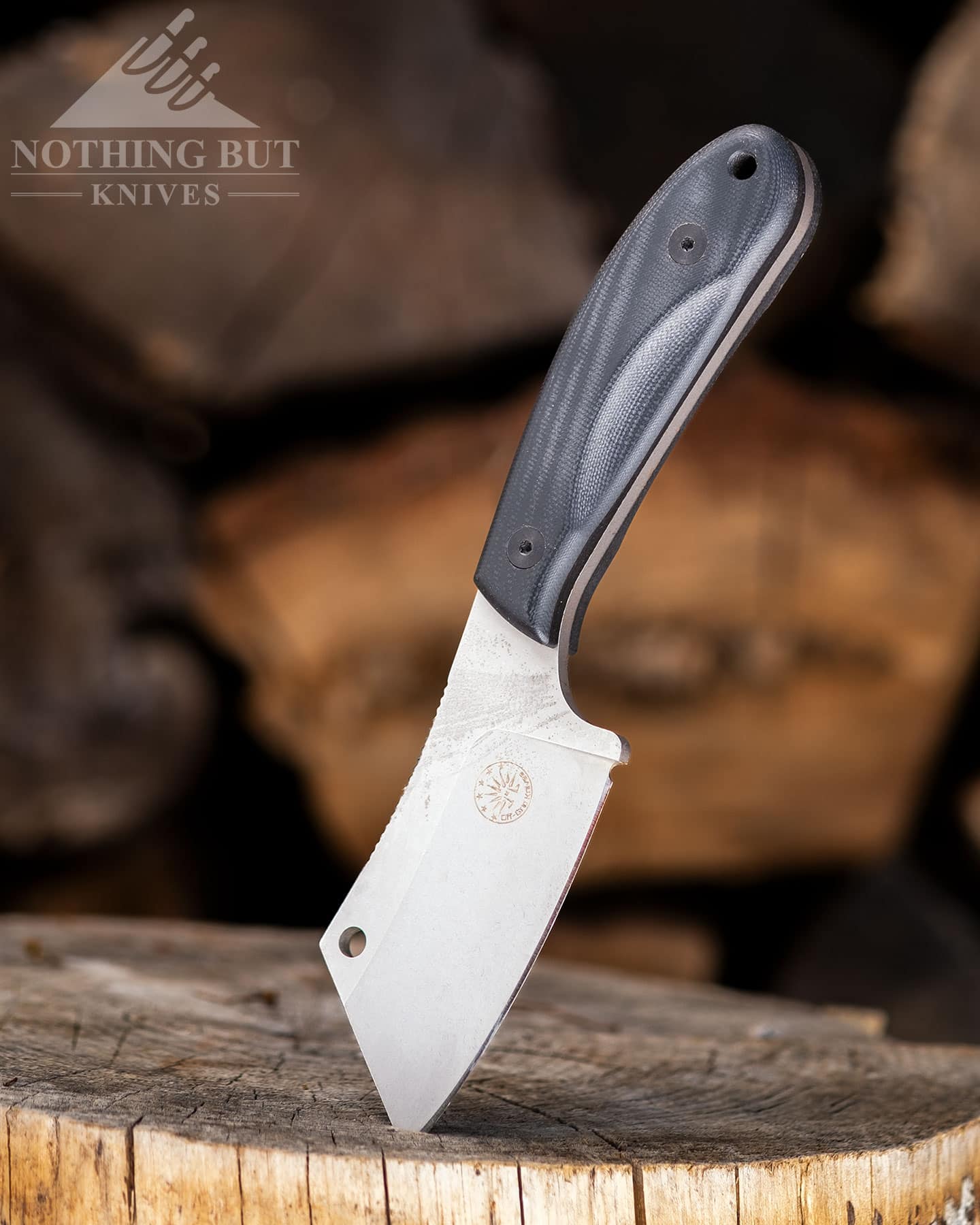
| Overall Length: | 6.5″ |
| Blade Length: | 2.75″ |
| Blade Steel: | Cryo D2 |
| Blade Style: | Cleaver |
| Blade Grind: | Flat |
| Handle Material: | G-10 |
| Sheath: | Kydex |
| Made in: | Taiwan |
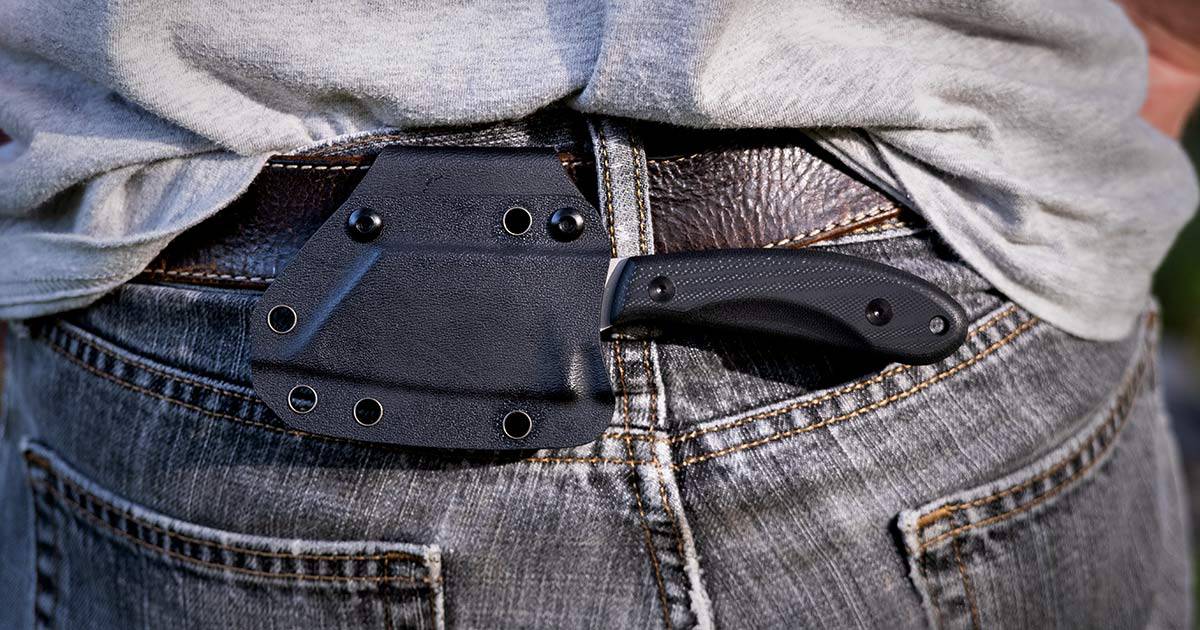
I’m generally not a big fan of cleaver-style fixed blade knives, but the Off-Grid Hoglet has made me reconsider.
The G-10 handle is incredibly comfortable. I thought maybe it was just a good size for my hand, so I had several other people with various hand sizes try it out. They all wanted to steal it. It is just a great design.
The cleaver style blade of the Hoglet is made from Off-Grid’s very capable Cryo D2 steel. This steel offers good edge retention and toughness at a moderate price. It’s become one of my favorite steels for hard-use because it just keeps cutting through abuse.
About the Sheath
The kydex sheath of the Hoglet has a wide G-style clip that can be set up for both left and right horizontal or vertical carry.
I wish more knife manufacturers would adopt this approach to sheath design, because it is super handy to have that kind of versatility. And the clip on this is pretty easy to move around. It only takes two screws, and I’ve never felt it sag or sit funny.
Spartan Blades Alala
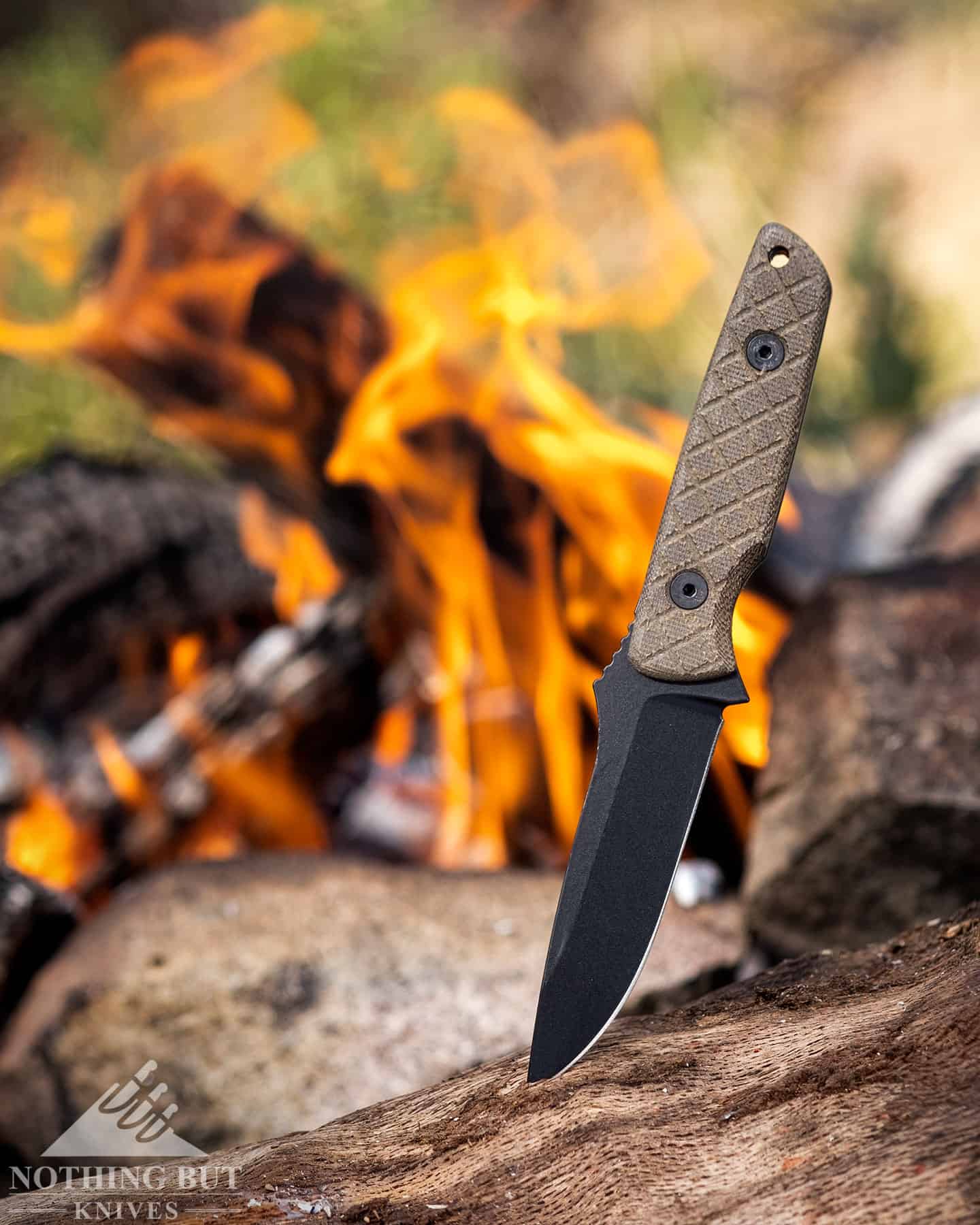
| Overall Length: | 7.875” |
| Blade Length: | 3.75” |
| Blade Steel: | 1095 Cro-Van |
| Blade Style: | Drop point |
| Blade Grind: | Flat |
| Handle Material: | Micarta |
| Sheath: | Polymer w/ retention lever & straps |
| Made in: | USA |
This is kind of a pry bar of a knife, but we loved using it as a camping and buscrafting tool, in spite of the fact that it was very clearly designed with military use in mind.
But it’s a small blade with thick blade stock, so you have to expect that edge to need a little but of work before it really sings. Edge geometry aside, the ergonomics of the Alala are beautifully thought out.
About the Sheath
If you’re looking for something to jump out of planes with, this is a pretty solid option. Curtis Lovito (the designer and co-owner of Spartan Blades) put a retention lever and a button strap on this to make it carry as securely as possible.
As for the horizontal carry aspect, there’s a little bit of nuance to discuss:
You can use the straps it ships with to carry the Alala on your belt. There are a series of holes on the belt strap that let you tighten it, and it’s fairly easy to do since it’s fastened with a phillips-head screw.
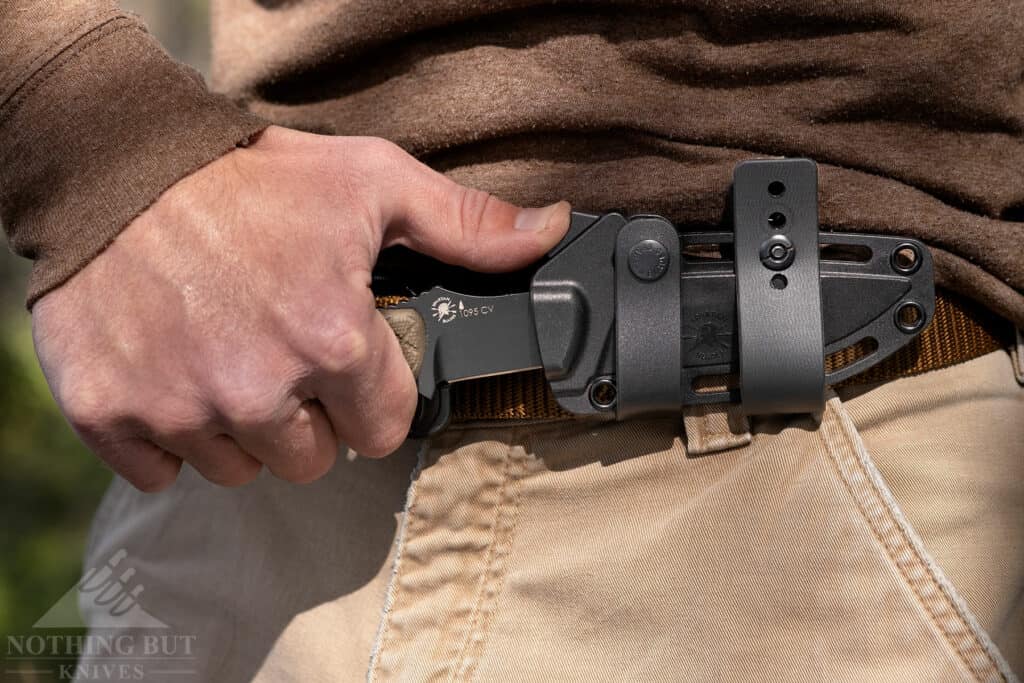
Once I got this tuned in to my nylon belt it became one of the best scout carries on my shelf. I know the picture shows me wearing it in front of the hip. At the time we shot the Alala for this blog that seemed like the best solution. But I’m wiser now. The small of the back is where it’s at for me with this thing.
But you should keep in mind that the retention strap can unbutton from both sides, and poses a higher-than-normal risk of coming undone if you’re hiking through dense terrain. That never happened to me as long as I wore it in the scout-carry position, and even if the retention strap fails, the other strap will keep it on your belt.
Of course, the easy solution is to just slap a small Tek-Lok on the thing. In the meantime, you can check out our full review of the Alala here.
White RIver Knives 3 & 4
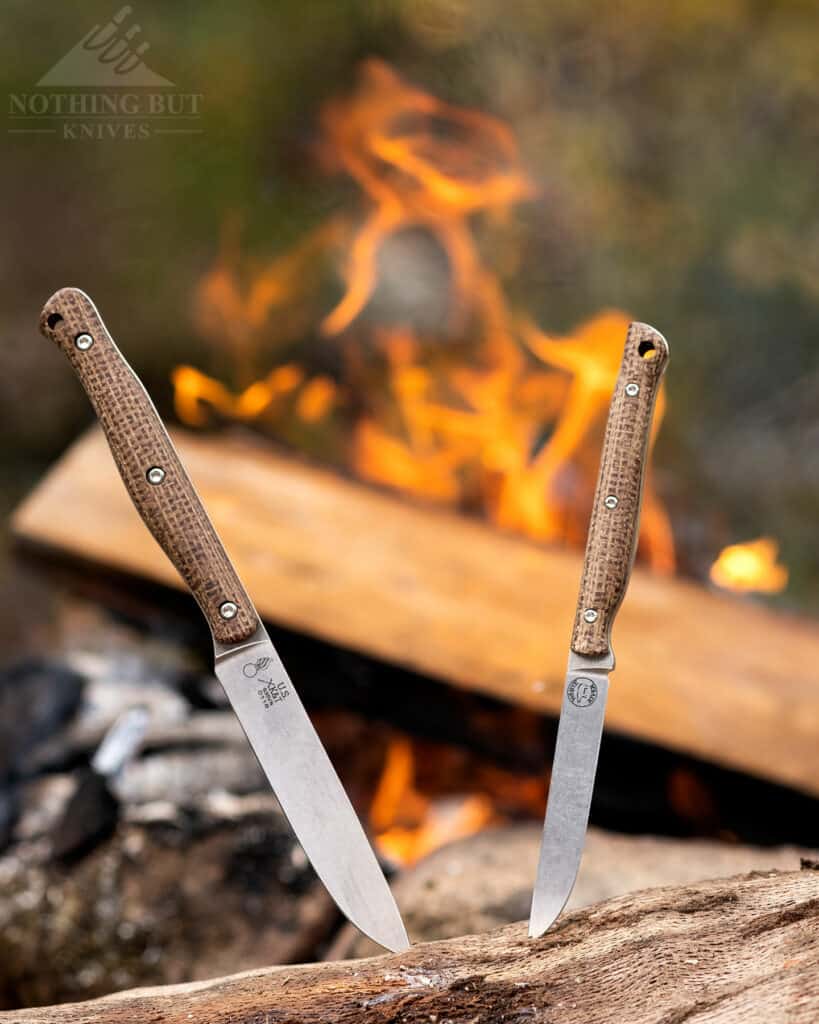
| Overall Length: | 7.2” / 8.5” |
| Blade Length: | 3.15” / 3.88” |
| Blade Steel: | CPM S35VN |
| Blade Style: | Drop point |
| Blade Grind: | Flat |
| Handle Material: | Micarta |
| Sheath: | Kydex w/ button strap |
| Made in: | USA |
This is actually about two knives of the same design but different sizes.
The Exodus 3 and 4 are both White River productions of Jacob Peterson’s Adventurecraft and Jackalope designs. The larger knife (Exodus 4 / Jackalope) is meant more for bushcraft and survival tasks where the smaller one (Exodus 3 / Adventurecraft) is meant to put the bushcraft-y design into a size that’s more EDC-friendly.
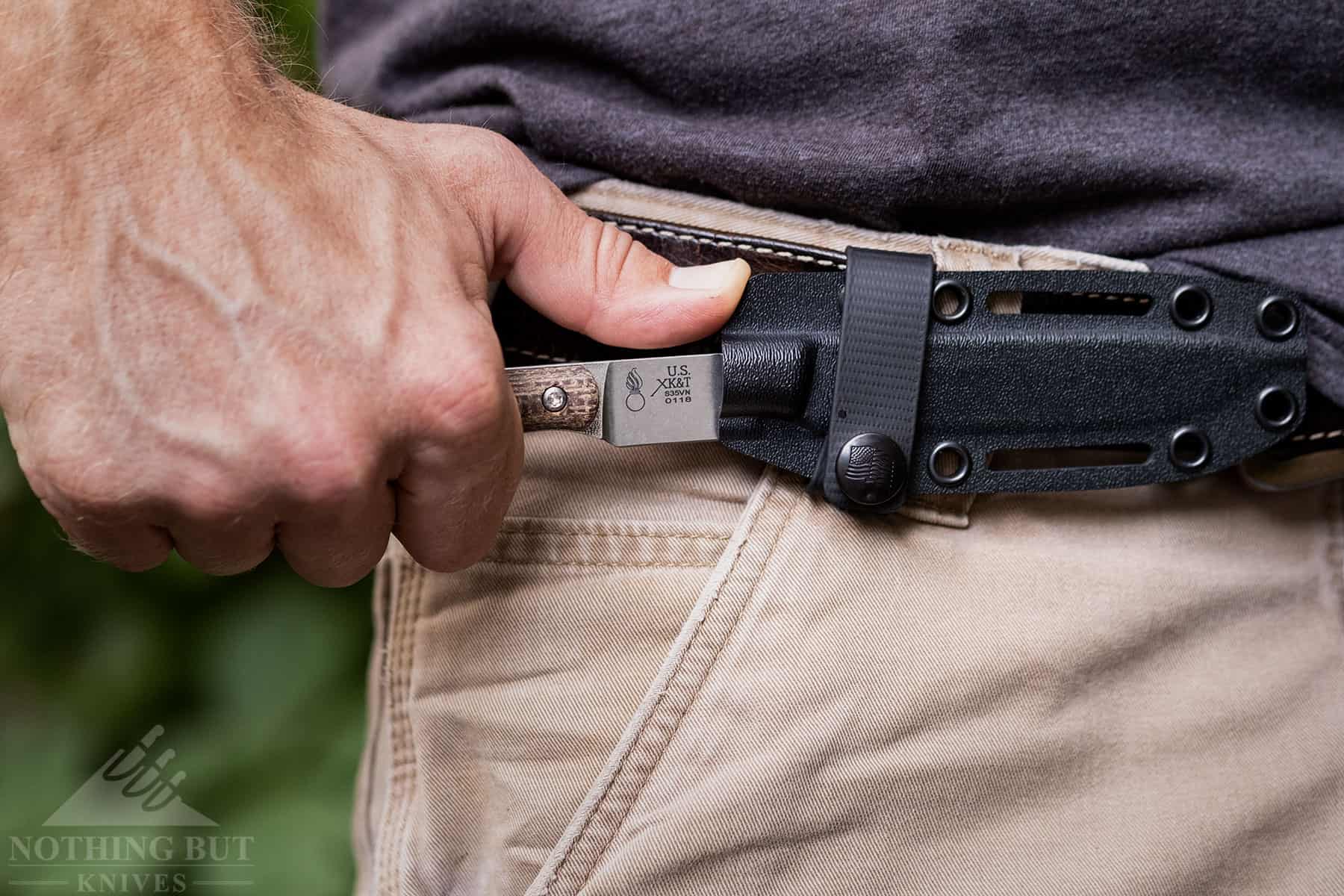
About the Sheath
Both knives come in a kydex sheath with a single button strap, which isn’t exactly ideal for the belt, but for knives this light, it works pretty well.
If you’re going to carry either of these knives horizontally, I highly recommend moving the leather strap up to the highest hole on the sheath (I’m pretty sure the Exodus 4 comes that way). That will help balance out the weight so the handle doesn’t sag so much, and it’ll make it feel a little nicer on the belt.
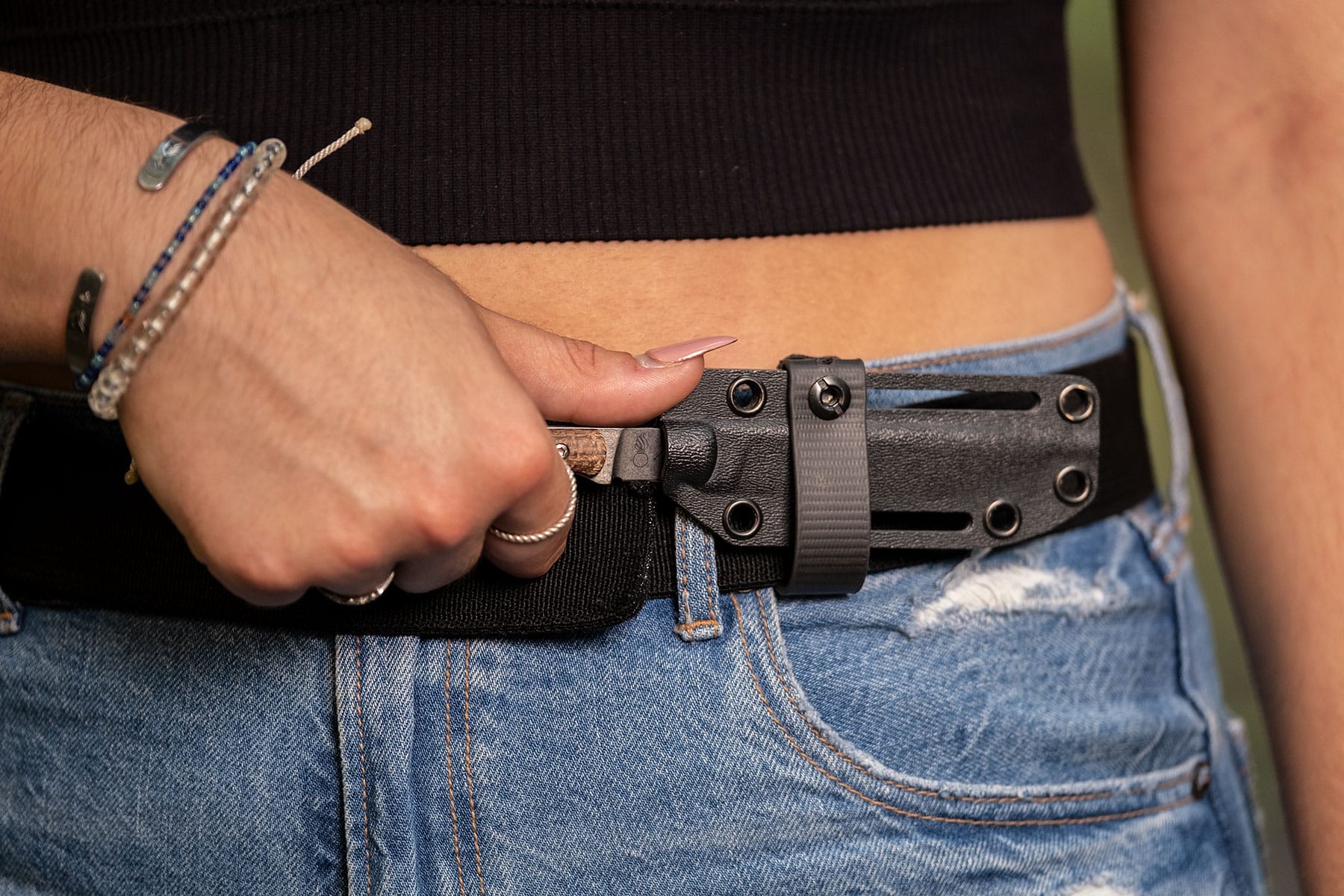
Overall I like the Exodus 3 better for horizontal carry. It’s lighter and better balanced for it, but this can become a debate of body types pretty quickly, so we figured it would be best to throw both in here.
You can read more about the Exodus 4 in our full review here.
Kizer Smolt – 2024 Addition
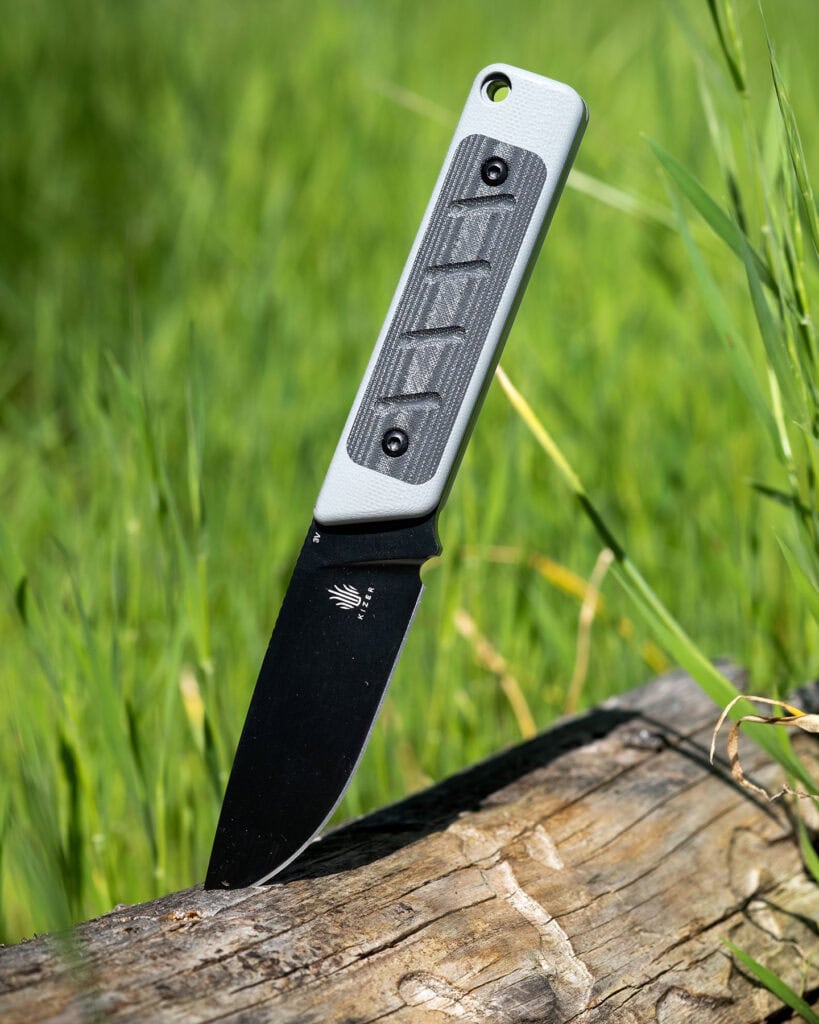
| Overall Length: | 6.5” |
| Blade Length: | 2.93” |
| Blade Steel: | 3V |
| Blade Style: | Drop point |
| Blade Grind: | Flat |
| Handle Material: | G10 w/ Micarta insert |
| Sheath: | Kydex |
| Made in: | China |
| Designer: | Jonathan Styles |
The Smolt falls comfortably into the compact-knife category. It has a slim, neutral handle, a small drop point blade with a full flat grind, and a sheath that you could slip into your back pocket.
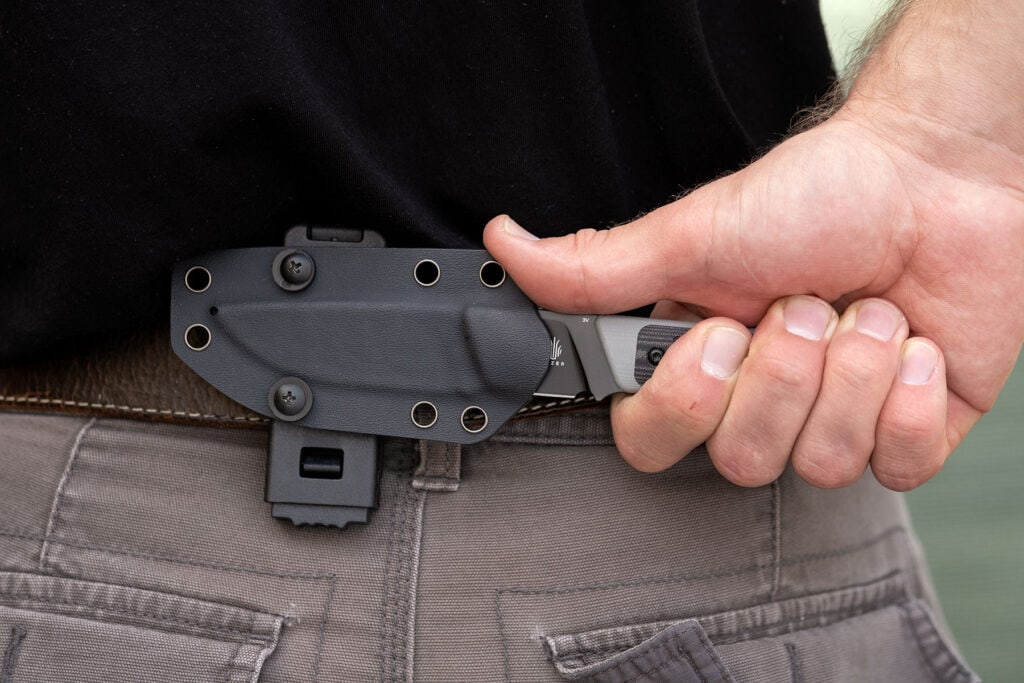
It was designed by Jonathan Styles of Newfoundland Knife Co. His other Kizer collaboration credits include the Militaw and Ti’an folders, and the Sou’Wes and Elgon fixed blades. This is definitely the smallest design he’s put out so far, but between the thin grind and the 3V steel, it’s still a strong little cutter.
About the Sheath
This features a thinner clip with a button mechanism that works in a similar way to a Tek-Lok or Civivi’s T-Clip. It handles the weight of the knife well, and it has two spacers inside so you can adjust the fit for different belt widths.
With both spacers in there’s about 1.5 inches of space. With both spacers removed there’s a little over 2.25 inches, so it can fit over a broad range of belts and systems.
It’s easy to switch since it only has two screws that you can get with a Phillips head screwdriver, but the hole spacing is a little awkward for horizontal carry. The clip won’t sit flush against the sheath the way it does in the vertical position, but it’ll still ride securely so long as you make sure you get both screws back in evenly.
You can find more photos and hands on opinions about this compact EDC fixed blade by checking out our Kizer Smolt Photo Tour and Review.
Tactical Fixed Blades
There are a lot of knives made for horizontal carry under the “tactical” category, but most of the time it feels more like a gimmick than an actually functional design (either that or a copy). But when it’s done well, it’s hard to beat the comfort and adaptability of a tactical horizontal carry.
CRKT Ramadi
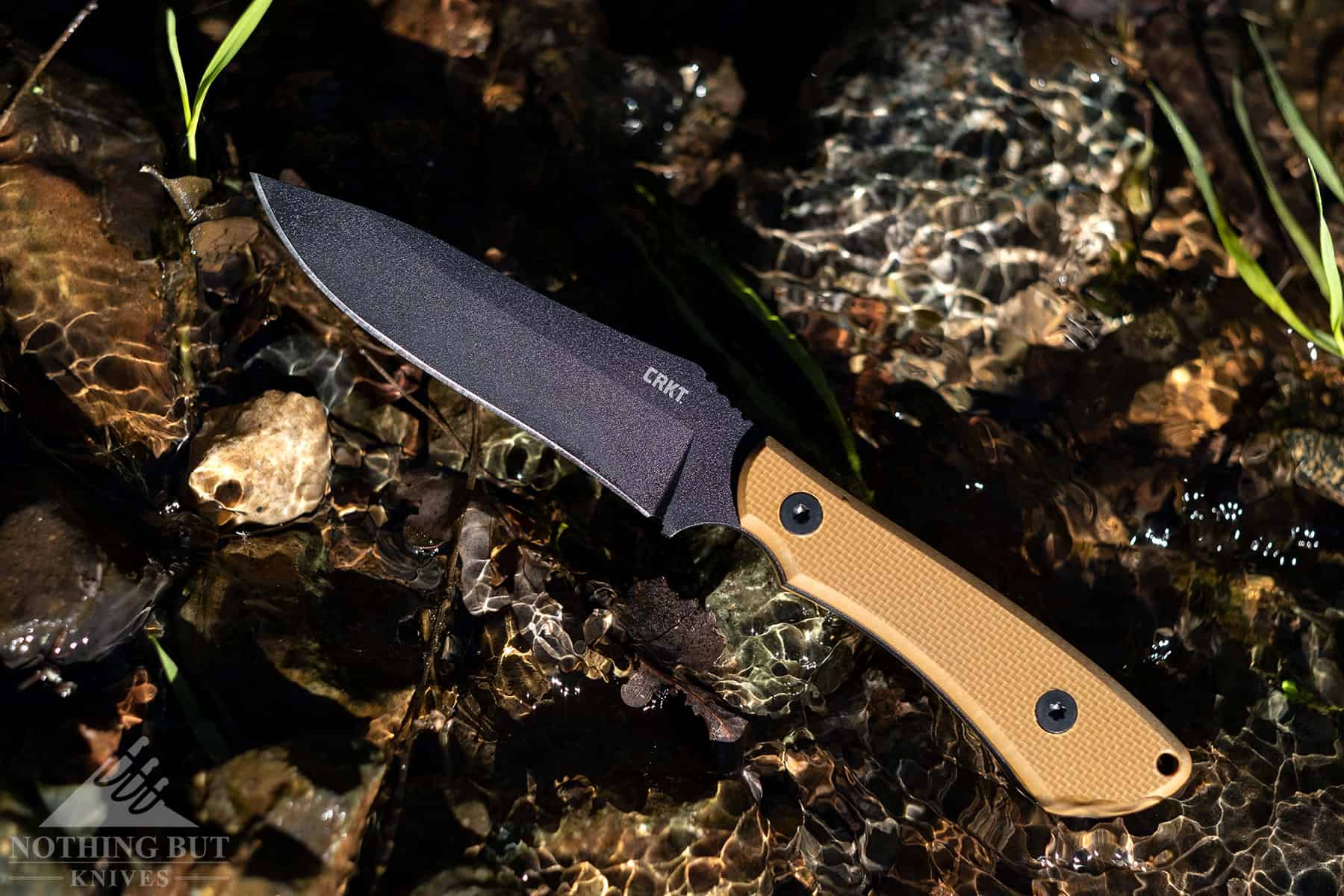
| Overall Length: | 8.5″ |
| Blade Length: | 4.37″ |
| Blade Steel: | SK-5 |
| Blade Style: | Drop point |
| Blade Grind: | Flat |
| Handle Material: | G-10 |
| Sheath: | Polymer |
| Made in: | China |
The Ramadi is part of CRKT’s Forged By War series of knives which were all designed by veterans with combat experience. A portion of the proceeds from this series of knives are donated to the veteran’s charity of the designer’s choice.
This Ramadi was designed by Special Ops veteran, Darren William Sirois who also designed the CRKT Siwi which appears further down in this article.
This knife is obviously a tactical-first tool, but it is also a capable camping or backpacking knife too thanks to it’s grippy G-10 scales, versatile sheath, and tough SK-5 steel blade. At an overall length of 8.5 inches the Ramadi hits the sweet spot from a size standpoint for a survival or camping horizontal carry knife. It is just big enough to be useful for a variety of tasks, but not quite big enough to feel cumbersome or catch on branches along the trail.
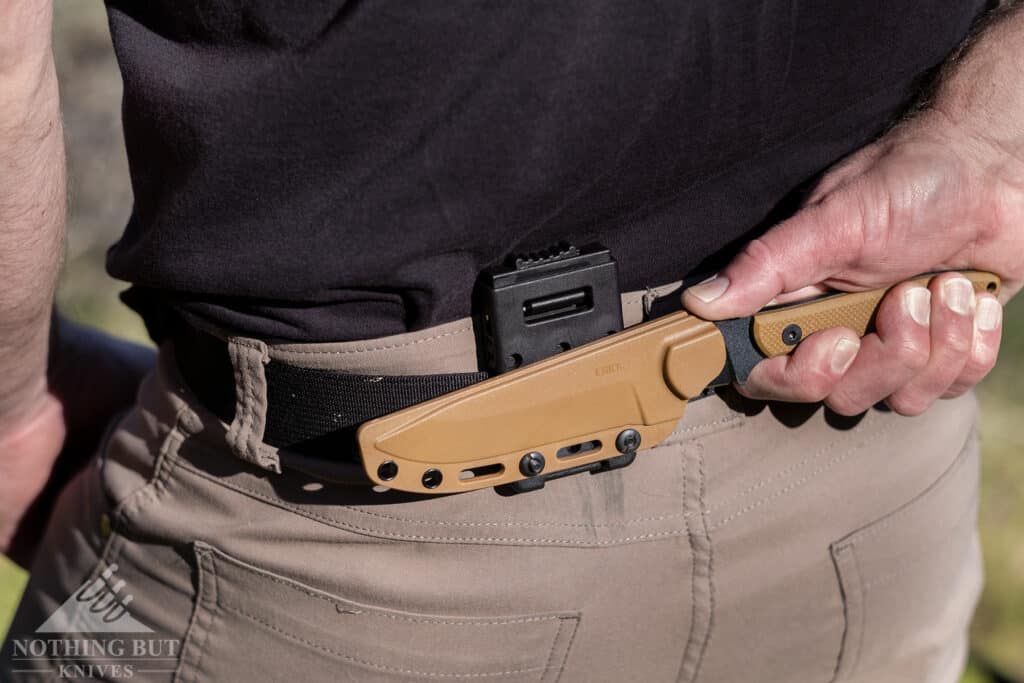
About the Sheath
The sheath with a button-open clip that pretty much works like a Tek-Lok, so it’s extremely versatile and easy to adjust and switch around. It can be used in left or right horizontal or vertical carry.
There’s also something about the way the sheath and handle are shaped that makes deployment feel faster. The Ramadi shifts right into a firm grip out of the sheath, so I almost never have to adjust before I start cutting with it
If you want to read a bit more about this knife or check out some action shots, jump over to our in-depth review of the CRKT Ramadi.
CRKT S.P.E.W.
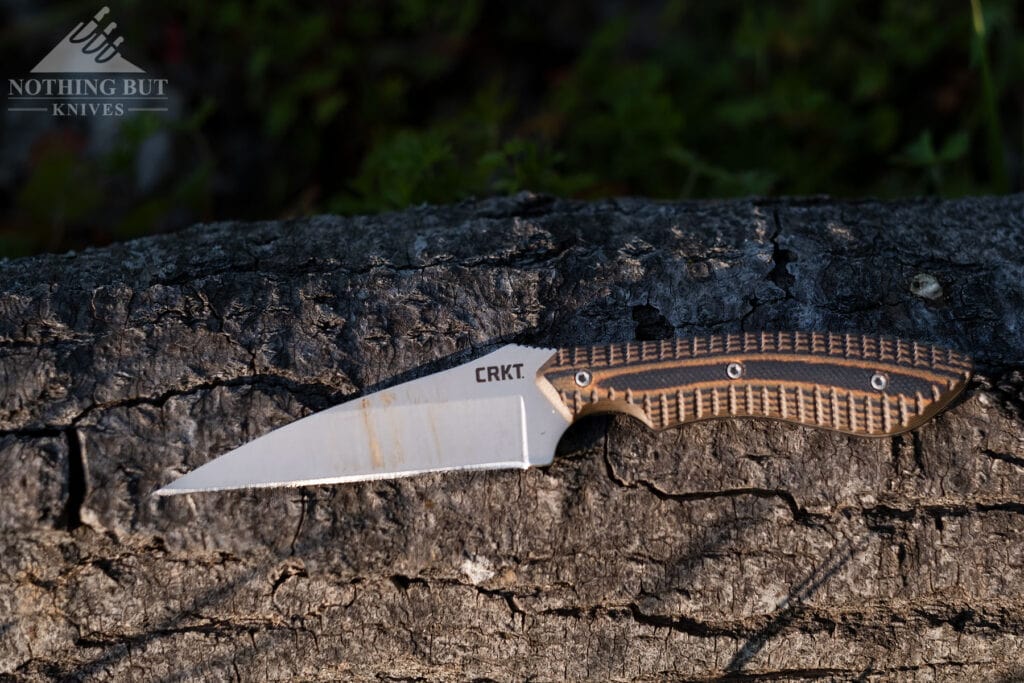
| Overall Length: | 6.19″ |
| Blade Length: | 3.0″ |
| Blade Steel: | 5Cr15MoV |
| Blade Style: | Wharncliffe |
| Blade Grind: | Hollow |
| Handle Material: | G-10 |
| Sheath: | GRN |
| Made in: | China |
This is probably the most subtle knife on this list, and certainly the one I’ve carried the most.
The name stands for “Small Pocket Everyday Wharncliffe”, and that pretty well summarizes its scope. You can use this little thing on all kinds of daily tasks around the house, and a few more out in the bush, although I’d rather not count on it for survival.
It makes a great fishing knife, and thanks to the size and weight you can carry it pretty much anywhere, including your pocket. It’s also surprisingly comfortable for being so small. The handle is a great shape for larger hands. So far my fat fingers haven’t had too much trouble keeping a grip on the thing.
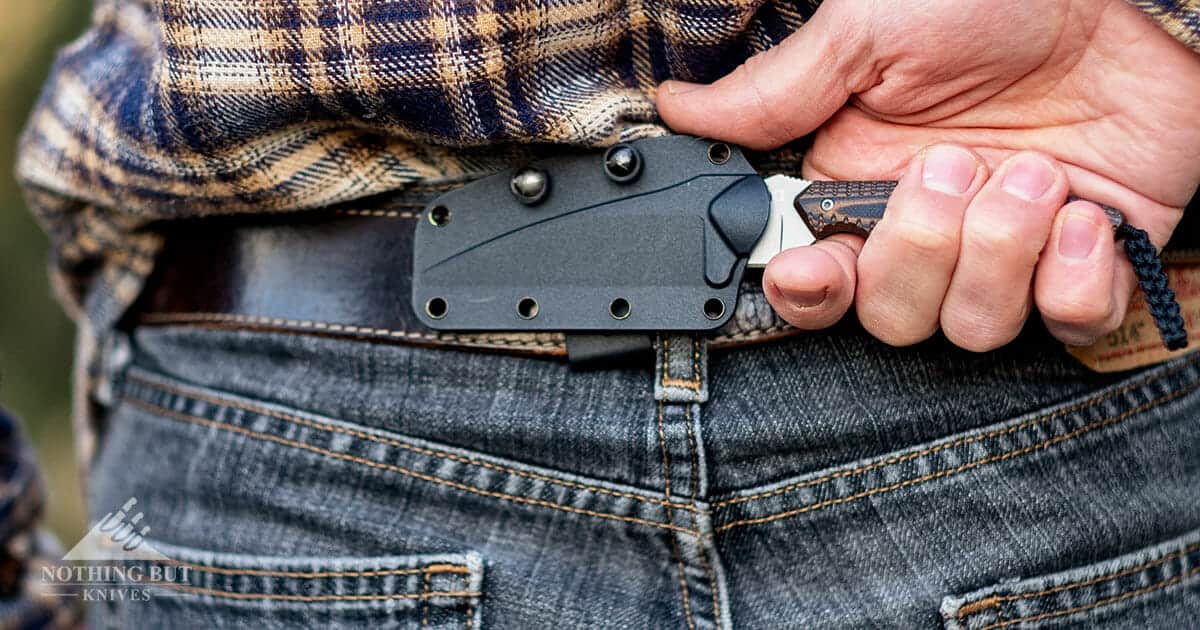
About the Sheath
A knife this small doesn’t need much for the belt loop to work well. This mounts up with a couple screws and you’re good to go. The handle does tend to stick out pretty far from the sheath, but the overall length keeps that from becoming an issue most of the time.
Click here to read our in-depth review of the CRKT Spew.
SOG Altair FX
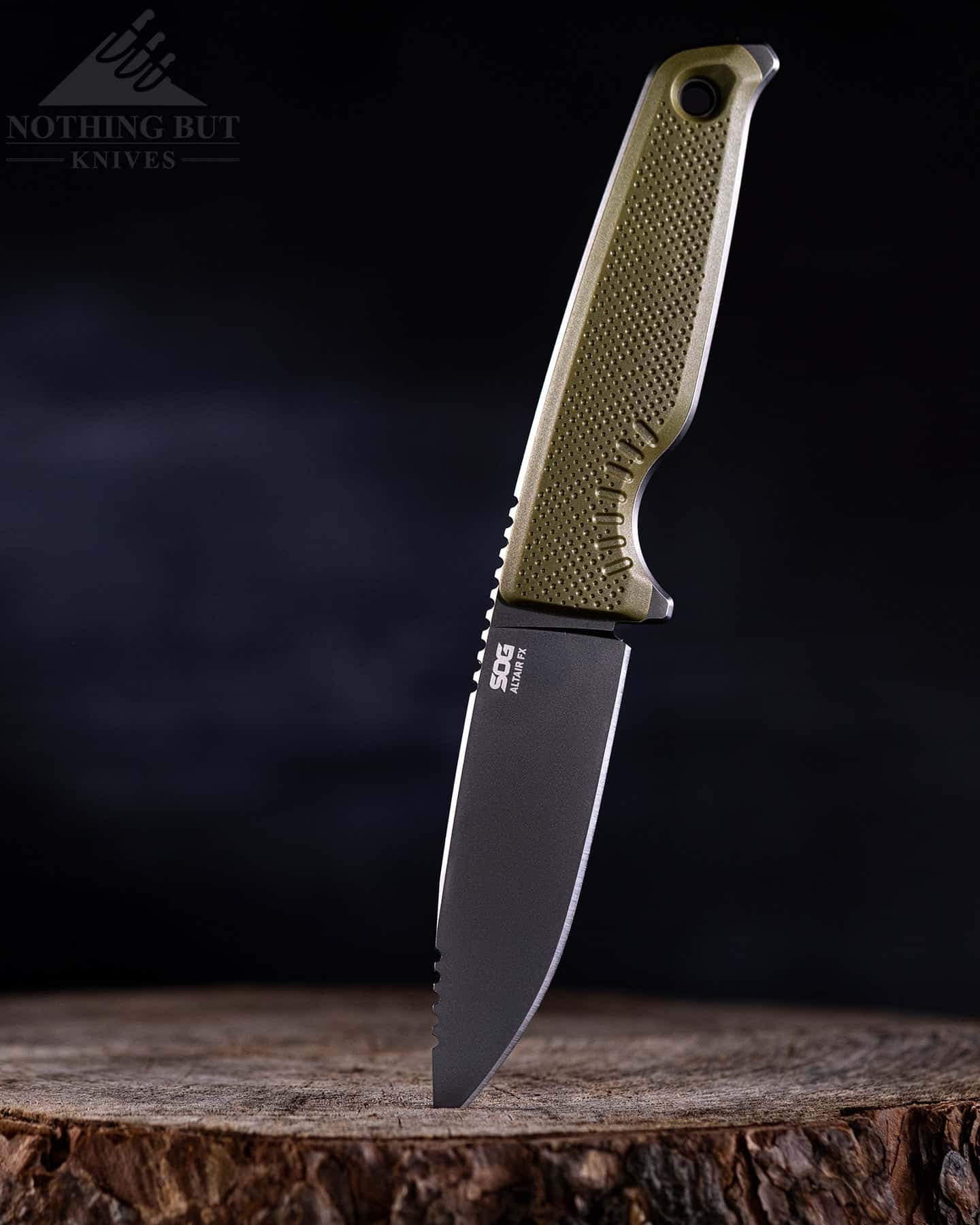
| Overall Length: | 7.6” |
| Blade Length: | 3.63” |
| Blade Steel: | 154CM |
| Blade Style: | Drop point |
| Blade Grind: | Flat |
| Handle Material: | GRN |
| Sheath: | GRN w/ Universal Mounting System |
| Made in: | Taiwan |
The Altair FX is another fixed blade adaptation of a folder.
In this case, though, SOG took a model that’s generally seen as tactical and geared the fixed design more toward hunting and backpacking. It has an aggressive, toothy edge, and the drop point blade is fantastically thin. The whole package is amazingly lightweight at about 4 oz total. The knife alone is around 2.8 oz, which is an impressive weight-to-blade ratio.
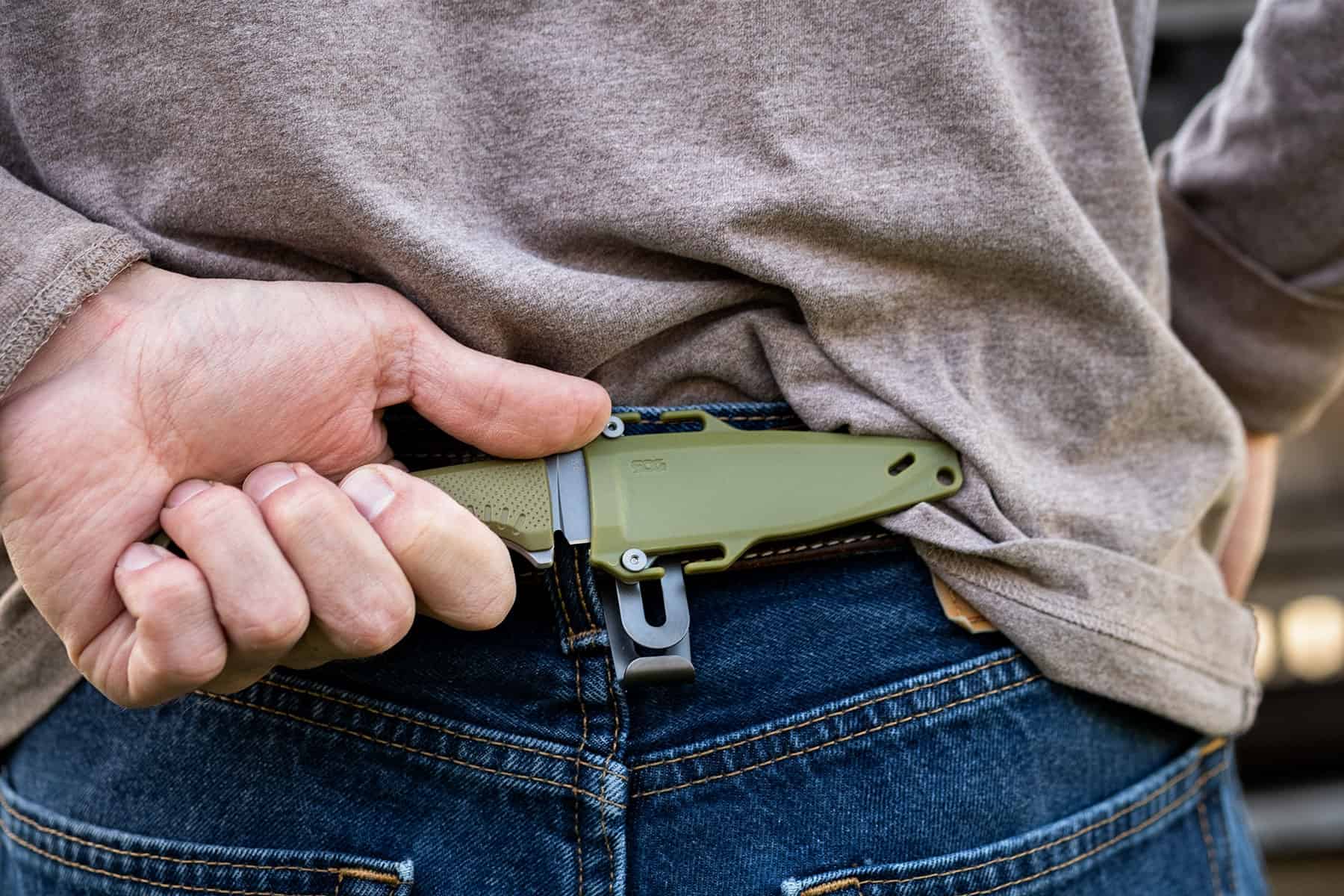
About the Sheath
SOG’s Universal Mounting System makes the Altair FX an especially attractive belt-carry knife. It’s basically a triangular piece with a hole at each end, and a Y-pattern cutout with a divot between each arm, allowing a full clock rotation of positions for the belt loop to be set into.
The whole thing can be adjusted and moved around with a T8 torx driver, and you don’t even need to remove any of the screws to switch the sides or adjust the angle. Just loosen a few things up and you’ll be able to move it around however you like.
Getting everything where you want it and fully tightened down can become a bit of a logic puzzle, but the versatility provided by the system is pretty phenomenal once you acclimate to the nuance of it.
Kizer Azo Baby
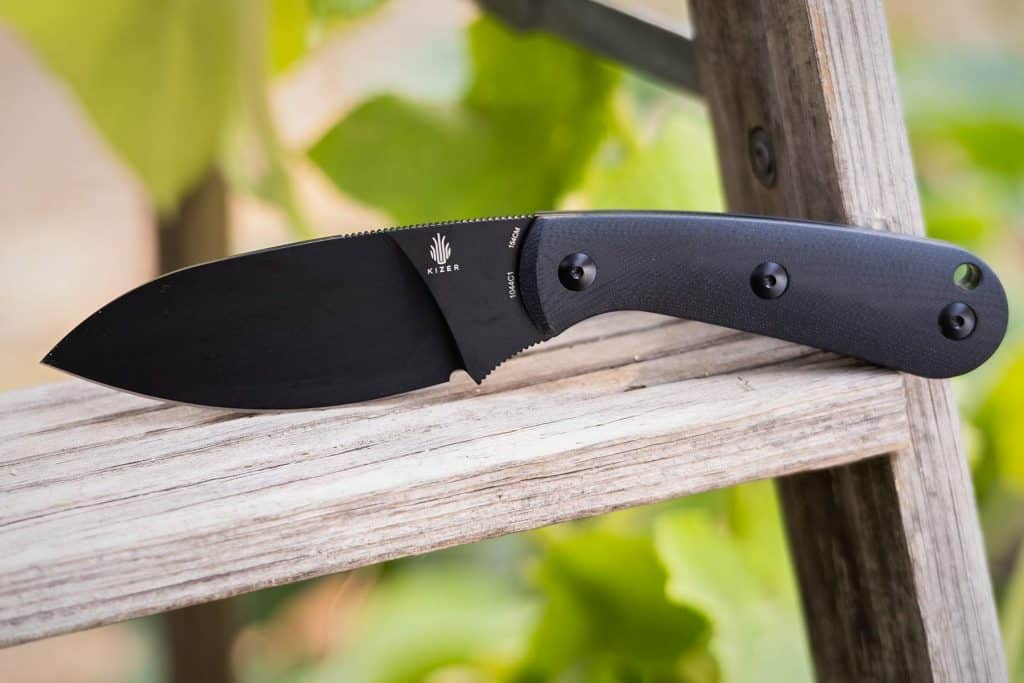
| Overall Length: | 7.125″” |
| Blade Length: | 3.5″ |
| Blade Steel: | 154CM |
| Blade Style: | Drop point |
| Blade Grind: | Flat |
| Handle Material: | G-10 |
| Sheath: | Kydex |
| Made in: | China |
| Designer: | Azo |
There is a lot to like about the Azo Baby. It has excellent fit and finish, high end steel, and a comfy handle. And it has a pretty neat, almost Shilin-cutter style going on.
The blade is a little taller than usual for this size, and couple with the full flat grind it has a nice, smooth cutting action. The forward angling of the blade also makes certain kinds of cuts more comfortable since you don’t need to bend the wrist as much to get full contact with the edge.
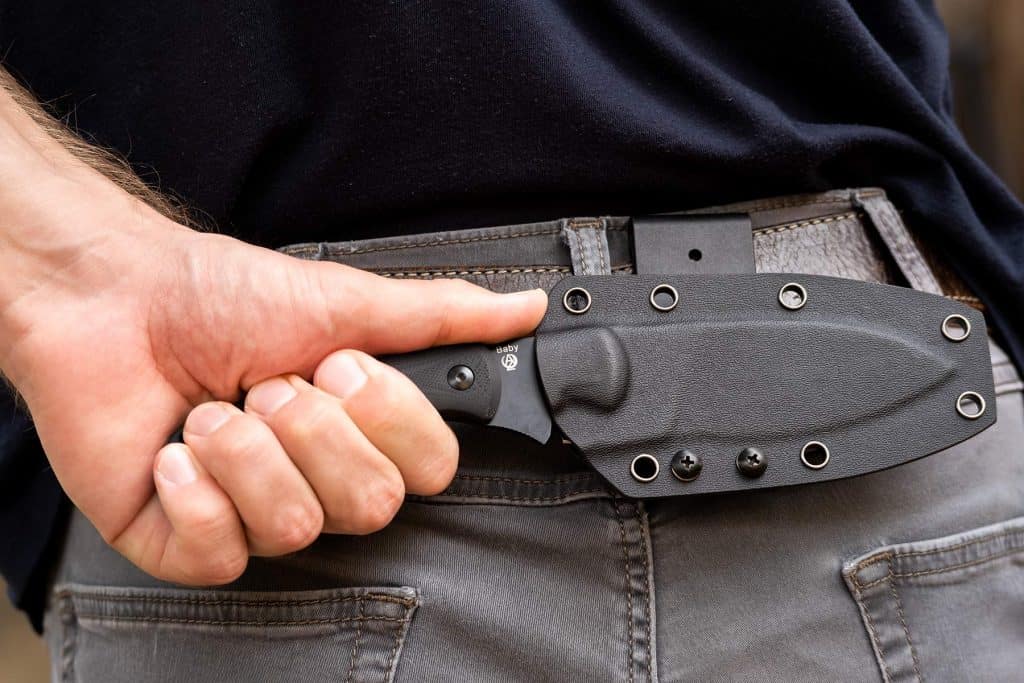
About the Sheath
Of course the main reason it makes this list is because it has an insanely simple and effective adjustment system on the sheath.
They’ve cut a curving track into the plate that one of the mounting screws can travel along. Just loosen that screw a little, shift the knife up or down until it’s at the exact angle you want, then tighten the screw back down.
The Azo Baby is also a great size for scout carry even for those with smaller waists because it sits so deep in the sheath. The handle doesn’t stick out quite as much as other knives the same length. And it sits low enough that it never digs into the wearers back.
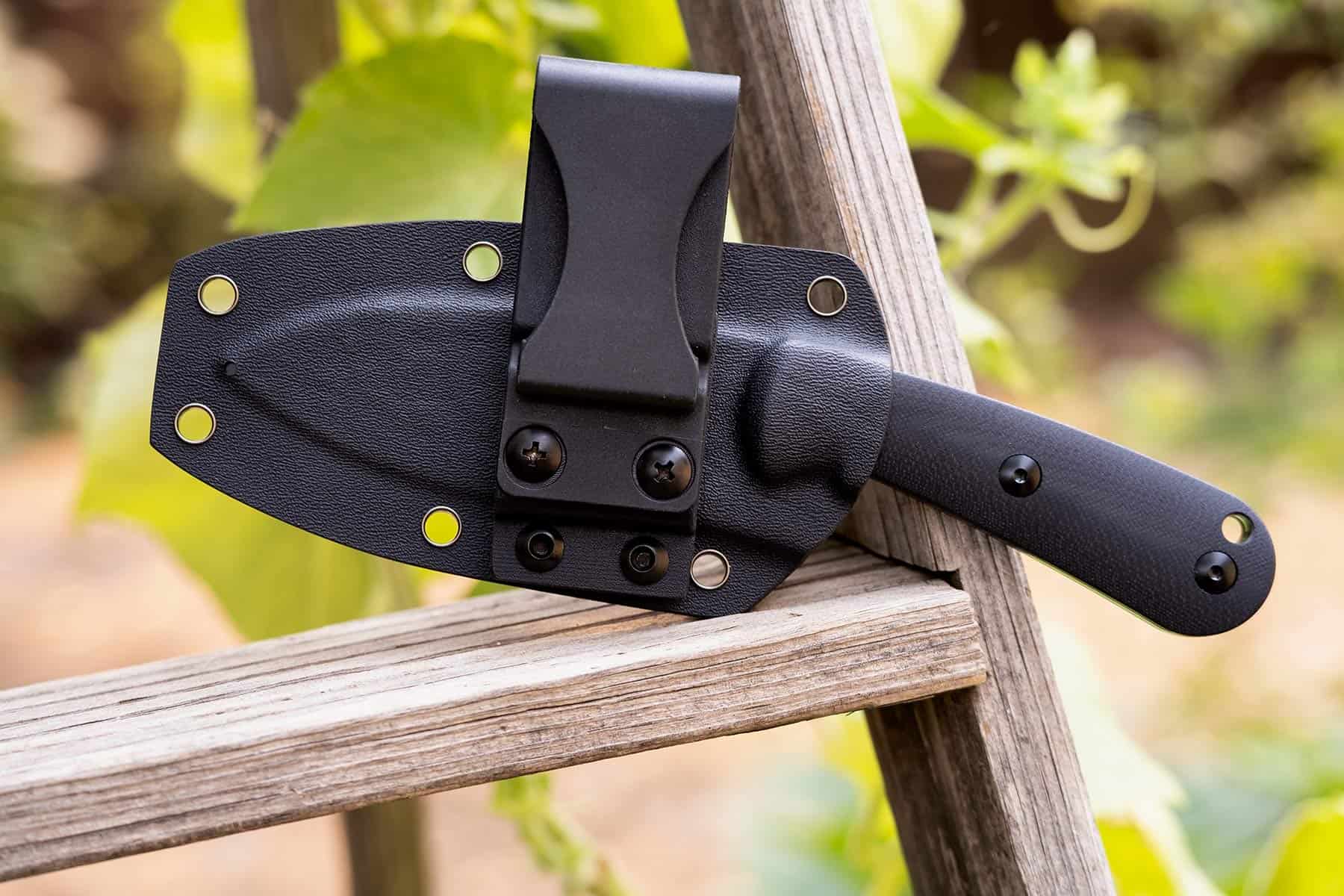
The curve of the knife can make drawing feel a little odd at first, but that’s easy to get over with a little practice, especially once find the right angle to set it at.
TOPS 3 Pointer
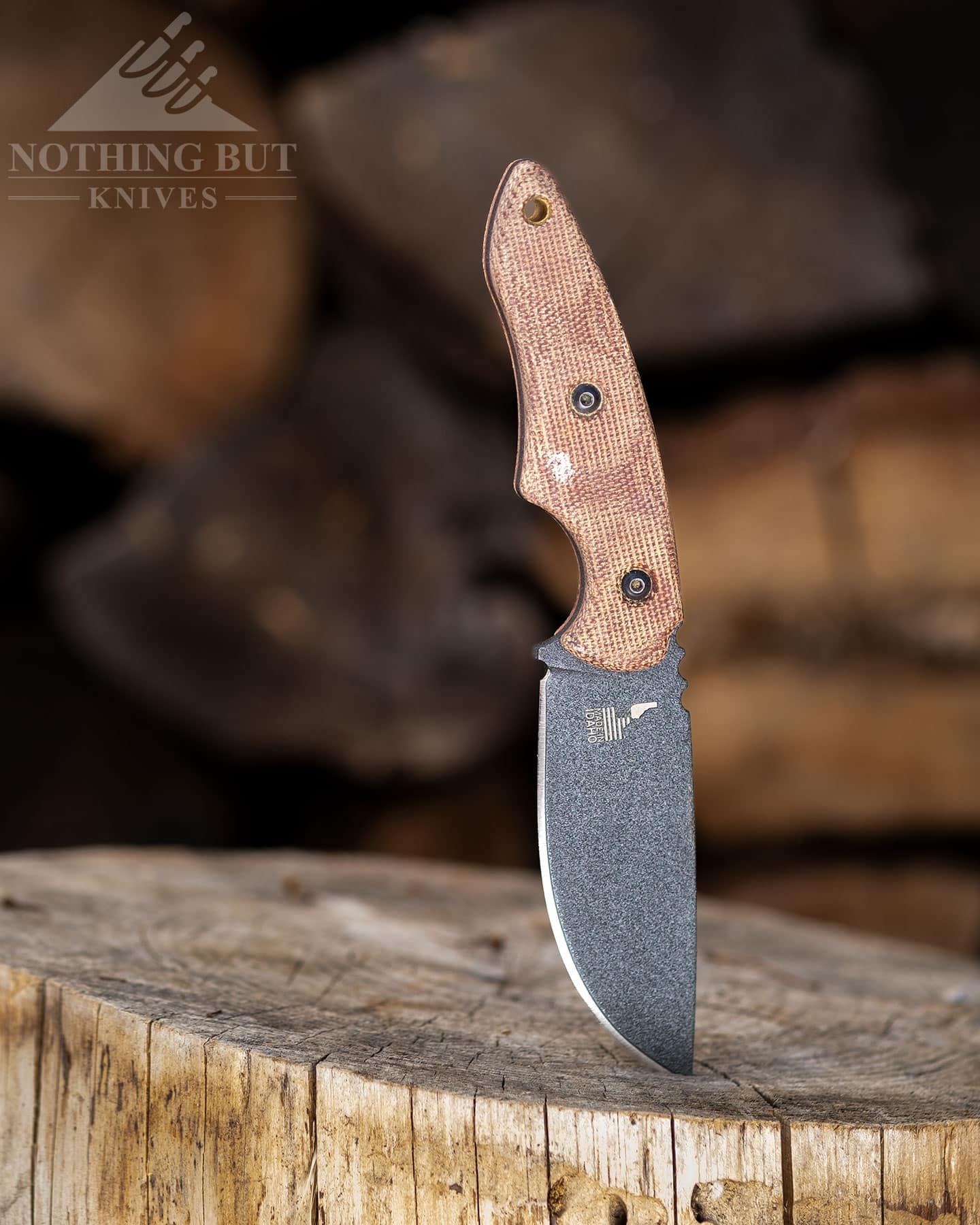
| Overall Length: | 6.63″ |
| Blade Length: | 3.13″ |
| Blade Steel: | 1095 |
| Blade Style: | Drop Point |
| Blade Grind: | Flat |
| Handle Material: | Micarta |
| Sheath: | Kydex |
| Made in: | USA |
This Leo Espinoza designed fixed blade from TOPS is one of our favorite horizontal carry knives due to it’s practical size and the fact that it can also be carried as a neck knife.
When worn horizontally, the 3 Pointer can be carried behind the back in the left facing position or on the front in the right facing position.
We wish it was capable of ambidextrous carry in both front and back, but the fact that it can be carried as a neck knife helps make it one of the most versatile knives in this article.
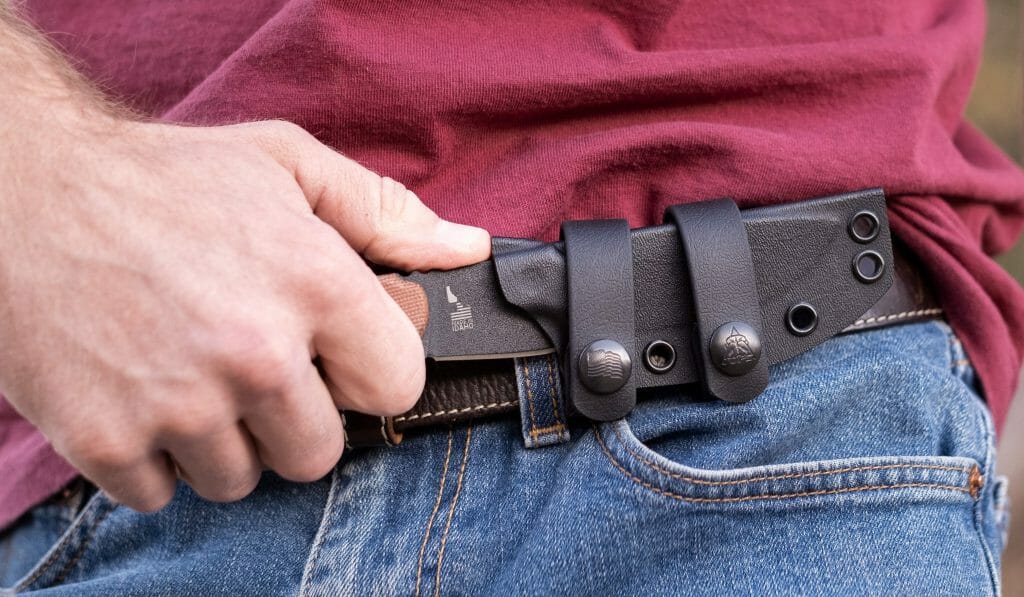
About the Sheath
The relatively large thumb ramp makes it easy to draw the 3 Pointer from its sheath with one hand. The straps that allow this knife to be worn on a belt or a backpack can be easily removed with a Phillips screwdriver if you decide you want to carry it as a neck knife or in a pocket with a lanyard attached.
The easily concealable size of the 3 Pointer combined with its super grippy micarta handles and tough 1095 steel blade make it a good tactical option. It also makes great work knife or small hunting knife. After several weeks of use the 3 Pointer has become one of our favorite small fixed blades for a variety of uses.
Gerber StrongArm
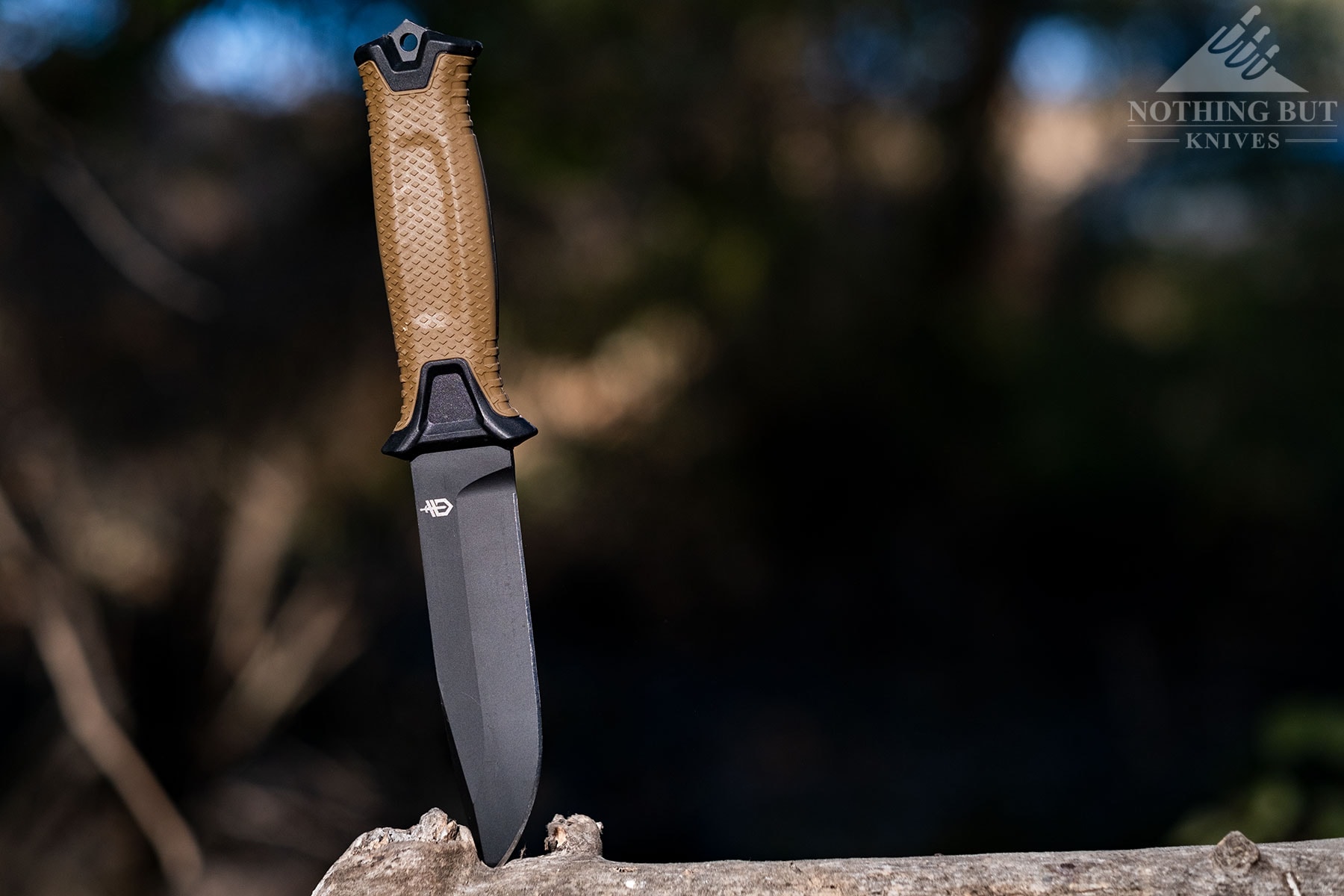
| Overall Length: | 9.75″ |
| Blade Length: | 4.9″ |
| Blade Steel: | 420HC |
| Blade Style: | Drop point |
| Blade Grind: | Flat |
| Handle Material: | Rubber |
| Sheath: | Molded polymer |
| Made in: | USA |
It might take some fiddling, but the StrongArm is pretty solid as a horizontal knife.
Gerber has done their best to make it adaptable. While as a rule I consider most tactical knives to be stupid, I do like the big rubber handle and plain edge on this knife. I feel like there aren’t enough survival and tactical designs out there that use rubber or rubber-like materials.
It adds miles of grip to a knife even in wet or dirty conditions, and reduces a lot of risk of slipping, which is especially great if you plan on needing to pull it out fast. I make it a point to never be somewhere I would need fast deployment, but I appreciate the option.
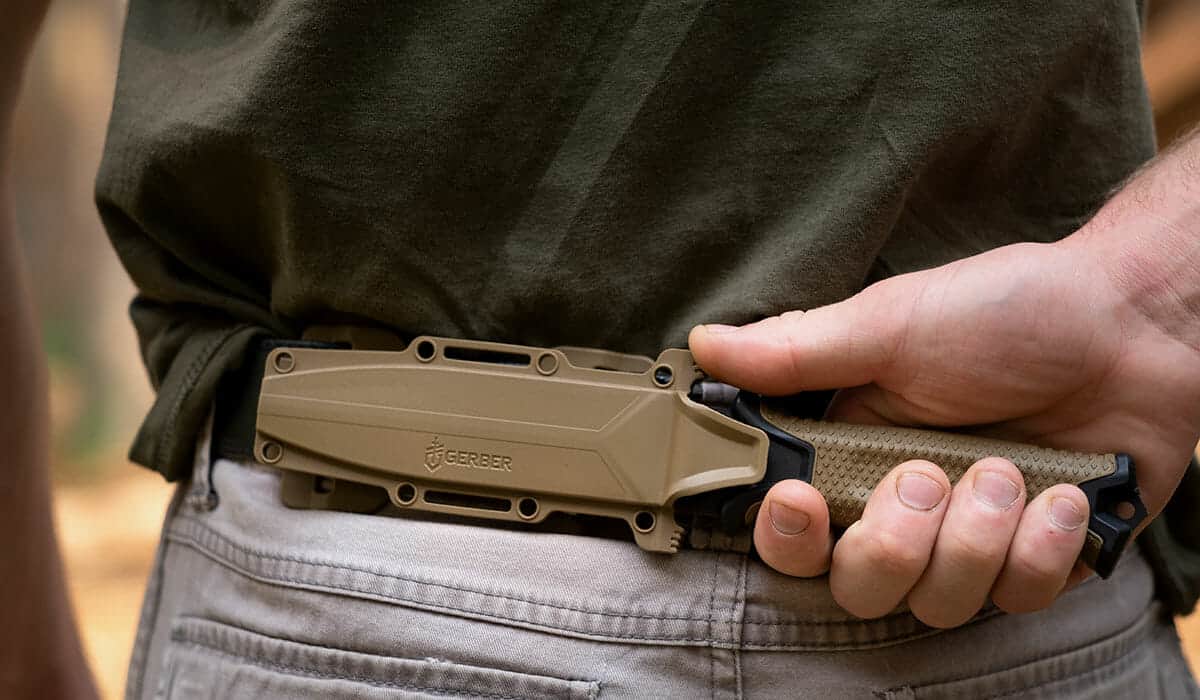
About the Sheath
The StrongArm sheath is ambidextrous and MOLLE compatible, so it is incredibly versatile.
It can be carried in the scout or front horizontal positions regardless of whether you are left or right handed. I wish Gerber would use similar setups on more of their fixed blade knives. I did discover that if you have a smaller waist the the StrongArm tends to bump into things.
The person pictured above has a 29-inch waist, and scout carry was a little problematic. A 32-inch waist seems to be less of an issue. I think the StrongArm is definitely one of the best knives on the market for attaching to a backpack, so if you are looking for a MOLLE compatible pack knife this one is tough to beat.
We are currently writing an in depth review of this knife, and we will post a link in this article when we are finished.
Civivi Tamashii
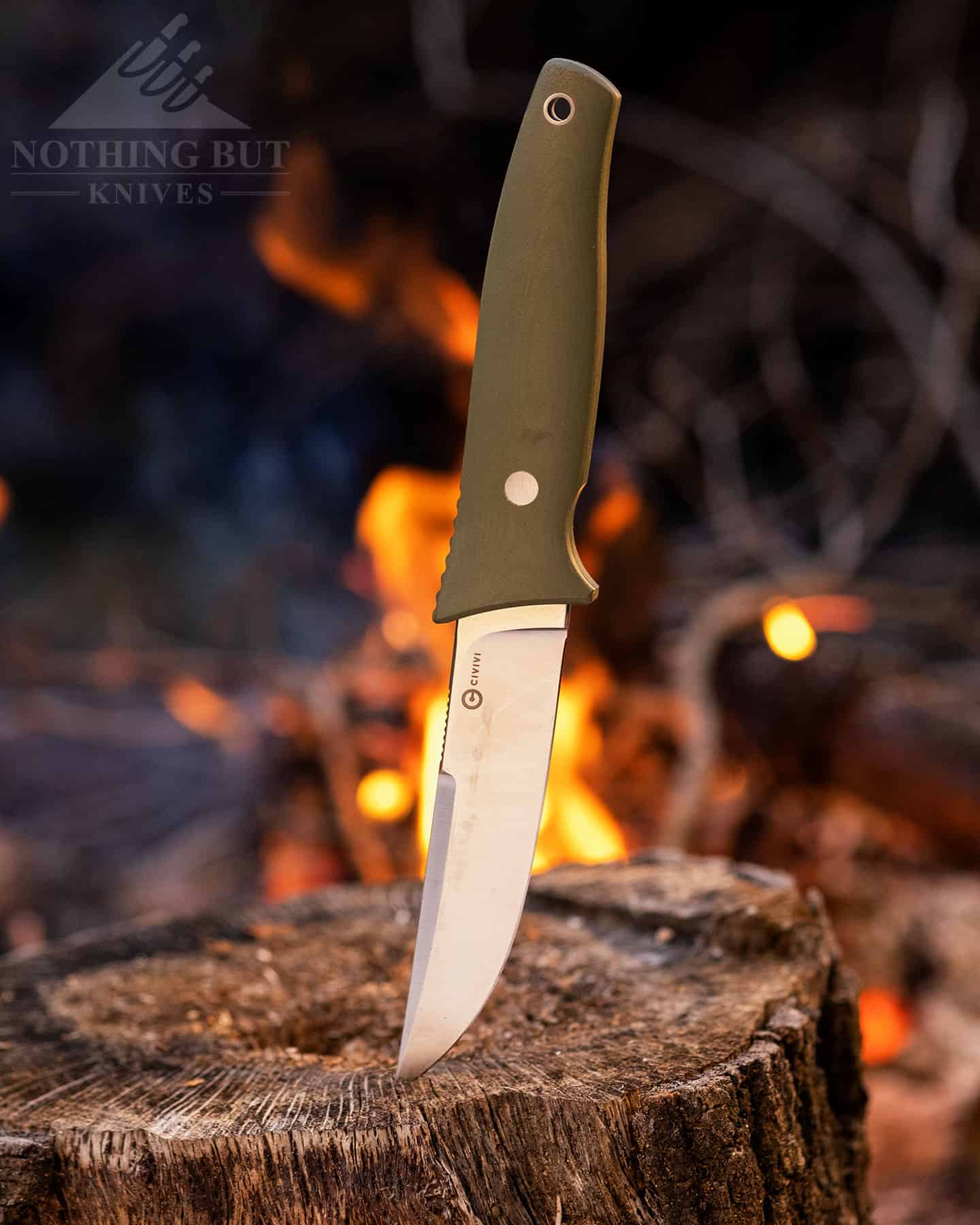
| Overall Length: | 8.8” |
| Blade Length: | 4.73” |
| Blade Steel: | D2 |
| Blade Style: | Trailing point |
| Blade Grind: | Flat |
| Handle Material: | G10 |
| Sheath: | Kydex w/ T-Clip |
| Made in: | China |
This Terzuola-designed knife can pack a big punch for being so light.
It’s a great slicer with decent edge retention, and it performs all around exceedingly well for the price it usually goes for. It won Best Factory Tactical Knife and Best in Show Factory Knife at Blade Show West 2021, but we had a fine time using it as a camping knife.
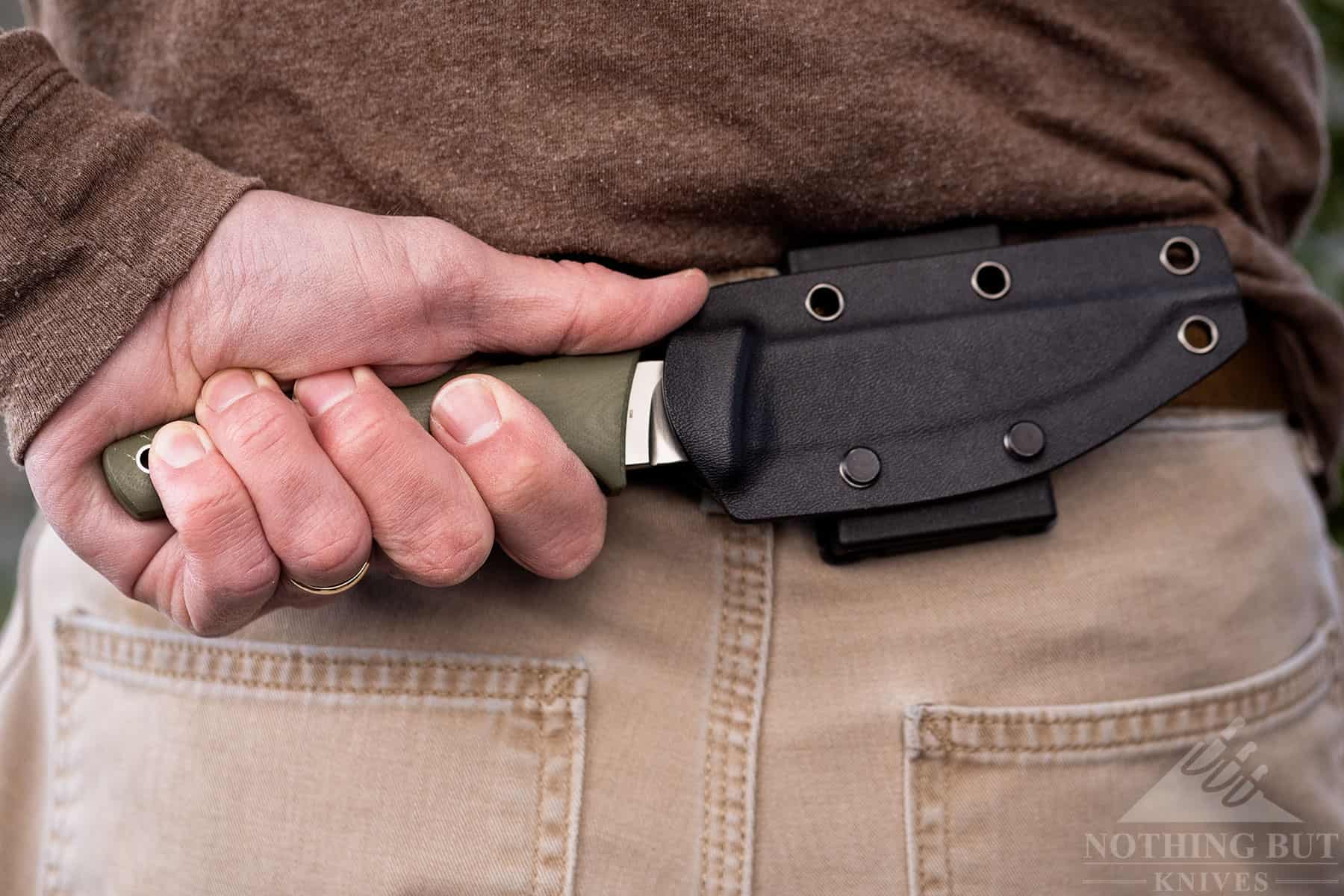
About the Sheath
The belt-carry experience with this is much the same as any other Civivi fixed blade.
The retention is on point, and the T-Clip (also designed by Bob Terzuola) makes it easy to switch between vertical and horizontal positions, and carry on just about any kind of belt or strap.
The shape of this knife and the way it seats does leave about five-and-a-half inches to one side of the clip, so the balance can feel a little weird. But you can adjust the clip inside to hold tighter to the belt, and the Tamashii is light enough that you won’t feel that handle-heavy balance after a while.
Check out our full review of the Tamashii here.
CRKT SiWi
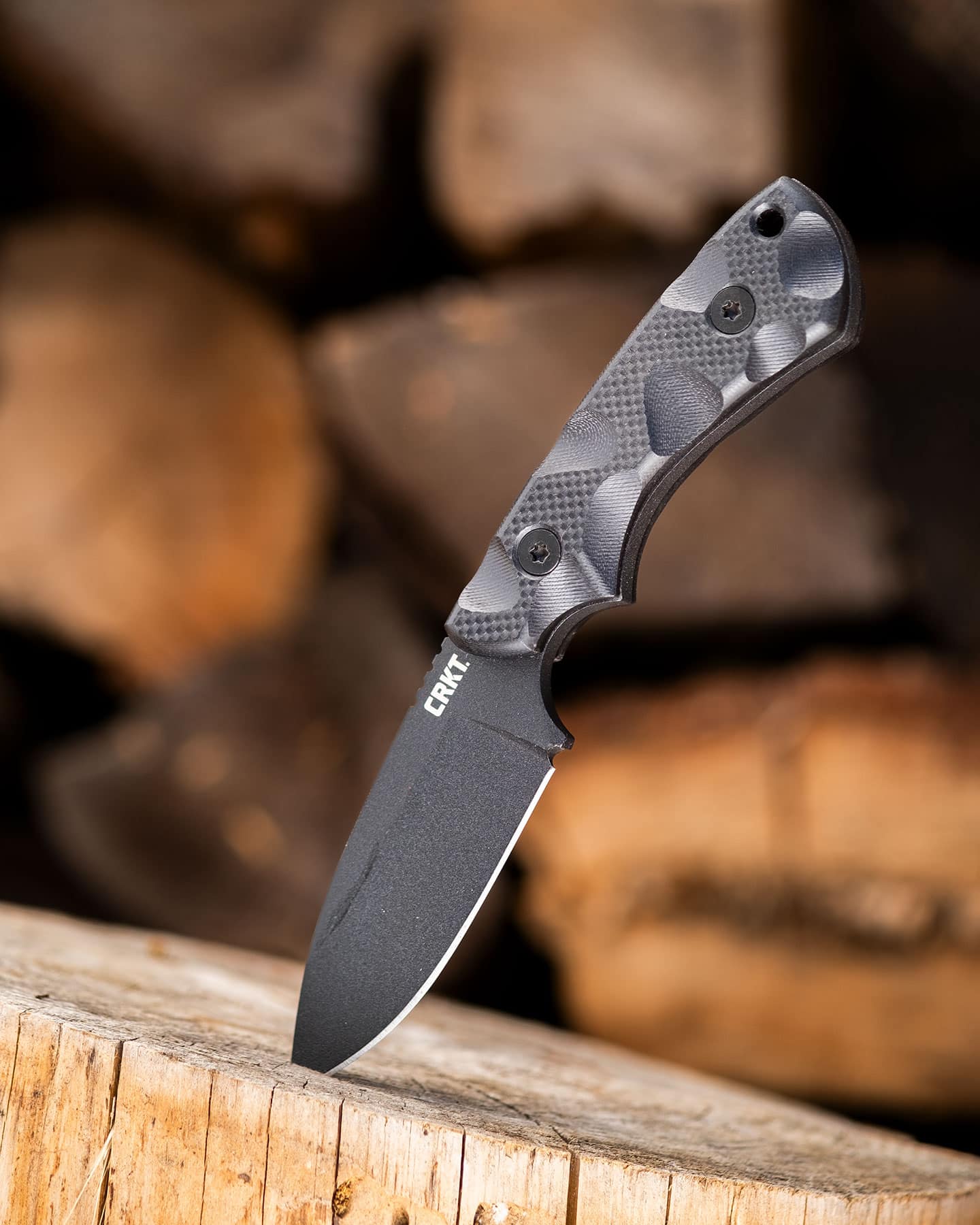
| Overall Length: | 7.25″ |
| Blade Length: | 3.34″ |
| Blade Steel: | SK5 |
| Blade Style: | Drop point |
| Blade Grind: | Flat |
| Handle Material: | G-10 |
| Sheath: | Polymer |
| Made in: | Taiwan |
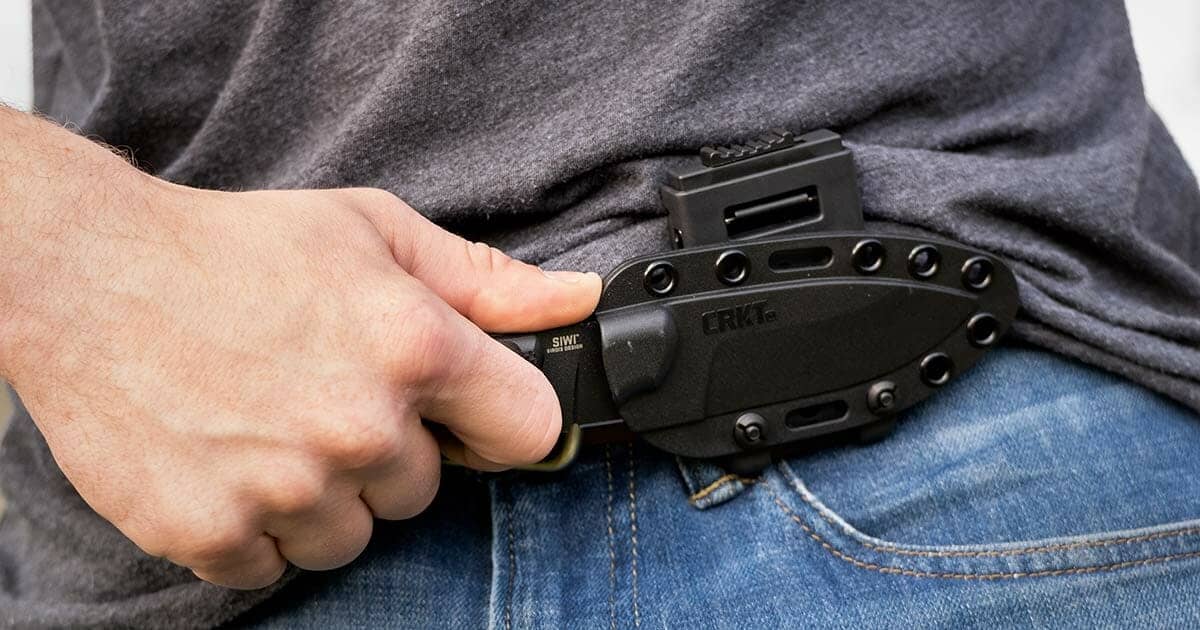
The SRKT Siwi is a result of a collaboration between knife maker Chris Williams and retired Army vet, Darrin Sirois. The end product is a small, tactical fixed blade that is a practical camping, fishing or bushcraft knife.
The overall aesthetic of the SiWi is undeniably tactical, but this knife surprised us in the field where we found it excelled as a camp knife or a backup bushcraft knife. The thick spine, tall flat grind, and super grippy handle make it an ideal outdoor tool.
About the Sheath
The SiWi ships with a Tek-Lok attachment for it’s GFN sheath.
The Tek-Lok can be attached to either side of the sheath which means the sheath can be worn right or left facing in the front or the back of the waist. However, the impressive retention of the sheath makes it an ideal option to be carried upside down on a backpack.
This above average retention does mean the SiWi requires for than a little force to remove and re insert the knife, so it takes a little practice to get the hang of it.
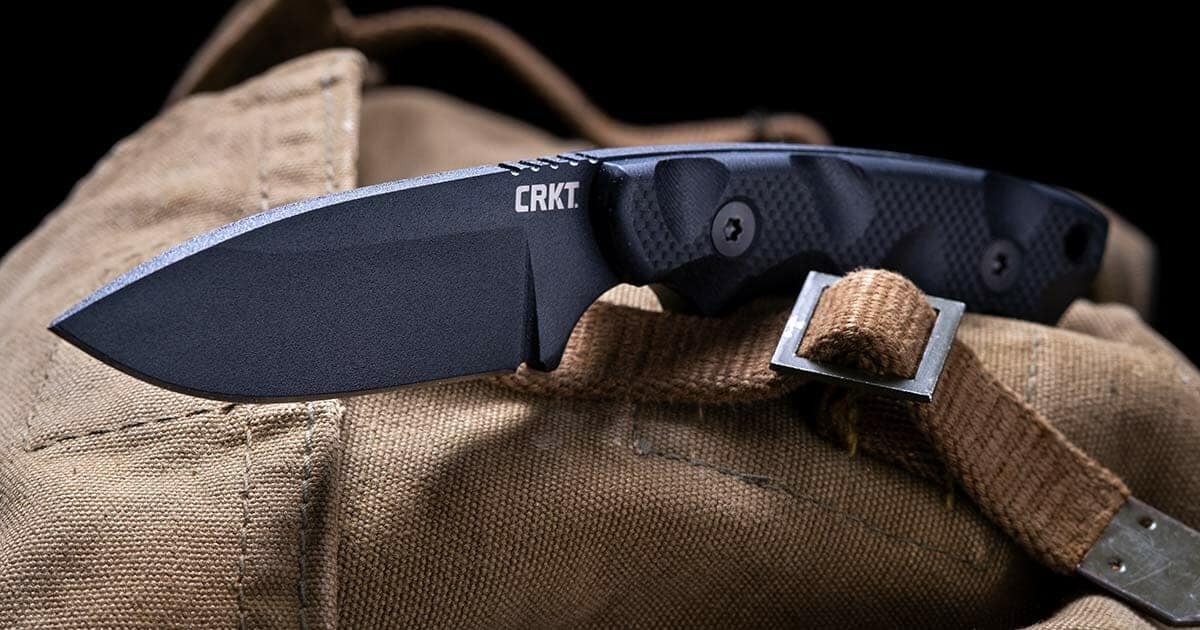
The blade of the SiWi is high carbon, so it will need to be oiled occasionally and dried anytime it gets wet to prevent corrosion. We found the edge retention of this steel to be decent, but knot great. The handle is one of the grippiest G-10 handles I have felt thanks to it’s texturing, deep choil and finger indents. This handle is easy to grip even when wet.
At it’s current price point of around $70 the SiWi offers excellent value and versatility, and it is a great compact tactical/survival knife hybrid.
Horizontal & Scout Carry Knife FAQ
What is Scout Carry?
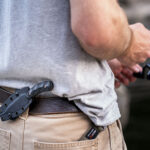
The scout carry position is when the knife sits horizontally at the small of your back.
I’ve been corrected before that a “proper” scout carry is when the knife is sitting with the handle angled slightly upward, but I’ve never found it useful to make that distinction.
What are the Benefits of the Scout Carry Position?
More than anything, the scout carry keeps the knife out of your way when you have to move through dense or rough terrain.
If you’re going to be doing any kind of crawling or climbing, having your knife tucked at your back will keep the knife from dragging along the ground or ending up underneath your body if you have to move into a prone position.
What is Cross Draw?
Cross draw is when the knife is sitting on the front of the hip opposite to your strong hand with the handle pointing toward your center line.
There’s also appendix carry, which could technically be considered the same thing. That’s when you wear it behind your waistband on the front to the right of your belly button (roughly where the appendix is).
What are the Benefits of the Cross Draw Position?
This is probably the best position for drawing the knife quickly.
The body mechanics are a lot more natural than reaching behind your back or hiking your shoulder up to draw from a vertical sheath. It’s also the easiest position for re-sheathing your knife, which not many people seem to think about, but it really improves the workflow of whatever you’re doing outdoors.
What is MOLLE?
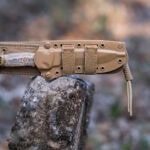
MOLLE stands for modular lightweight load-carrying equipment. Basically it’s a bunch of straps and pockets stitched to the outside of backpacks, vests, pants, and whatever other piece of clothing can take the weight.
A lot of knives that are made for horizontal carry tend to be MOLLE compatible. Usually this means you can fix the knife to a shoulder strap in an upside down vertical position, to the side of your backpack, and even horizontally over the stomach area in some cases. Not all of those positions are horizontal, but if you’re here, it’s probably because you’re looking for a way out from under the awkward tyranny of the vertical hip-carry position. You need options. MOLLE bags and vests are nothing but options.
What are the Benefits of Carrying Inside the Waistband?
It’s common for law enforcement officers to carry fixed blades this way, usually in the cross draw position, although I’ve met a few people who claim they prefer the small of the back for waistband carrying. That seems like it would add to the fuss of drawing it, but to each their own.
Our Personal Testing Method for Horizontal Carry Knives
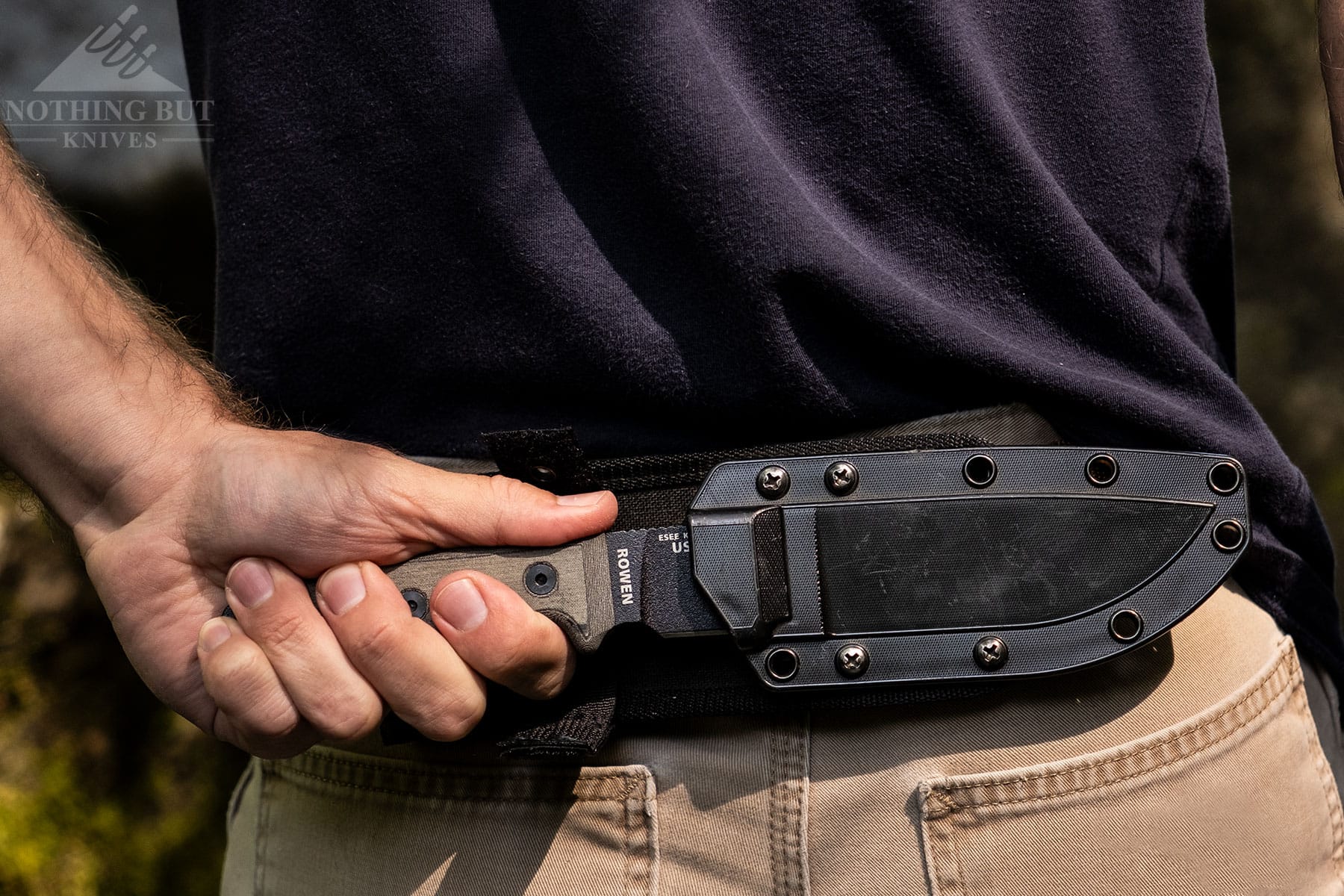
Basically any knife that feels comfortable on the belt and is easy to draw makes it on this list.
Our methods tend to change depending on what season of the year it is, but the testing process generally involves the following:
- Camping
- Hiking
- Jogging
- Climbing trees
- Swimming up a creek
- Mowing the lawn
- Tripping over rocks
- Shaking our fists at the neighbor kids
- Sitting on couches
- Eating BBQ
- Shopping for groceries
- Tying our shoes
- And generally existing in a way that doesn’t involve the handle of our belt-carry knife jabbing us in the ribs every other step.
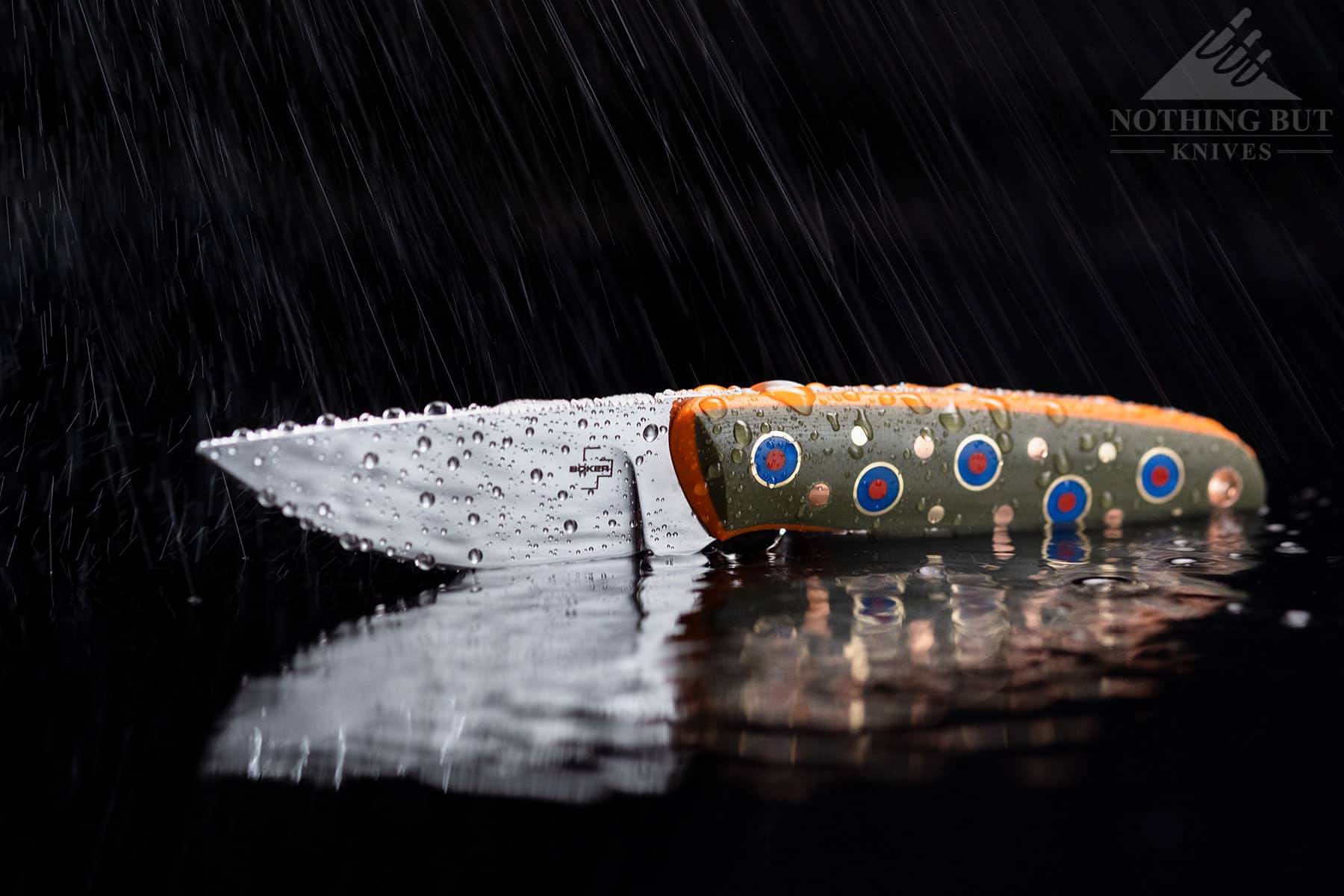
This article is updated regularly as we discover and test more fixed blade knives that can be worn in the horizontal and scout carry positions. We also remove knives once they have been discontinued and are out of stock at most major retailers. If you know of any great knives that you think should be included, please leave a comment below. Horizontal carry seems to be increasing popularity, so we expect a lot of new options from knife companies in 2024.
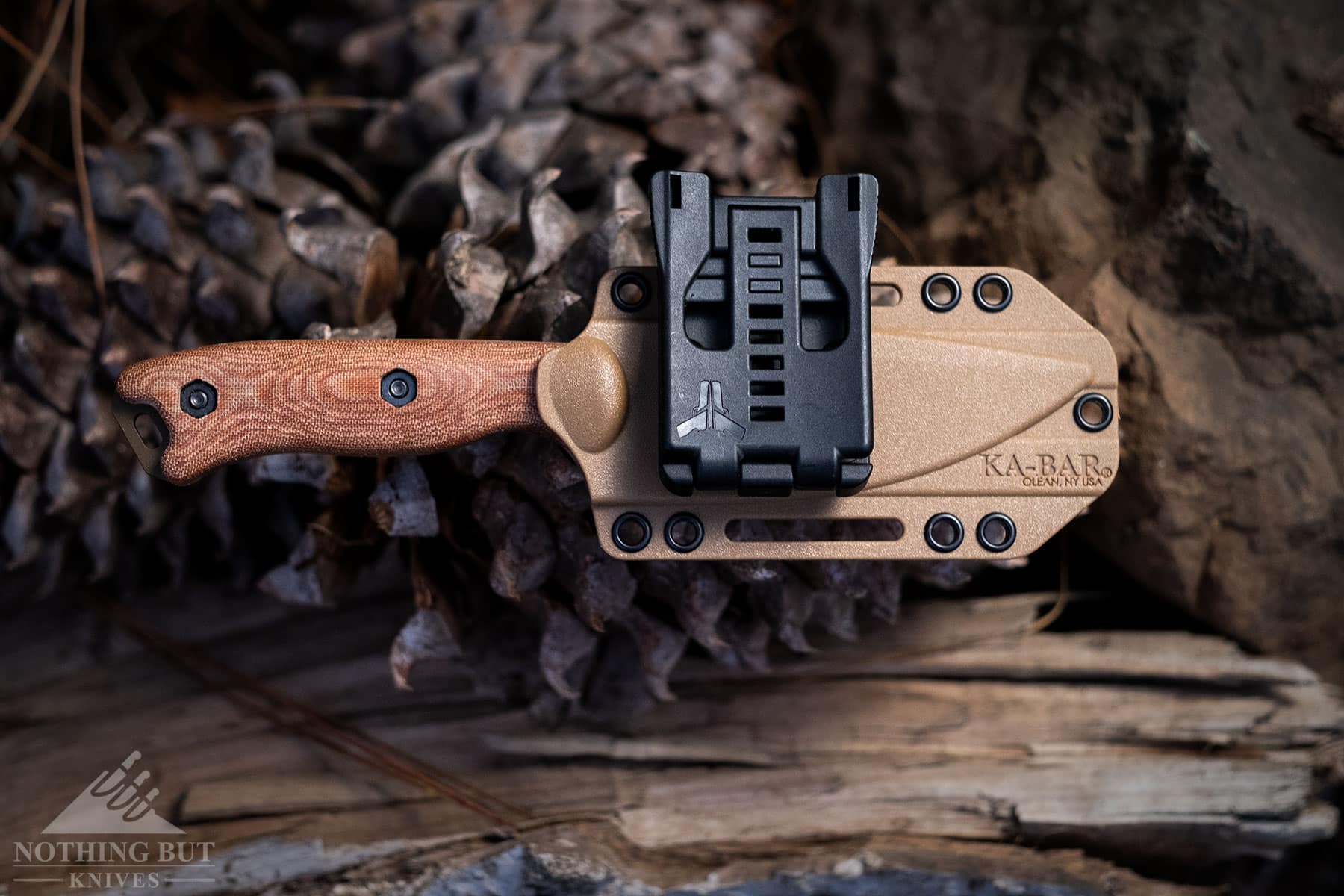
A Note on Tek Loks
While every knife I’ve put on this list should come out of the box with the ability to be carried horizontally, they are not all equal in that capacity.
It’s hard to overstate the usefulness of a Tek Lok in converting a knife to scout carry or just trying to improve the way it carries. Knives like the Kizer Little River Bowie really benefit from this kind of accessory because the manufacturer just didn’t quite put in the thought to perfect the sheath and belt clip. So a couple things about Tek Loks:
- They should be compatible with most Kydex sheaths,
- They can be adjusted to belt size with the spacers inside the clip,
- They are cheap and tough as hell.
Frankly, it’s worth getting a few Tek Loks just in case you want to play around with a new knife. If nothing else, they’re fun to play with, but at their best they completely change the way you carry your favorite knife for the better.

Hey what’s the knife and set up in the first picture on this page?
That’s the Buck Selkirk. I’m pretty sure we’re using all the stock sheath, belt clip, and ferrot rod it came with in that picture. Not sure about the belt, though. That’s easily one of our top 5 favorite knives.
If it’s horizontal carry u want them you’ve got to try the C.U.T. 4.0 from Tops, I’ve had mine for two years and I absolutely love it
It is the Buck Selkirk.
Can you recommend a tactical knife for horizontal carry that supports left-hand deployment?
Do you guys make a horizontal sheath for an elk ridge Fixed Blade Knife •9.5″ Overall •440 Stainless Steel Blade With Double Blood Groove
We don’t actually make anything (yet); we just provide colorful commentary. I know there are a lot of shops that do custom-made kydex sheaths, but I’m hesitant to recommend a site since I’ve never ordered a custom sheath from someone online.
About 15 yrs ago I screwed up and lent a matched pair of knives to a friend’s kid who was going on a backpacking trip in Patagonia…I am still waiting for their return.
They weren’t fancy and I paid around $10-$15 dollars for them in a pawn shop in Colorado Springs when I was stationed at Fort Carson in the early eighties.
They were made out of piece of steel about a quarter of inch thick, eight inches long, the blade was 4 1/2 inches long w/the center ridge down the center of the blade to where the point starts to form(about three inches from the hilt). They were dual edge with a hole about a half inch from the back of the handle and the blade looked kinda stubby.
They came with nylon horizontal sheath made so about an inch of each knife would stick out of each side so that you could pull a knife out of either side while either of your hands were otherwise occupied.
You wouldn’t believe how many times I have reached back to grab one of them only to end up digging my pocket knife out to cut, pull or pry and otherwise abuse.
If anyone knows where I can get a couple of replacement knives, please drop me a line.
Thanks Bill
I’m not sure what knives those were, Bill. They sound like they daggers, and I’m pretty curious to find out who makes daggers in nylon horizontal carry sheaths.
As far as replacing, it’s tough to find a good fixed blade near the $10 – 15 range, but in terms of style your best bet might be the Buck 245 or the Esee 4. If you want another scout carry in a similar price range there’s the Camillus Les Stroud. But Schrade makes a lot of decent fixed blades on the cheaper side as well. The SCHF31 is pretty good and it comes in a kydex sheath you can convert to horizontal with a Tek Lok.
I can’t think of anything closer to what you described, though. I’ll have to keep an eye out.
your waiting on the kids return? dang the knife must not have protected him .
That sounds like the United Cutlery Special Agent Daggers. They have been discontinued for some time, I think.
might try these https://www.amazon.com/DOUBLE-DEFENSE-Tactical-DAGGER-SHEATH/dp/B079QGJGYM
as a replacement
Take a look at the Southern Grind Jackal Pup for an addition to your list….It is small and has a rather different blade shape. Around $130 at BHQ
Thanks for the tip, David. Looks like a cool knife. We will check it out.
Check out CRKT’s “HUNT’NFISCH” a great little EDC come with a fine leather cross carry sheath…wearable anywhere. Had mine now for four years. love it
Thanks for the heads up on that knife, Tom. It looks really cool. So cool that it is out of stock everywhere. We will buy it and test it out as soon as we can get our hands on it.
Have you guys considered the Benchmade Bushcrafter? It’s shorter in length than the Condor SBK.
I’ve heard a lot of good things about the Bushcrafter, and I’ve definitely had my eye on it with the Armatus sheath for a bit. We try to only add knives that we’ve handled personally, though, so hopefully we’ll get a chance to check it out soon.
Also, can you comment on the best way to resheath a scout carry knife? I’ve searched high and low and this is a topic that nobody covers. Thanks!
It’s a little different with every sheath, but when I’m having trouble (which is most of the time) I place either the spine or the side of the blade against the outside of the mouth of the sheath, then pull the knife along it and find the right spot by feel. In order to get really smooth with it, though, you basically just need to wear the same knife in the same set up for a long time until the angles for deploying and sheathing become part of your muscle memory.
Thank you for replying! Makes sense!
Another question for the horizontal carry brain trust. I am trying to decide between large and small Tek-Lok, G-Clip, and soft loops. There’s a tradeoff for using each of those, but I was wondering if you guys had any comments beyond the blanket recommendation to buy a large Tek-Lok. From what I’ve seen they are significantly bulkier than all three other options, although they are secure and allow for a lot of carry options. The small Tek-Lok is less bulky, with easier on/off function but inherently less security because it lacks the locking redundancy of the large. The G-Clip is very secure, slim, but has poor on/off function. Soft loops seem to be another good option being used by default by Armatus. Not sure what the negative is here. Maybe looks? I’d like to personally try them all but would also love to hear your thoughts as well. Thanks in advance!
Depends on what you’re putting it on. For smaller fixed blades, the small Tek Loks should be just fine even though the lock is much simpler. We’re always switching knives around on belts, so those are usually my favorite to deal with.
I like G-clips well enough, but they come in so many different sizes it’s hard to do a blanket recommendation. The really small ones are irritating because there’s usually at least one bolt tucked away under the belt loop.
Soft loops are on the whole the easiest to put on. The main downside to me is that they don’t really hold a knife tight to you. You’ll probably get more movement if you’re doing a lot of strenuous activity, but I’ve really liked the way knives like the Tops 3 Pointer and Condor SBK carry.
Thank you!
What is your favorite overall horizontal carry knife? The security, tightness, and design of the sheath are very important boy just the knife
Picked up a KA-BAR Hinderance and it definitely isn’t a horizontal carry out the box. The clip is not able to be turned sideways. Unfortunately the tek lok doesn’t align with the kydex sheath either. (Reading this article post purchase, was surprised to see this knife on the list as reason for comment)
Yep, you’re right. We put the Hinderer on here a while back before we’d gotten around to reviewing every knife on the list. We’d assumed it had the same sheath set up as the regular TDI.
It’s a shame. That knife would be a really cool horizontal carry.
Great review of scout carry knives. Still looking at the right one for me and my oversized keg.
Wanted to update you that I recently bought the Ka-Bar TDI Law Enforcement and they’ve got a drastically different kydex sheath now that doesn’t appear to modulate into a scout carry. Was disappointed, but still didn’t return the knive…. who does that anyway? 🙂
Again… awesome page!
Thanks a lot, Casey. Much appreciated.
Yea we had two versions of the TDI in this article. We removed the one that was no longer horizontal carry, but we will double check on the other to make sure we are linked to the right version.
You should add the TDI Investigator
My newest fixed blade is the Shrade SCHF15, Horizontal sheath. Tactical tanto, love the grip. I’ve been a Shrade fan since I was 12 n bought my first uncle Henry Folder from Kittery Trading post in ME. I have Gerber, Boker, I have a flick Buck 110 I sent out but I don’t use it. I have a spring assisted Kershaw n several SOG knifes, Buck Skinner, but I gotta say this Shrade fixed Blade is as good a knife as I’ve owned. Sits tight in the sheath grip is really impressive, the blade finish is nice it doesn’t show scratches it goes from my back to the down tube on my Harley in 5 seconds. Hope I never use it in that way but it’s there.
That sounds pretty sweet, and it looks pretty much like a tanto version of the SCHF57. Schrade definitely has something figured when it comes to these small, cost efficient fixed blades.
Check out White River Knife and Tool, their Firecraft 3.5, Knucklehead II and M1. All are fantastic knives, albeit a bit expensive and they come with kydex sheaths that can be mounted horizontal, vertical, angled, etc. Amazing quality, USA made. They have plenty of other blades but these are the ones I own and really enjoy carrying.
BTW, your article is hilarious! I enjoyed it.
Glad you enjoyed it, Ed.
That M1 has come across my radar a couple times, but it seems like White River knives go out of stock every time I blink. I definitely like the look the of the sheath, though. Hopefully I’ll get a chance to check it out soon.
Take a look at the Tops Street Scalpel 2 for scout carry. Great small defense blade!
Thanks for the heads up on this one, James. We will check it out.
You’ve got to include the Half Face Blades!
Andrew Arrabito seems like a good designer, and that scene from The Terminal List with the Karambito was pretty cool, but holy damn Half Face Blades is expensive. I’m sure they’re worth putting on this list, but we haven’t had the opportunity to test any of Arrabito’s work ourselves. Maybe some day.
Thanks for sharing this list! I love how you went into details for each horizontal carry knife. Just a question, which of these works well for Benchmade knives?
I’m not sure what you mean, especially with you linking your name to a Benchmade folder on your store’s site.
Either way, I don’t know what works well with Benchmade knives. I don’t really use them because my mother loved me.
Hey man! Great pieces good article! Been carrying back draw since I was 16! You definitely gotta include TKell knives in the next one you make. SUPER good blades made from 1085 steel. Was rockin the gerber ghost strike for about 5 years and switched to one of his blades about a year ago and have zero regrets. Lifetime warranty, great designs and really nice guy. Check ‘‘em out! Won’t be disappointed.
T.Kell Knives definitely look like they make some pretty sweet stuff.
It’s funny you mentioned the Ghostrike. We were just talking about good replacements for it now that Gerber discontinued it.
Thanks for the suggestion, Kolby.
Just noticed the OFF GRID KNIVES TRACKER X is in the reviews but not the top list. I was working on scraping this page to do some excel analysis and this error is throwing things for a loop. I’m manually skipping it for now.
Thanks for the heads up, Alex. we fixed it.
Check out the Magnate by Les George. Pricey, but you could bet your life on it in a survival situation. Nice set up for scout carry.
Great suggestion, Charles. That looks like a nice knife.
Check out the Ruike Hornet!
A carry dream!!
Thanks for the tip, Matt. we will check it out.
Great reviews and brilliant writing. Entertaining and informative
Thank you so much
Excellent article about horizontal carry.In 50+ years of carrying knives I always carry anything under a 5” blade in a crossdraw sheath.I did a lot of testing both using tactical and bushcraft knives in combat and every day use including camping and crossdraw works best for me.
Thanks for reading and taking the time to comment, Tom. Sounds like you have a ton of legit experience that led to the best option. That is the way to do it.
i just picked up the kizer begleiter myself as my first fixed blade. i was looking between it and the elementum because im a fan of both companies. so far i love it d2 steel, great feeling blade geometry, super comfortable handle. great choke up points with jimping on the blade, and a lanyard loop lol. the only thing i am not in love with is the sheath its basically the same as the harpoons sheath and i cant scout carry with my favorite deluth trading jeans rear middle belt loop is way too wide. other than that im happy with it and think it would be a great addition to this list.
https://www.bladehq.com/item–Kizer-Begleiter-Fixed-Blade-Knife–176955
The Kizer Begleiter is a great knife. Probably one of the more comfortable fixed blades on our shelf, and we’ve actually gone back and forth about putting it on this list. I can’t remember if we decided the handle feels to long to be as comfortable on the belt, or if we said we should put it on this list and just forgot, but it’s definitely worth consideration.
I’m sold ol the Outdoor Edge Le Duck. Too bad it isn’t available anywhere. It’s not even the manufacturer website. Retailers don’t even offer back order because it’s no longer available.
Yea we are pretty bummed that is has been discontinued. We will pull it from this article soon.
I’m happy to see people still writing good stuff on the web. I have a SIWI, which I like, but the only knife I’ve scout carried is a Cudeman MT-5. They have a great multi-position leather sheath that carries well in the small of the back.
Cudeman knives look pretty sweet. Kind of like Boker’s Arbolito line, but with the kinds of sheaths you get with LionSteel knives.
I would recommend checking out a smaller knife manufacturer named Shelby Knives. It’s a small US based operation who does every step of the manufacturing in house.
SelbyKnives.com
I’ve been carrying the Severance 4 for about a year now and it’s an absolutely phenomenal knife. I love it for the scout carry, but it comes with a BladeTech Tec-loc on the kydex sheith so you can switch it around for a number of different carries. It snaps into the kydex firmly enough you could carry however you want without worry of the knife coming loose.
The Folsom Necker is a solid model for scout carry too, but for my edc I wanted something a little larger.
The price was reasonable for the quality but it’s a pretty small company, so more popular models seem to sell out for a month or two at a time.
I was turned on to the brand when a couple Lineman friends were raving about the Selby Lineman Knife.
I think someone recommended the Selby Folsom knife to me once. That guy is definitely making some cool looking stuff, though. We’ll look into it.
Thanks for writing such great article! It helped me pick several knives for horizontal carry. I’ll be looking for more of your articles!
Thank you for writing this blog. Very helpful in making my decision to buy the Condor SBK from BladeHQ. I was looking for a large blade with large handle for scout carry and your detailed review helped me make that choice. Thank you again.
Right on, Jake. I still use mine on a regular basis and love it. Thanks for hanging out on our site.